Early Views of Cahuenga Pass
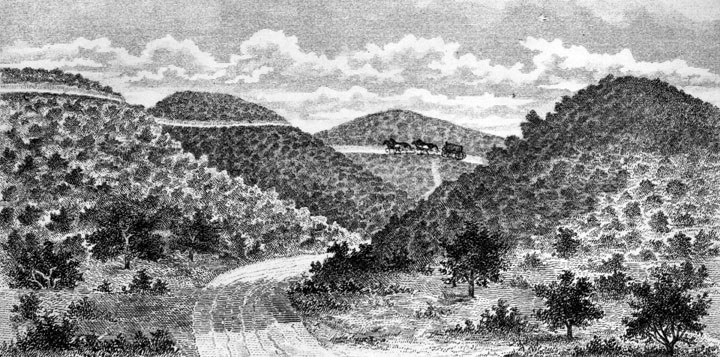 |
|
| Drawing showing an early view of the area later to become part of the Cahuenga Pass. The drawing shows a wagon pulled by horses travelling on a road through hills with the caption, "The drive to Cahuenga Vista."* |
Historical Notes The Cahuenga Pass has long been a natural shortcut between the Los Angeles Basin and the San Fernando Valley. The first people to cross it likely did so on foot thousands of years ago. By the late 1700s, villagers from the Tongva community of Cabueg-na, or Kawengna, regularly used the pass. In 1852, a steep wagon road was cut through the hills, replacing the original trail. |
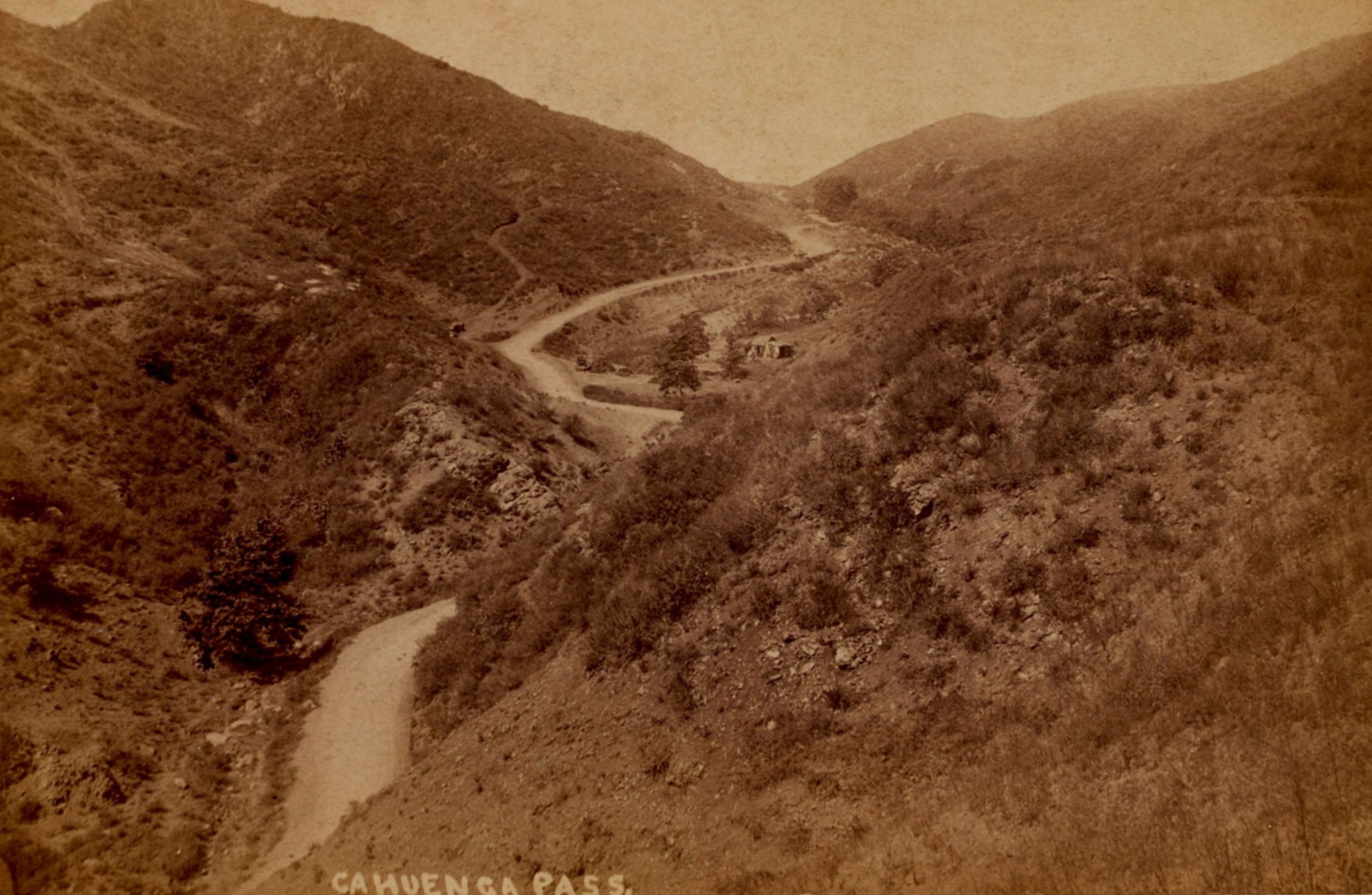 |
|
| (ca. 1888)* - Cahuenga Pass as a winding dirt road seen from the San Fernando Valley side, near present-day Universal City. A horse-drawn wagon is visible descending the road at top center, with a coach stop situated near the bend at center. Photo from the Ernest Marquez Collection. |
Historical Notes From the valley side, the pass appeared as a rough, winding road that challenged early travelers. Wagons bumped along the narrow track, surrounded by steep hills covered in chaparral. Near the summit stood the Eight Mile House, a lively roadhouse and stagecoach stop that gave food, drink, and shelter to travelers making the long trip between city and valley. |
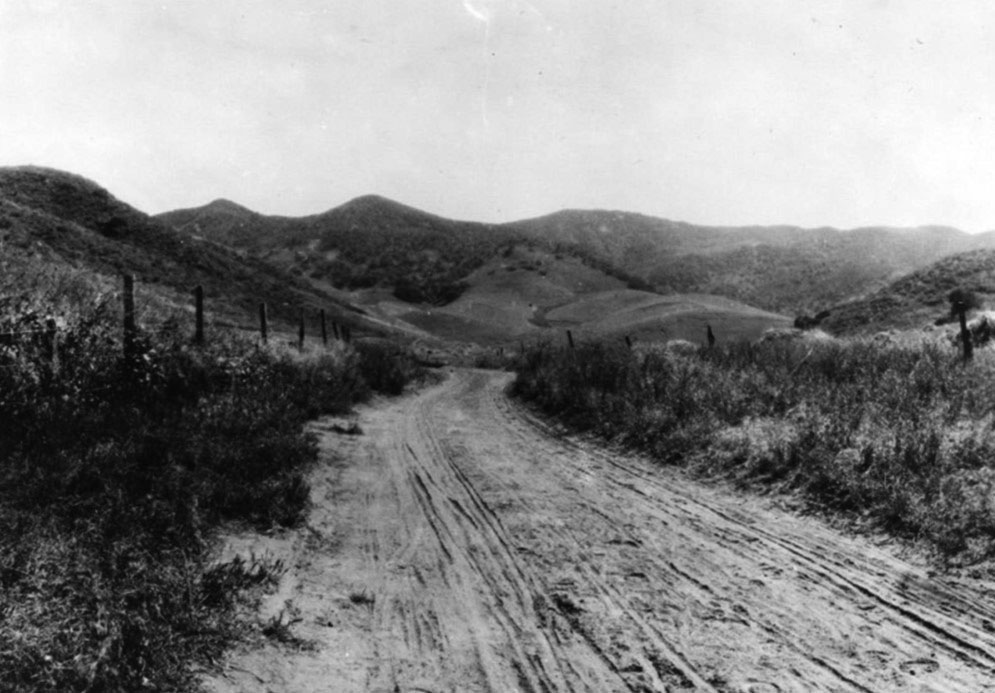 |
|
| (ca. 1890)* - A dirt road in area later to become part of the Cahuenga Pass. |
Historical Notes The pass also holds military history. Two skirmishes took place here: the 1831 Battle of Cahuenga Pass, a conflict between settlers and the Mexican governor’s men, and the 1845 Battle of Providencia, when locals fought over whether to secede from Mexico. Both took place on the valley side of the pass. Cannonballs from these battles have occasionally been found during construction projects in Studio City. |
Then and Now
 |
|
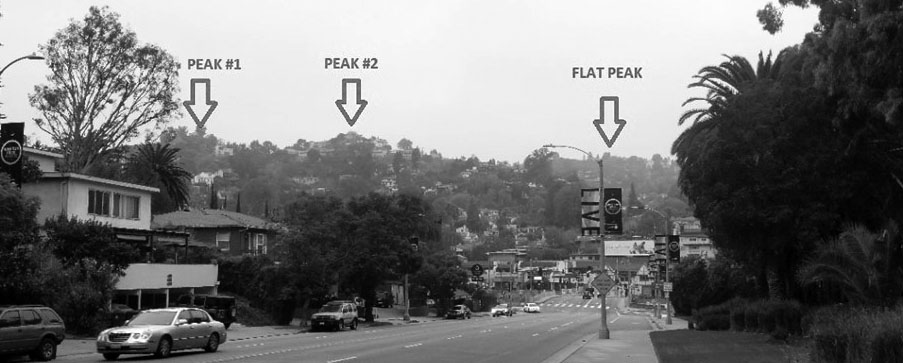 |
|
| (1890 vs. 2021) - Barham looking SW toward Cahuenga. |
Historical Notes This comparison shows how dramatically the pass has been reshaped. In 1890, travelers followed a rugged dirt road through open hills. By 2021, highways, graded boulevards, and nearby freeways had carved the land into a major transportation corridor. Yet the ridgelines in the distance remain a familiar landmark, unchanged even as the road beneath them has been lowered and widened. |
 |
|
| (1882)* - Before roads and rail lines were built, traveling through the Cahuenga Pass was by wagons and horses or on foot. This picture was taken at the summit. There is a saloon concealed among the trees. |
Historical Notes Even in its earliest days as a wagon route, the summit offered a small rest stop. A saloon hidden among eucalyptus trees served travelers, stagecoach drivers, and local ranchers. The pass itself was steep and sometimes dangerous, but these establishments made the crossing more bearable. |
 |
|
| (1882)* - View of the summit of Cahuenga Pass with a saloon, Cahuenga Tavern, situated between the tall eucalyptus trees. |
Historical Notes The name “Cahuenga” comes from the Tongva word Kawengna, meaning “place of the mountain.” By the 1880s, the name was already well known as the gateway between the valley and Los Angeles. The tavern at the summit became one of the most recognizable landmarks along the route. |
* * * * * |
Eight Mile House (aka Cahuenga Tavern or Pass Hotel)
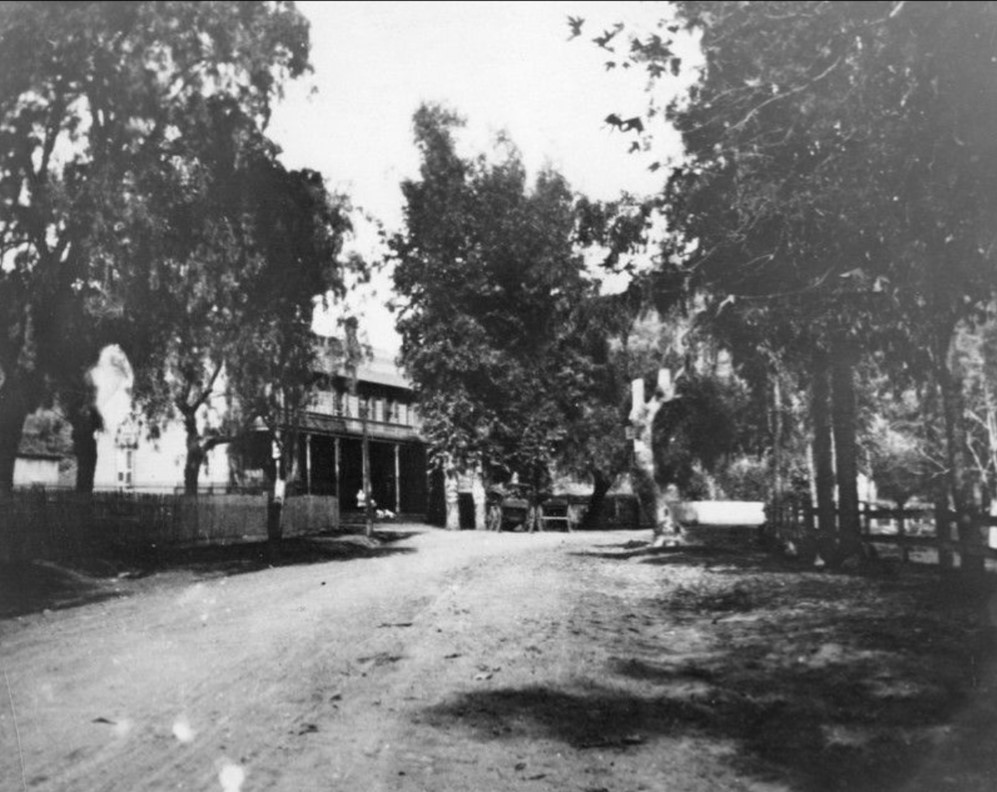 |
|
| (n.d.)* - View of Cahuenga Tavern, also known as Eight Mile House, situated between eucalyptus near the summit of Cahuenga Pass. |
Historical Notes The Eight Mile House earned its name from being eight miles from downtown Los Angeles. Built in the 1870s, it served as a toll station, store, and hotel. Travelers described it as a rough but lively spot, offering meals, drinks, and even gambling. |
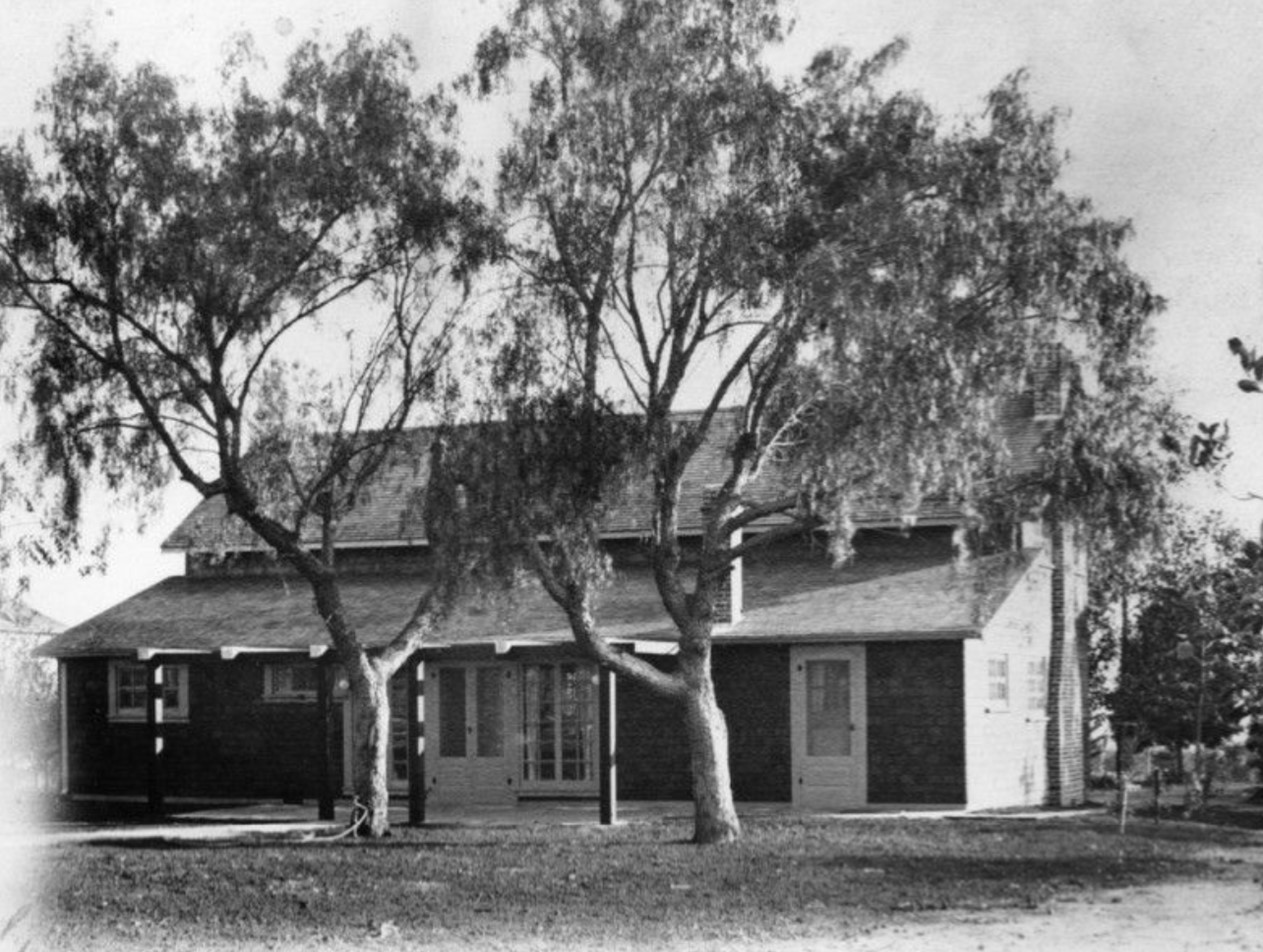 |
|
| (1905)* - Close-up view of Cahuenga Tavern. It was set back among the trees at the top of the Cahuenga Pass for those travelers going through. |
Historical Notes By the late 1800s, the tavern was an important rest stop for stagecoaches that made daily trips through the pass. Automobiles soon began to replace horse-drawn wagons, and by 1920 the old tavern was torn down as the road was widened to handle modern traffic. |
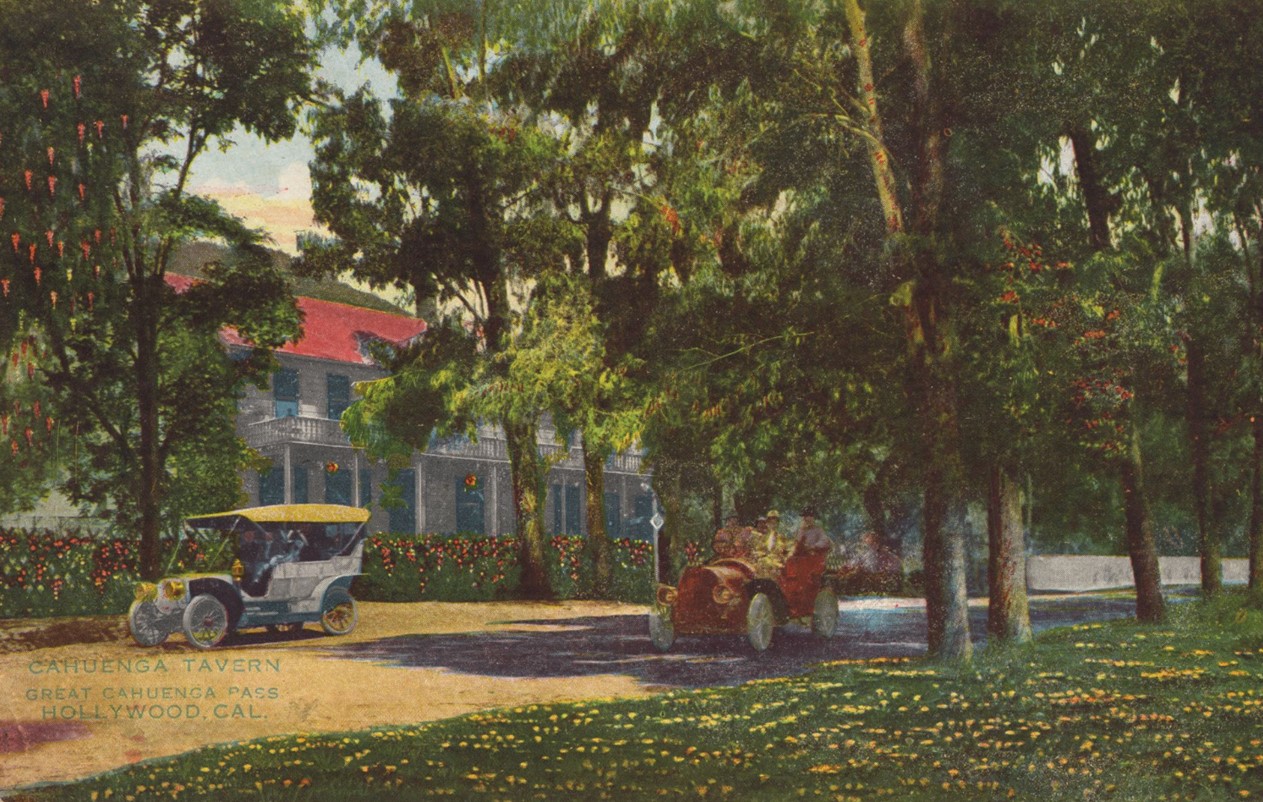 |
|
| (1908)* - Postcard view showing the Cahuenga Tavern (also known as Eight Mile House) on summit of Cahuenga Pas with two automobiles in foreground. |
Historical Notes This postcard shows how quickly travel was changing. The tavern that once welcomed horses and stagecoaches now stood beside early automobiles. Its decline mirrored the end of the stagecoach era, as Cahuenga Pass was reshaped for the age of cars. |
* * * * * |
Hazards of Early Travel through Cahuenga Pass
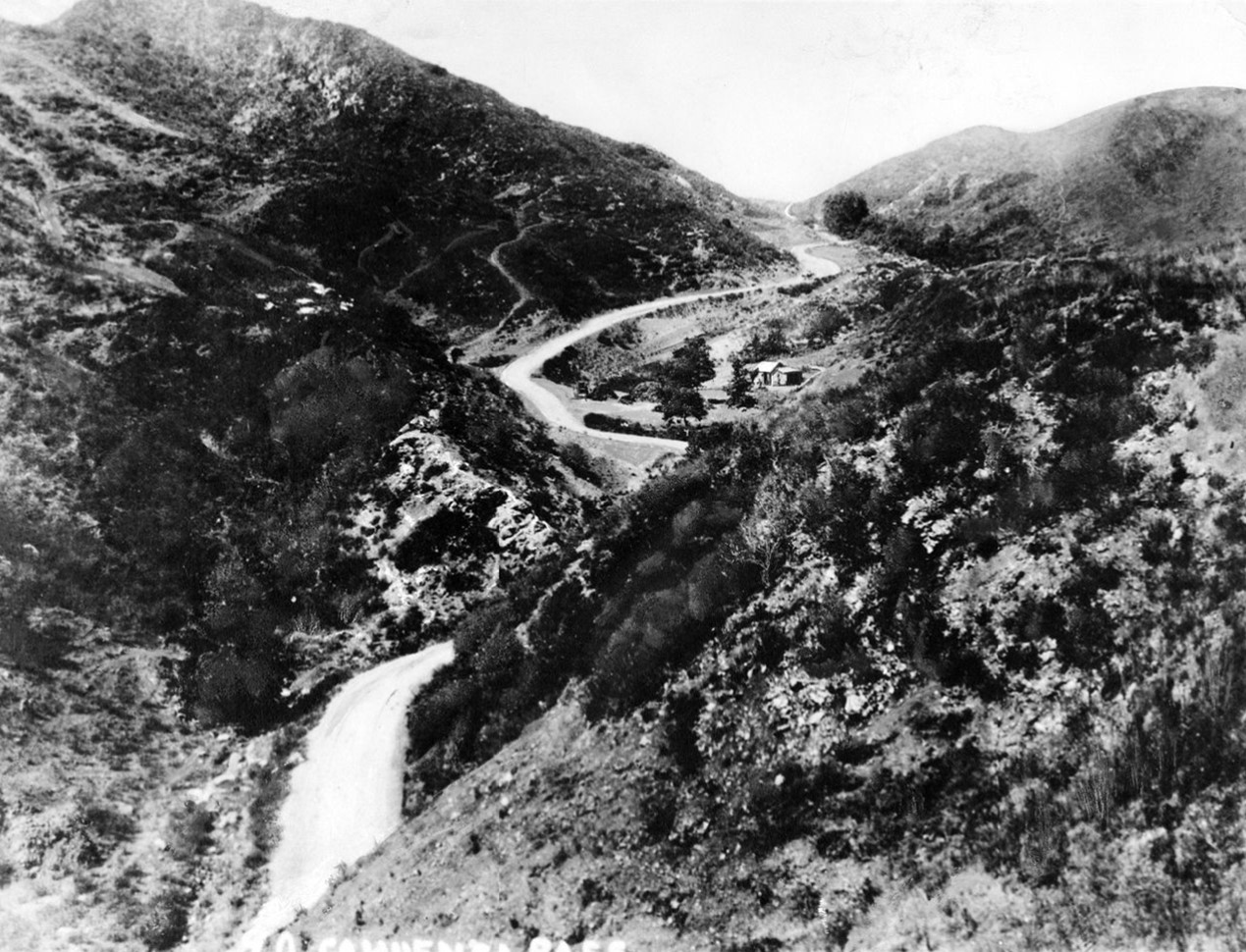 |
|
| (ca. 1888)* - High-angle view of Cahuenga Pass from near present-day Universal City, with road between mountains and stagecoach stop at right center. |
Historical Notes The narrow dirt road made travel risky. If two wagons met on the steep grades, one would have to back down to let the other pass. Storms could frighten horses, and lightning strikes were reported in the pass. The dangers were real—Miguel Leonis, a powerful landowner, was killed here. A coach stop owned by Geronimo Lopez stood nearby, offering a place to stay overnight. |
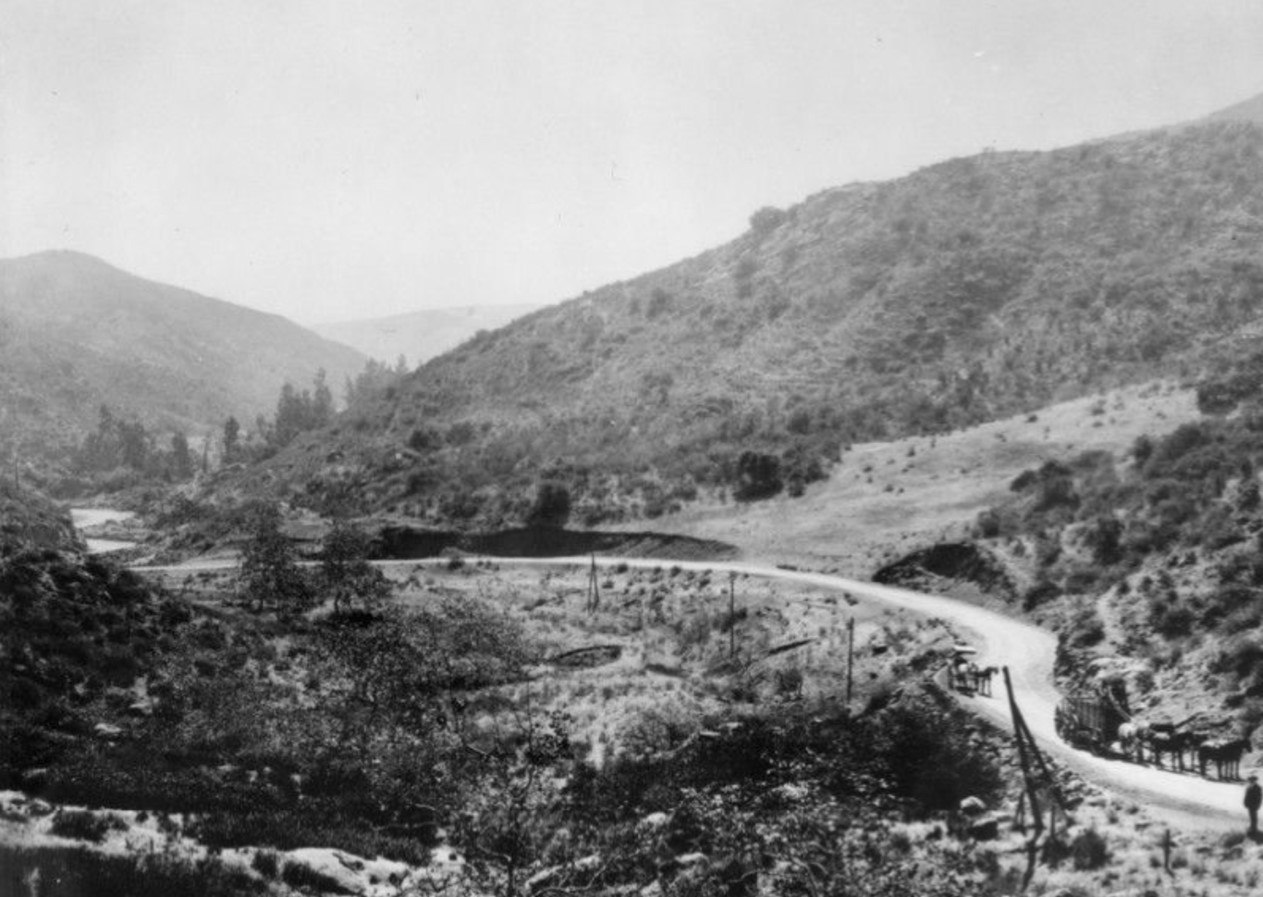 |
|
| (ca. 1894)* - Early view of area later to become part of the Cahuenga Pass. A road is visible in the photograph with what appears to be a horse-pulled buggy, and another team of horses in the lower right hand corner. |
Historical Notes By the 1890s, the pass was still a rough dirt road, but it had become a more regular route for farmers and traders traveling between the Valley and Los Angeles. Wagons and buggies picked their way along the narrow road, foreshadowing the need for the wider, modernized boulevard that would soon replace it. |
* * * * * |
Early Travel through Cahuenga Pass
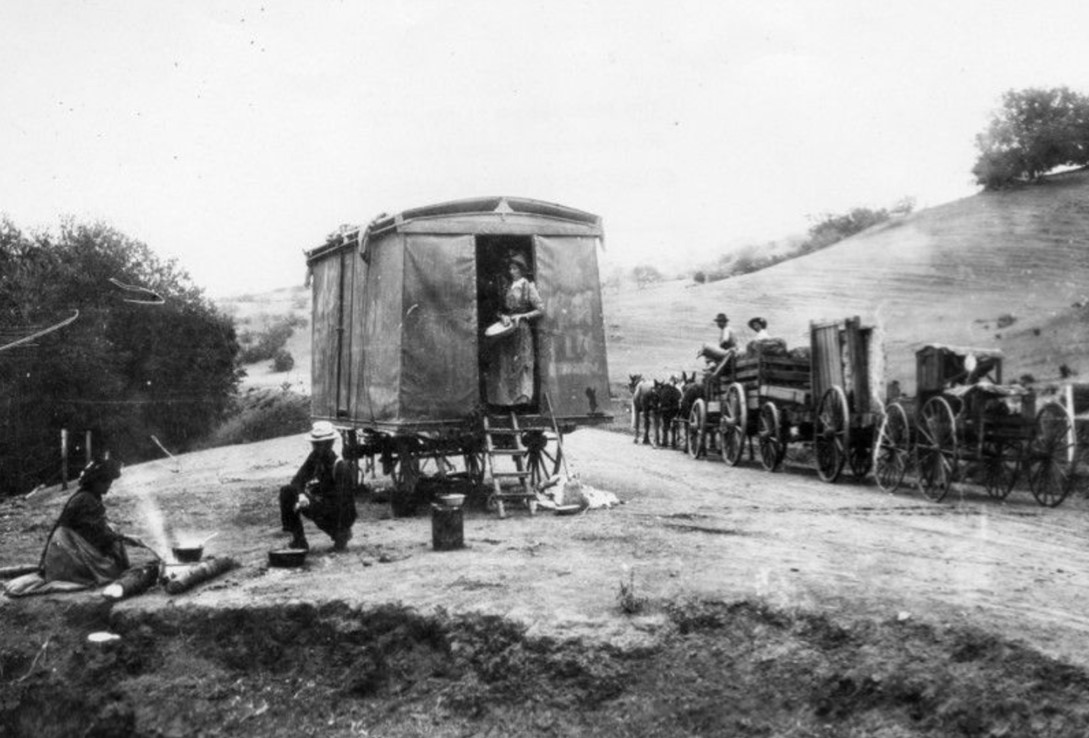 |
|
| (1892)* - Stopping to camp and cook along the journey through Cahuenga Pass. Before roads and rail lines were built, travel through the pass was by wagons and horses. |
Historical Notes During the 19th century, Cahuenga Pass saw significant development. By the 1850s, ox-carts and mule-teams were crossing the hills through the pass, and in 1858, the Butterfield Overland Mail Company stage made its first crossing. The 1870s brought the construction of the Pass Hotel, also known as Eight Mile House, which served as a toll station and store. |
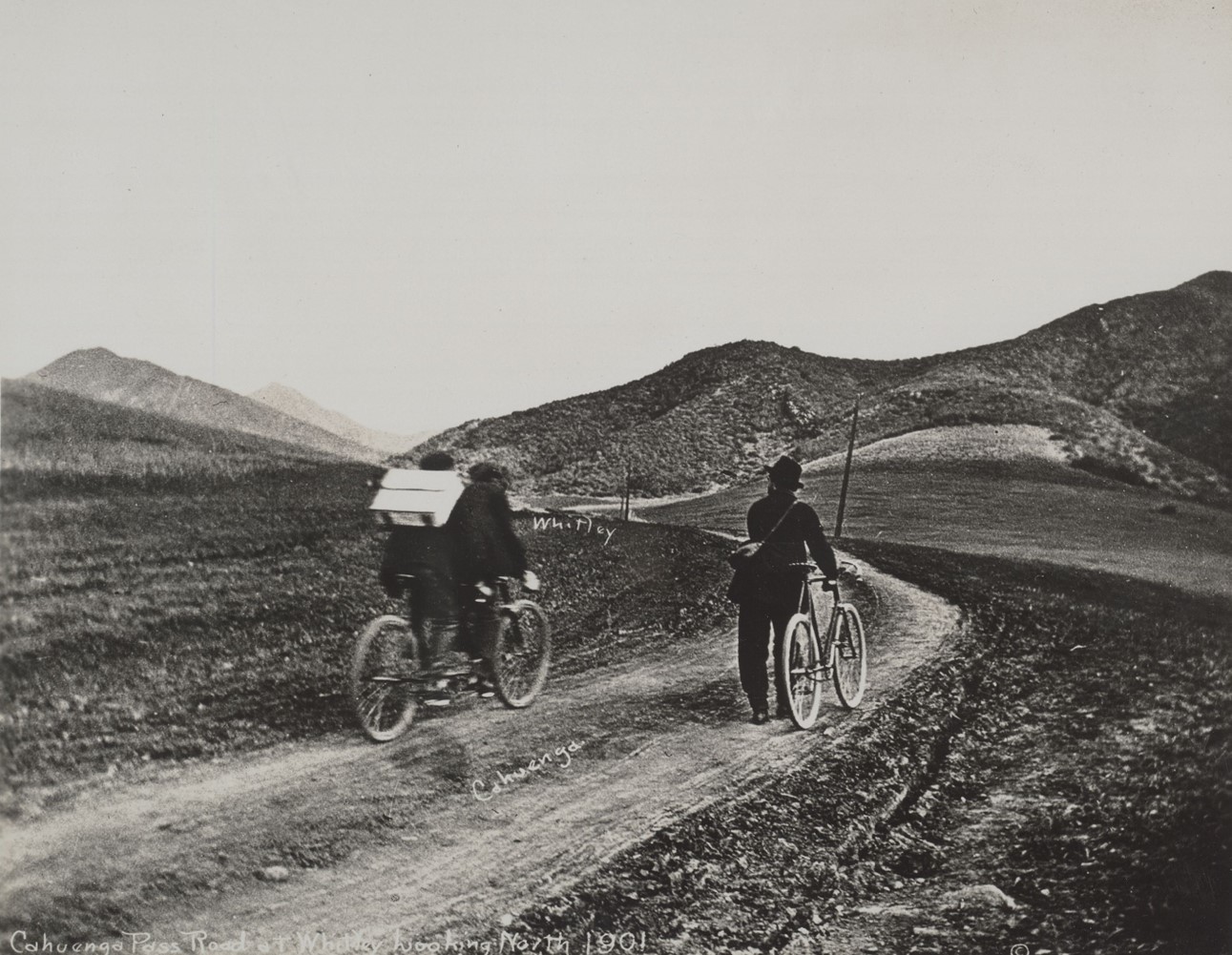 |
|
| (1901)* - Cahuenga Pass Road at Whitley looking northwest. Photo by C.C. Pierce |
Historical Notes Cycling through Cahuenga Pass around 1900 presented several challenges. The road was primarily designed for ox-carts, mule-teams making the terrain rough and uneven for cyclists. The road through the pass was continually widened to handle increasing traffic. In 1911, the Pacific Electric railway extended its tracks through the pass, and by 1920, traffic jams were common, prompting various improvement plans. |
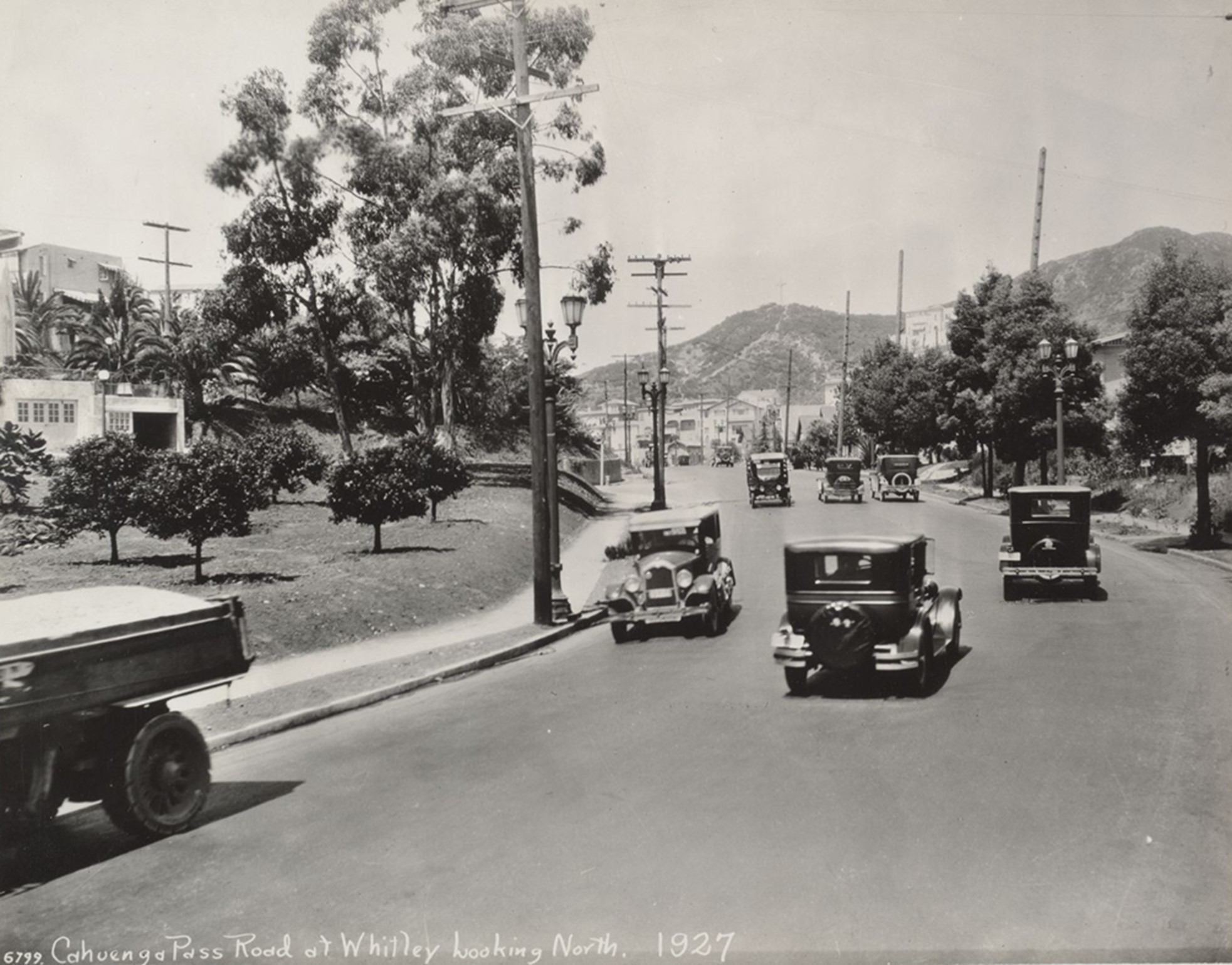 |
|
| (1927)* - Cahuenga Pass Road at Whitley looking northwest. Photo by C. C. Pierce. |
Historical Notes In 1925, the Los Angeles City Council passed Ordinance 51964, renaming Cahuenga Avenue to Cahuenga Boulevard. The ordinance justified the change by stating that Cahuenga was "a major highway, negotiating the historical Cahuenga Pass, which is the natural thoroughfare through the mountains from Hollywood to the San Fernando Valley." This renaming underscored the road's significance as a primary route connecting Hollywood to the San Fernando Valley, highlighting its essential role in the region's transportation network. |
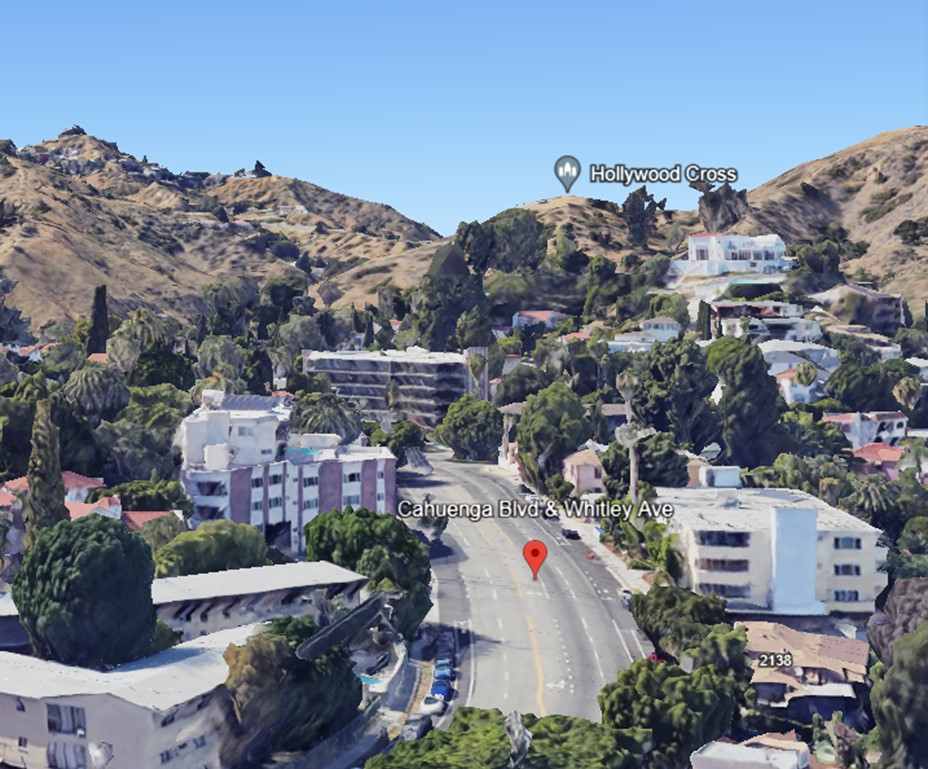 |
|
| (2022)* - Google Earth View looking northwest on Cahuenga Boulevard at Whitley Avenue. |
Historical Notes By the 2000s, Cahuenga Boulevard had become one of the busiest roads in Los Angeles, linking Hollywood to the San Fernando Valley. Even with road widenings, grading projects, and the construction of nearby freeways, the Boulevard still serves as a key route. Heavy traffic remains a daily reality, much like the congestion first noticed in the 1920s. The pass continues to be an important gateway through the Hollywood Hills. |
Before and After
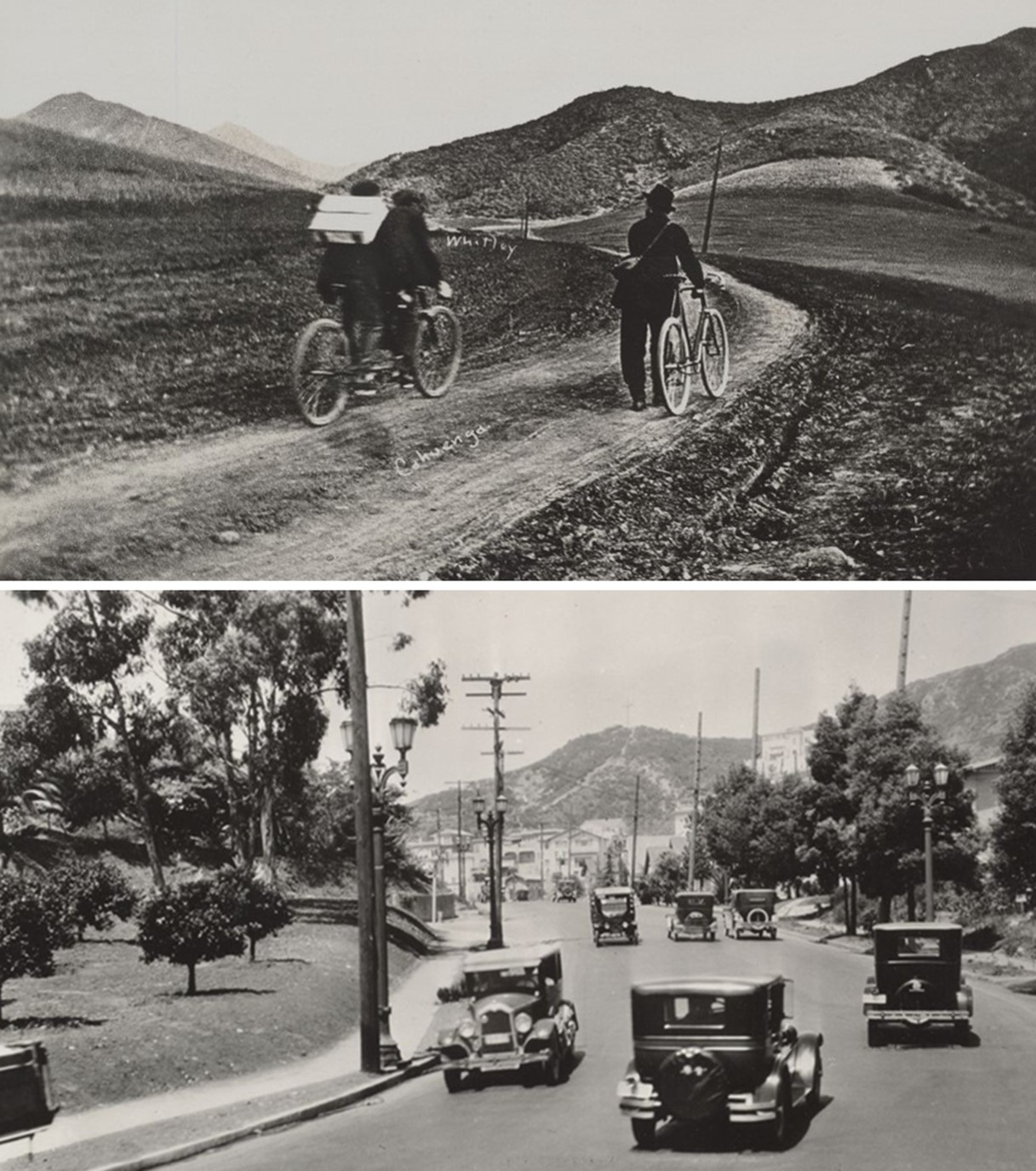 |
|
| (1901 vs. 1927)* – Looking northwest along Cahuenga Pass Road (now Cahuenga Boulevard) at Whitley in the Hollywood Hills. Over time, the road has been graded and lowered, but the ridgeline remains relatively unchanged. Photo comparison by Jack Feldman. |
Historical Notes Cahuenga Boulevard, originally known as Cahuenga Pass Road, has undergone significant transformations since its early days as a footpath through the Cahuenga Pass. In 1925, it was officially renamed from Cahuenga Avenue to Cahuenga Boulevard, reflecting its importance as a major thoroughfare connecting Hollywood to the San Fernando Valley. This change was part of a broader initiative to address growing traffic concerns in the rapidly expanding Hollywood area. |
Then and Now
 |
|
| (1901 vs. 2022)* - Looking northwest on Cahuenga Pass Road (now Cahuenga Boulevard) at Whitley in the Hollywood Hills. While the angles of the images differ and the road has been graded and lowered over time, the outline of the ridges has remained relatively unchanged. Photo comparison by Jack Feldman. |
Historical Notes These two views, taken more than a hundred years apart, show how much has changed and how much has stayed the same. The ridgeline above the road looks nearly identical, but the road itself appears to sit deeper in the landscape today. This is the result of repeated grading and excavation projects meant to lower and widen the pass for modern traffic. What began as a rough dirt trail for wagons and mule teams is now a multilane roadway carrying thousands of cars each day. The comparison highlights both the growth of Los Angeles and the role of natural geography in shaping its routes. |
* * * * * |
Cultivation and Settlement in the Pass
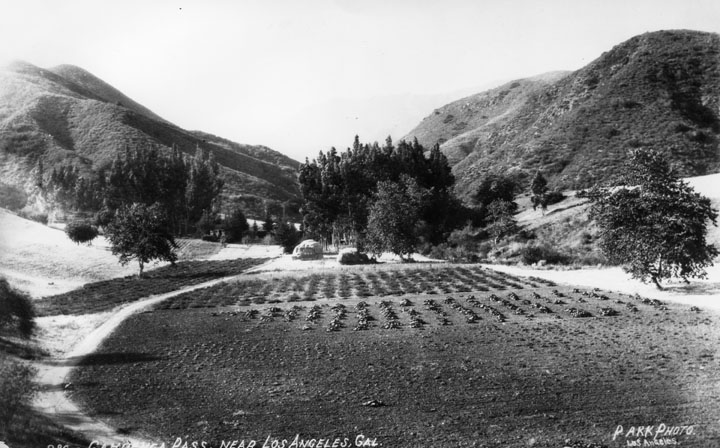 |
|
| (ca. 1903)* - View of early Cahuenga Pass as seen from the Hollywood side. The road runs around and through a cultivated area. |
Historical Notes By the early 1900s, farming activity had reached into the Cahuenga Pass, reflecting Los Angeles’ transformation from open ranch lands to cultivated fields. Small farms and homesteads emerged in the hillsides, where settlers cleared the land for crops despite the rugged terrain. These early agricultural efforts signaled both opportunity and persistence, as farmers adapted the land to support the growing city’s needs. |
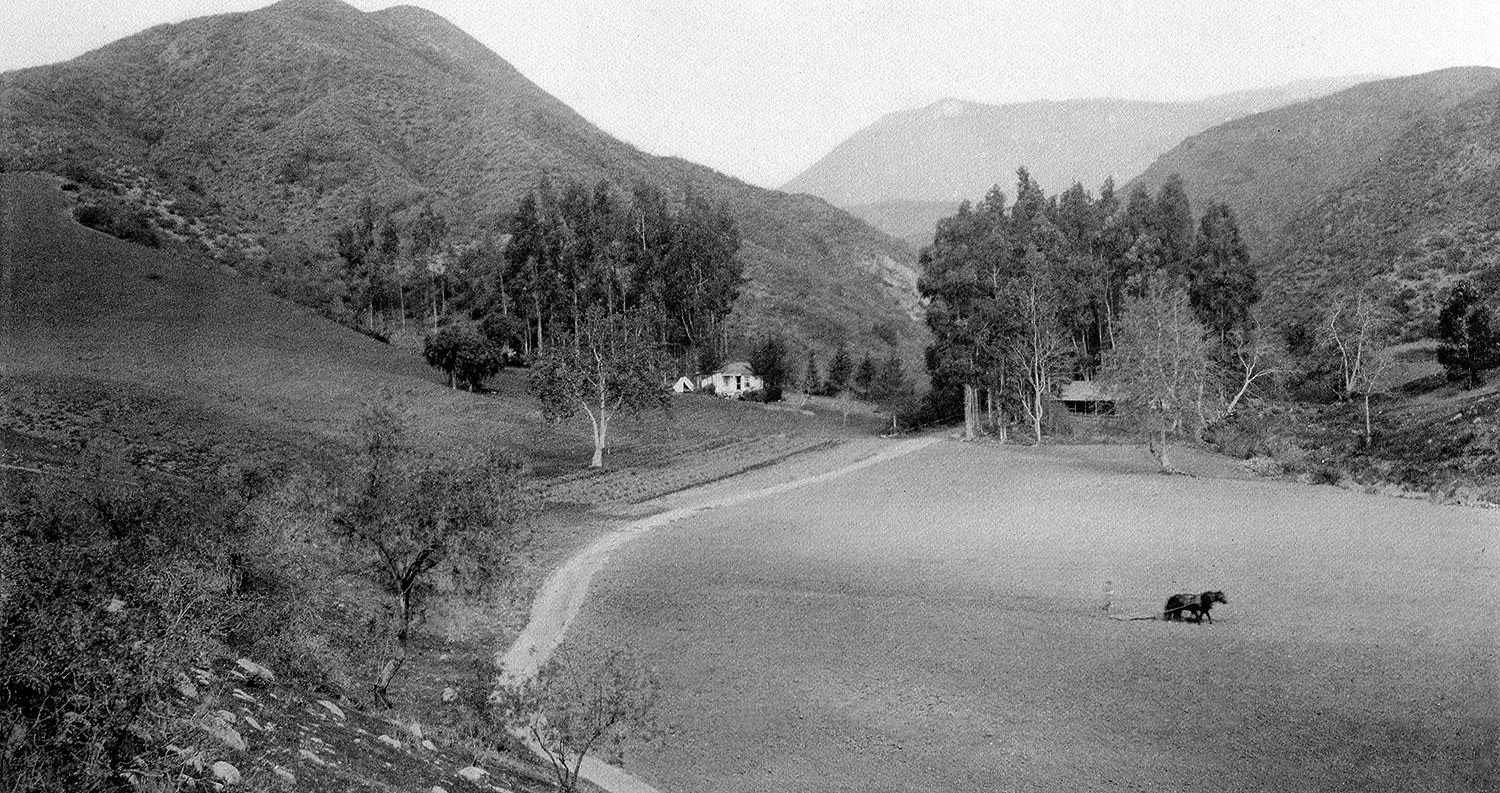 |
|
| (ca. 1905)* – Early view of Cahuenga Pass showing a farmer in his field behind a horse-drawn plow. Two structures are seen in the background. |
Historical Notes Even as Los Angeles expanded, farming remained an important part of life in the Cahuenga Pass. Fields of crops lined the road, worked by families with horse-drawn plows. As late as 1914, filmmaker Cecil B. DeMille rented a small wooden cabin in the pass, riding on horseback each day to his Hollywood studio with a revolver at his side. The mix of rural farming and the beginnings of Hollywood reflected the transition from an agricultural corridor to a cultural and transportation hub. |
 |
|
| (ca. 1905)* – Early view of Cahuenga Pass showing a farmer in his field behind a horse-drawn plow. Two structures are seen in the background. Image enhancement and colorization by Richard Holoff |
Historical Notes This enhanced and colorized image brings to life the rustic character of the Cahuenga Pass during its agricultural era. Simple farm structures and cultivated fields reveal how local residents shaped the landscape before modern roadbuilding and development transformed the area. |
* * * * * |
Roads and Faith in the Cahuenga Pass
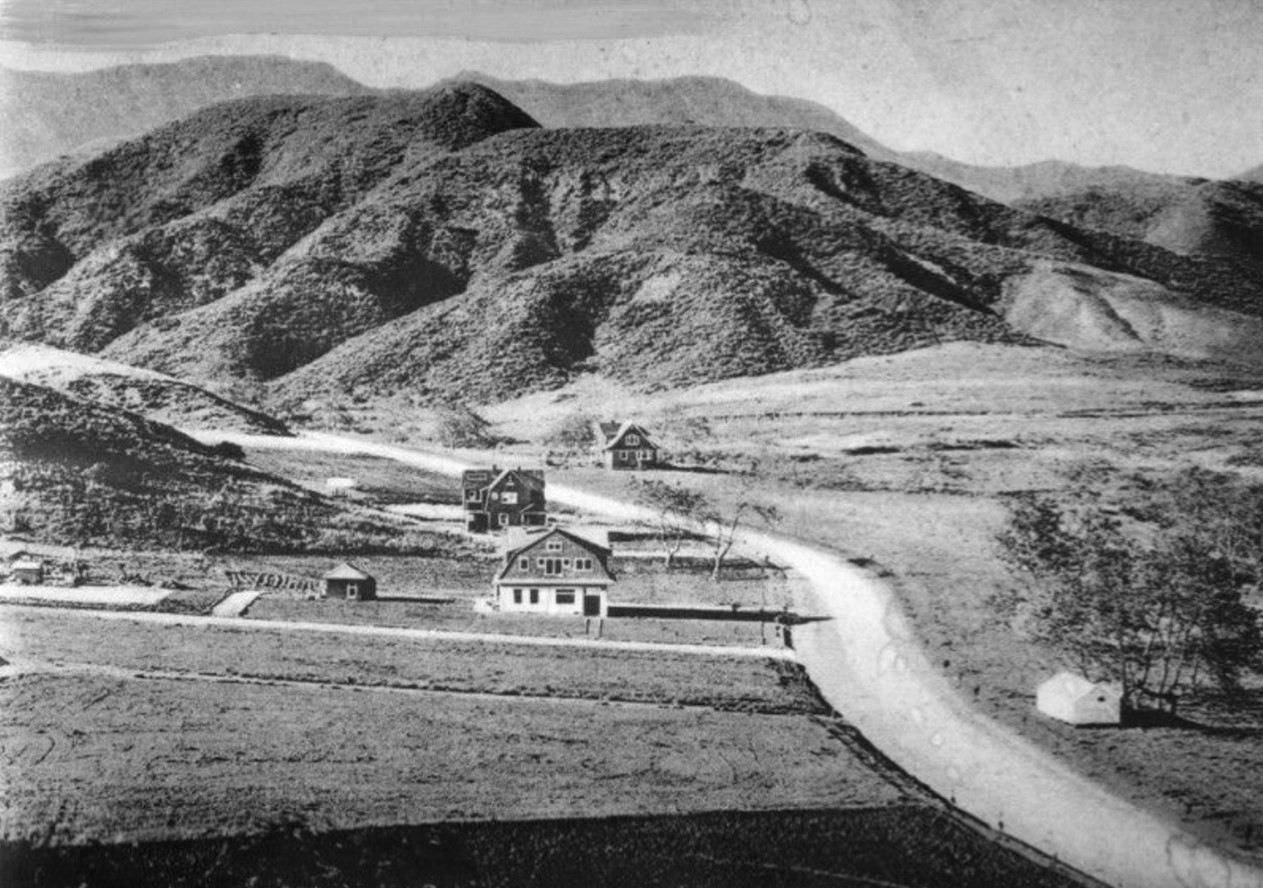 |
|
| (1906)* - Early view of Highland Avenue north of Hollywood Boulevard as it winds its way toward Cahuenga Pass. Some buildings are visible with hills in the background. |
Historical Notes This is one of the earliest known views of Highland Avenue entering the Cahuenga Pass. By this time, the road was more established, serving as a vital connection between Hollywood and the San Fernando Valley. Still unpaved, it foreshadowed the major transportation improvements soon to reshape the region. |
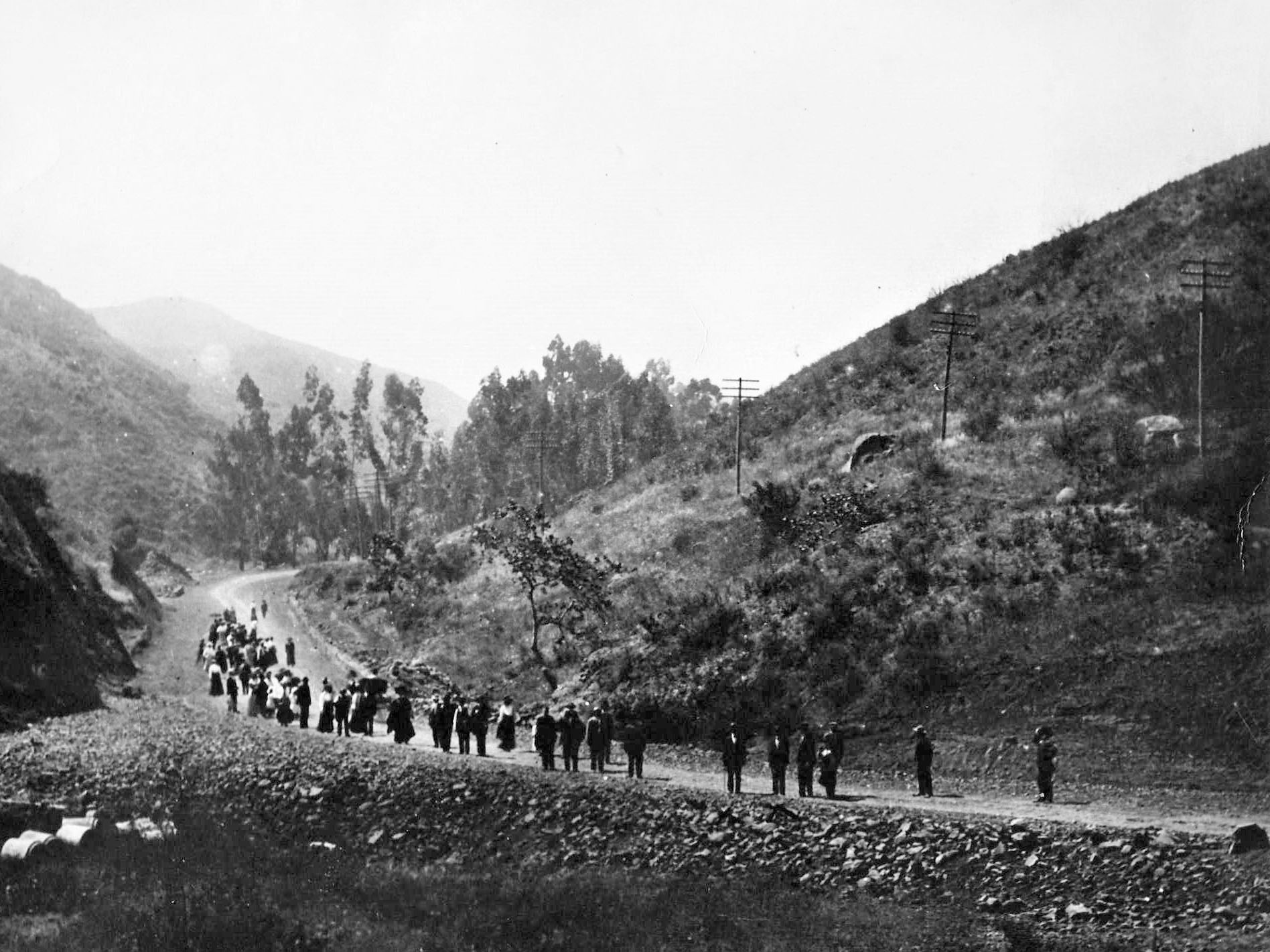 |
|
| (1910)* - Residents of the Pisgah Home in Los Angeles making their way through the Cahuenga Pass to an event at the Pisgah Gardens in Lankershim. |
Historical Notes The Pisgah Home movement, founded by faith healer and reformer Finis E. Yoakum, grew from a small Highland Park sanatorium into a far-reaching spiritual and social mission. By 1910, residents of the Pisgah Home were traveling through the Cahuenga Pass to reach Pisgah Gardens in the Valley. Their presence highlights how the pass served not only farmers and travelers, but also religious communities whose institutions spread across Los Angeles. |
* * * * * |
The Last Years of the Old Road
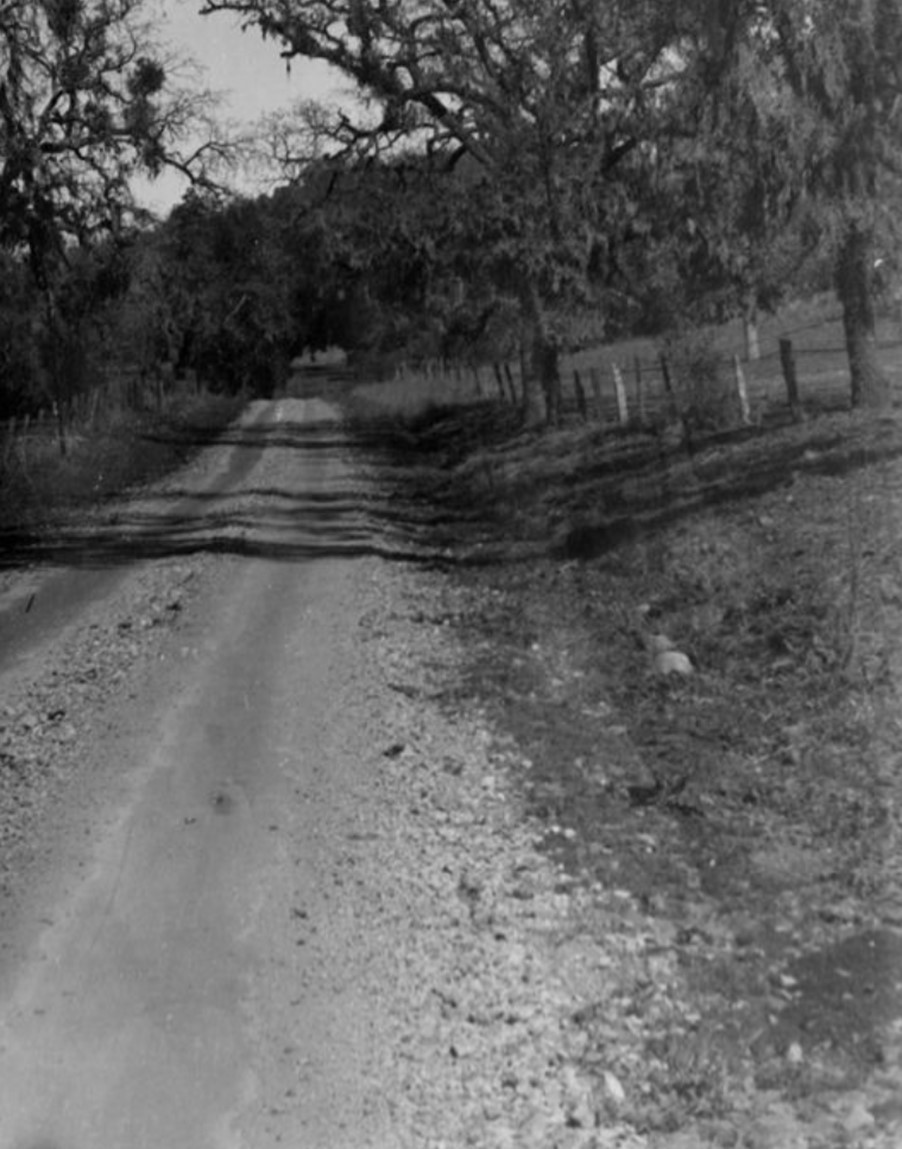 |
|
| (1913)* - Old Cahuenga Pass Road, lined with trees, with fence at right. |
Historical Notes By 1913, the Cahuenga Pass Road was still primitive, little more than a narrow dirt track through the mountains. If two horse-drawn teams met, the heavier one prevailed while the lighter team had to retreat. Travelers also faced the threat of lightning strikes on horses during storms. These dangers underscored the urgency for improvements, and within just a few years, automobiles and expanded roadways would begin to reshape the pass permanently. |
* * * * * |
Cahuenga Pass Trolley
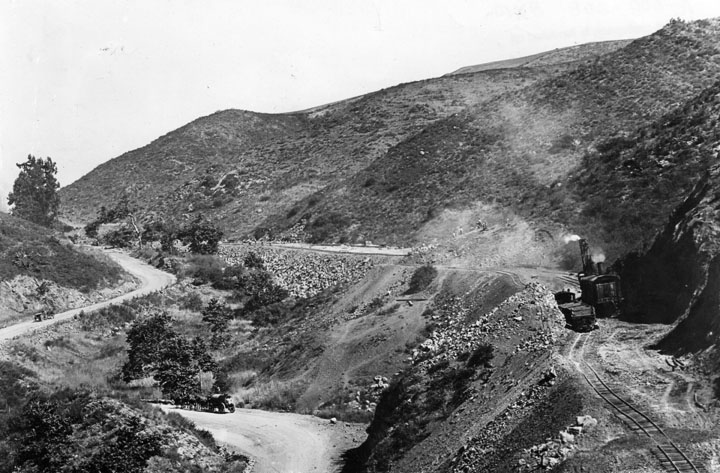 |
|
| (1911)* - Tracks are being built through the hills of the Cahuenga Pass as shown on the right side of this picture. On the lower road can be seen supplies coming and going by teams of horses and wagons |
Historical Notes In 1911, General Sherman (as he was called) added an extraordinary streetcar line. Built over Cahuenga Pass, through North Hollywood to the 1911 town site of Van Nuys, and on to the 1912 town site Owensmouth, now Canoga Park. Along with the streetcar line, Moses Sherman also built the "$500,000 boulevard" named Sherman Way next to the tracks all of which were the key to the development of the Valley. By 1912, 45 minute streetcar service from Van Nuys to downtown and the "no speed limit" paved road (if you could get your "Model A" to do 30 mph) were key selling points. |
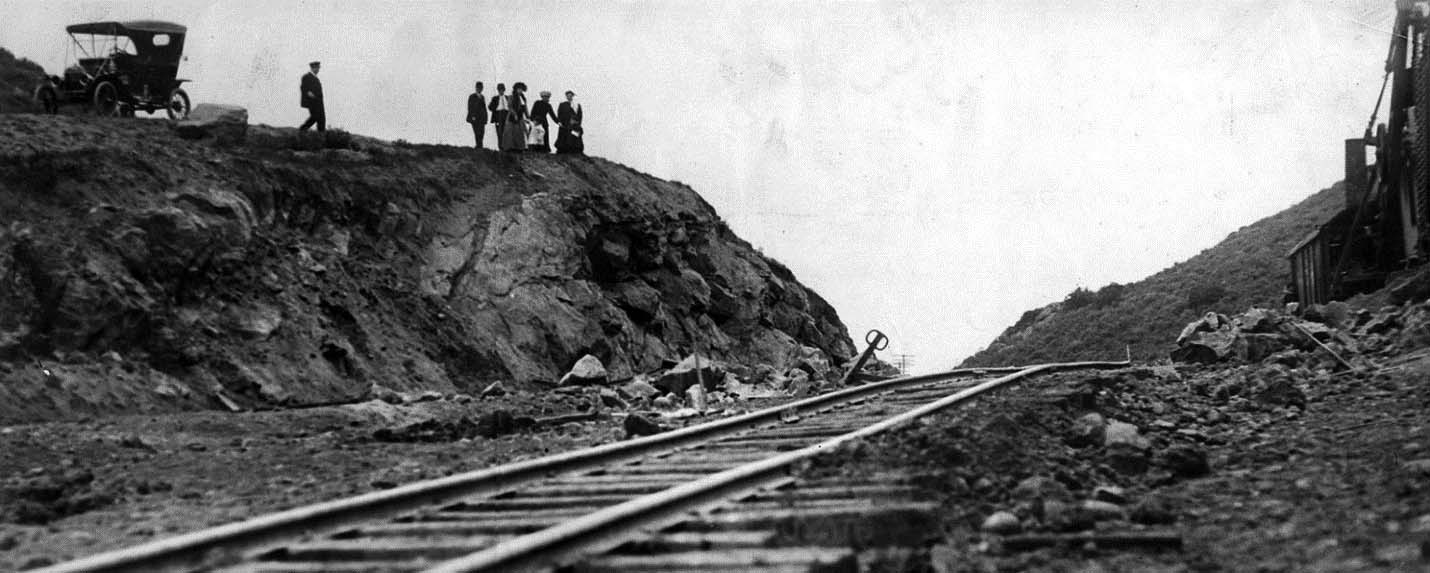 |
|
| (1911)* - Sightseers checking out the new Pacific Electric trolley line being built in the Cahuenga Pass between Hollywood and the San Fernando Valley. |
Historical Notes The original April 9, 1911, Los Angeles Times caption reported: Electric Line to Van Nuys Through Cahuenga Pass. This picture shows the railroad as now laid to the highest point in the gap which unites Hollywood with the rich San Fernando Valley. The road will be in operation early in the summer. Express trains connecting the town of Van Nuys with Los Angeles will make only one stop, Hollywood. |
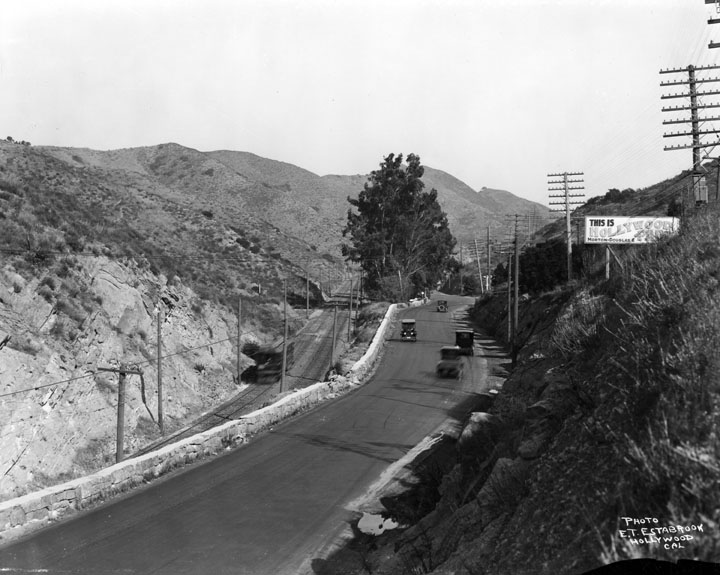 |
|
| (ca. 1920)* - Cars travel on the road past a sign reading "This is Hollywood." Below and to the left is the rail line, which also goes through the Cahuenga Pass. A trolley car is traveling on the tracks. |
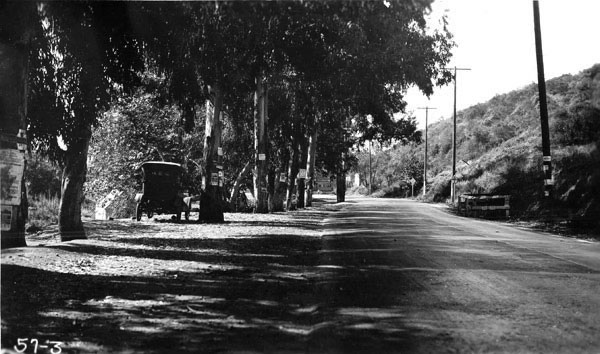 |
|
| (1921)**# - View of the highway through the Cahuenga Pass showing a car parked on the side of the road next to what appears to be a Eucalyptus tree. |
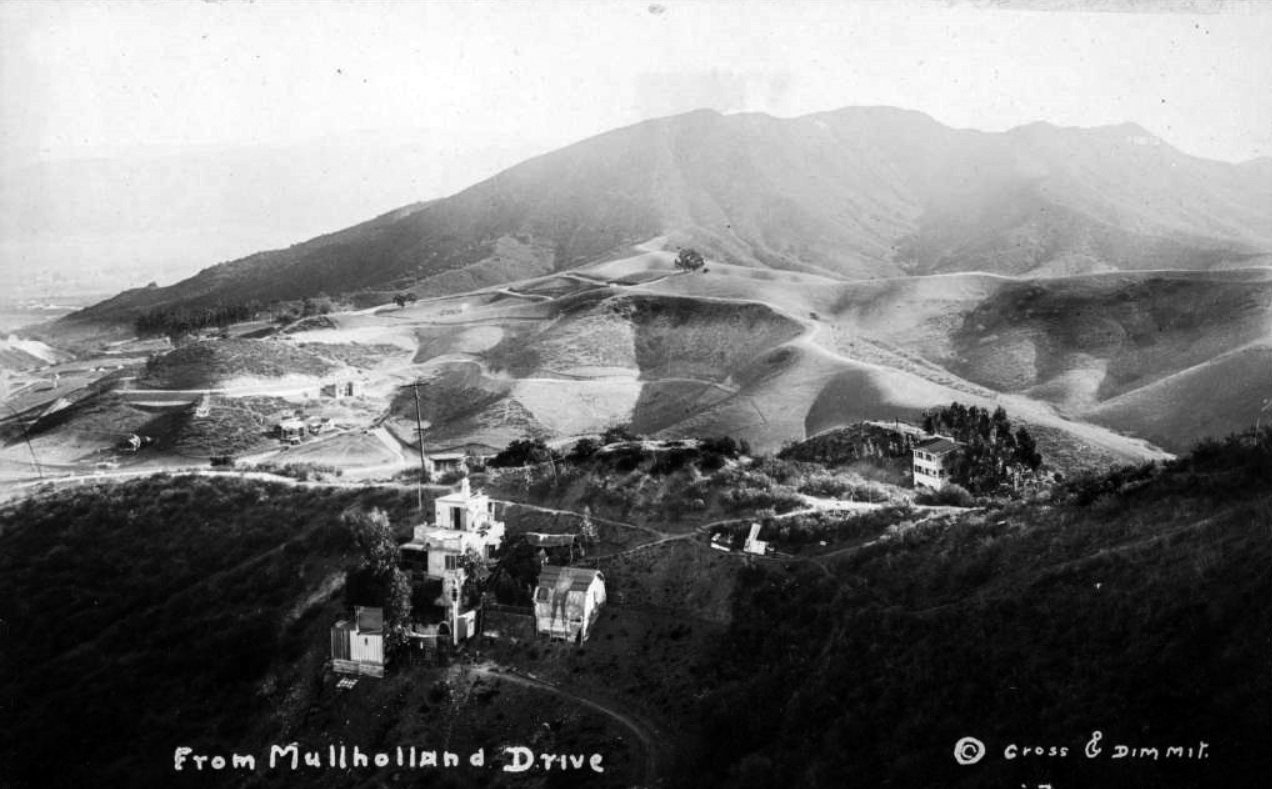 |
|
| (1920s)* - Postcard view looking north showing the Hollywood Hills from Mulholland Drive, with a few houses in the foreground and a faint view of the "Hollywoodland" sign in the upper right. Cahuenga Pass runs between the rolling hills at center and the mountains in the background. |
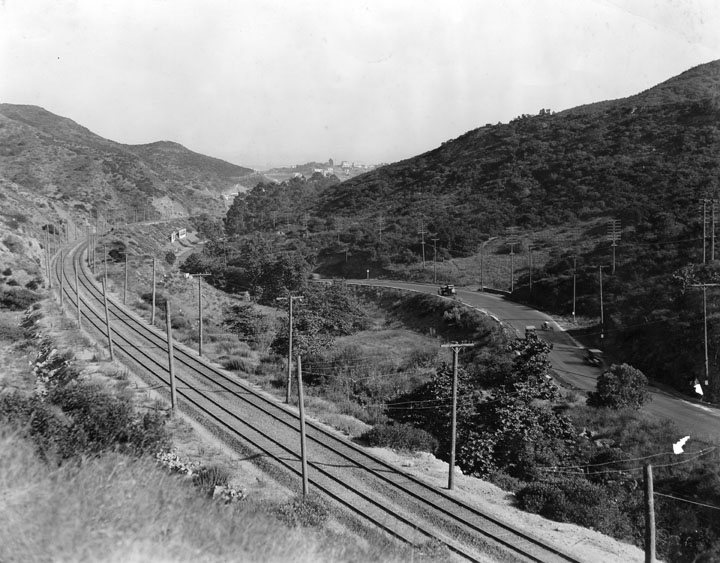 |
|
| (1922)* - View of Cahuenga Pass looking east towards Hollywood. On the left are the railroad tracks, and paralleling them on the right is the road for cars. |
 |
|
| (1922)* - Aerial view of Cahuenga Pass with the San Fernando Valley in the background. |
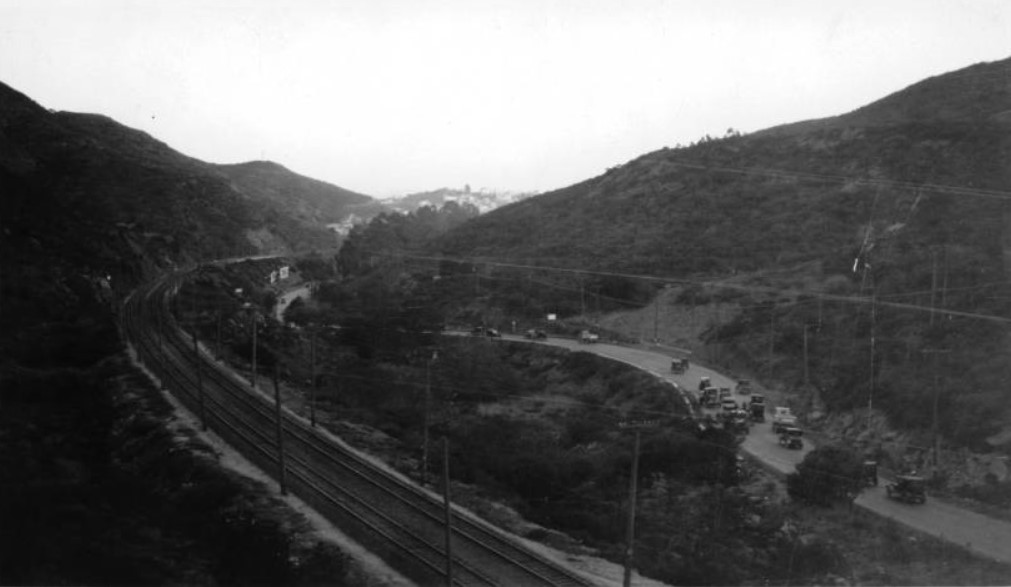 |
|
| (1923)^ - View of Cahuenga Pass looking toward Hollywood from a new road leading from Holly Crest Station to a dam in Weid Canyon (Mulholland Dam). |
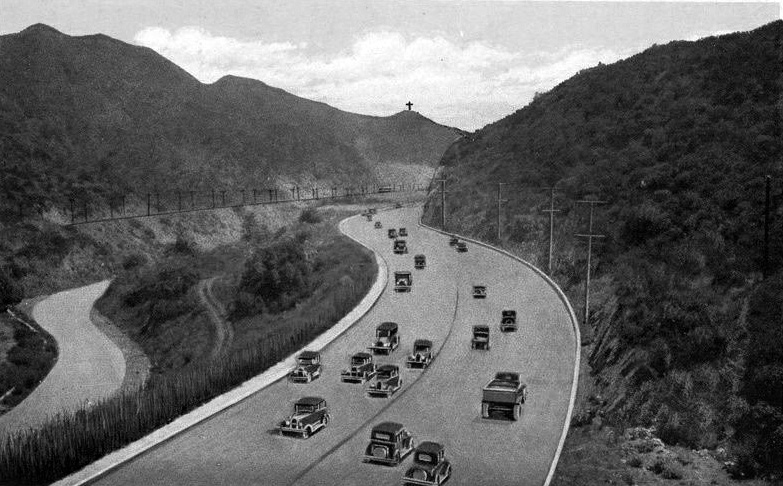 |
|
| (ca. 1923)^ – Postcard view of Cahuenga Pass looking toward Hollywood. A cross can be seen on top of the hills in the background. |
Historical Notes The 32-foot-high steel cross at 2580 Cahuenga Boulevard in the Hollywood Hills was erected in 1923 to the memory of Christine Wetherill Stevenson. The Pilgrimage Play Theatre was built in 1920 by the author Christine Wetherill Stevenson. She believed the rugged beauty of the Cahuenga Pass would provide a dramatic outdoor setting for The Pilgrimage Play. Together with Mrs. Chauncey D. Clark, she purchased this land along with that on which the Hollywood Bowl now sits. A wooden, outdoor amphitheater was built on this site and the play was performed by noted actors every summer from 1920 to 1929, until the original structure was destroyed by a brush fire in October 1929. In 1976, the Pilgrimage Theatre was renamed the John Anson Ford Theatre in honor of the late L.A. County Supervisor's significant support of the arts. |
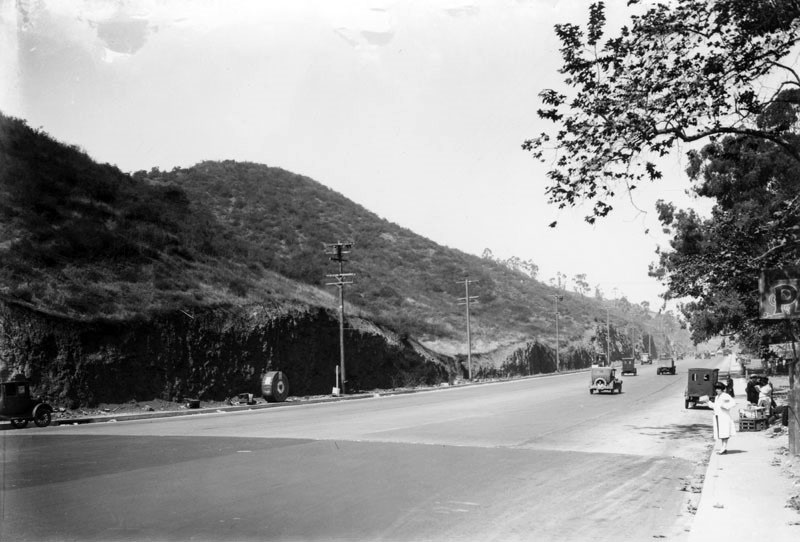 |
|
| (1920s)* - View of the broad highway on Cahuenga Pass - the lowest through the Santa Monica Mountains - that connects the Los Angeles Basin to the San Fernando Valley. The hills are truncated where they were excavated for the road bed. A street vendor is setup on the curb and although the utility poles are standing, the electric cables have not been strung. A roll of cable sits next to a pole, left. |
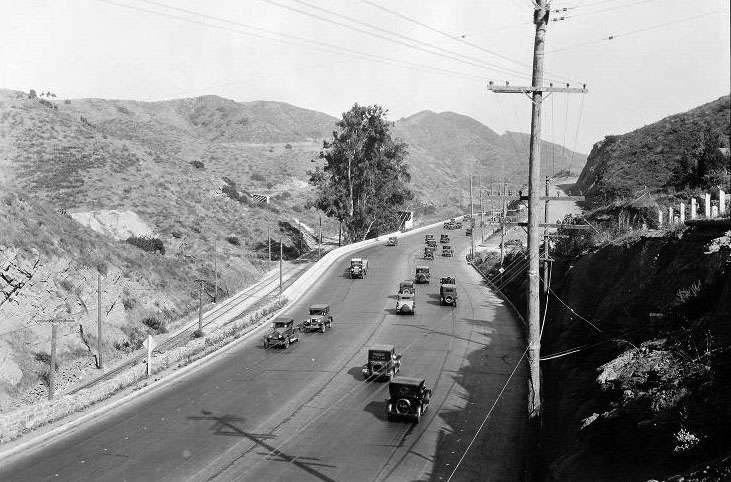 |
|
| (1928)* - View of Cahuenga Pass Road, south from the Summit. Railway tracks are on the left. |
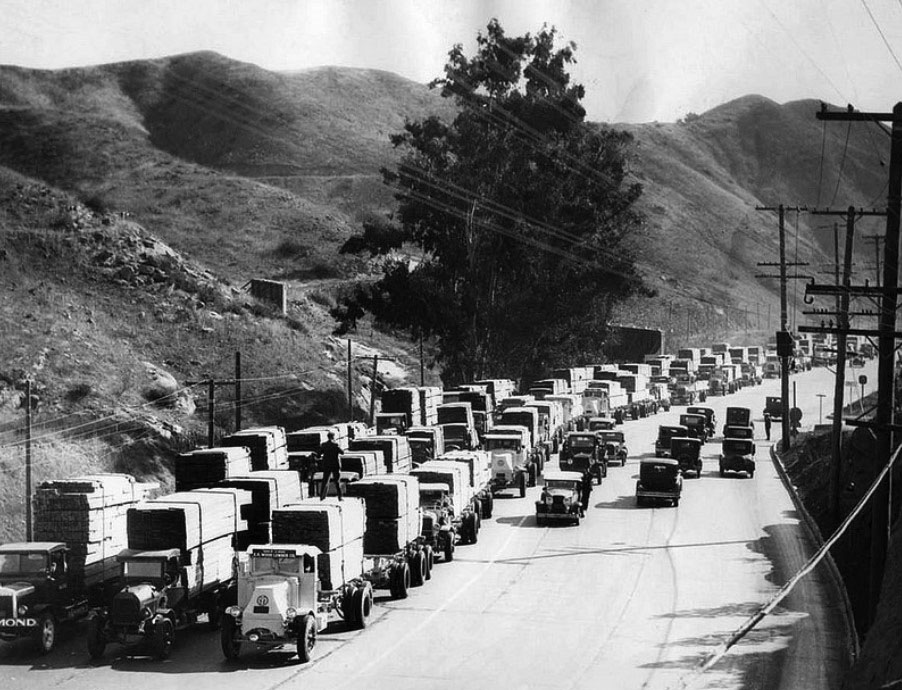 |
|
| (1930)* – View showing a Universal Studios Lumber Convoy on Cahuenga Pass Road. Photo Date: 12/31/30 |
Historical Notes Greatest single truck shipment of lumber ever moved over American highways at one time parades through Los Angeles streets as 100 motor trucks and trailers, carrying almost a million board feet representing a year's supply for Universal Studios, is escorted across town from Los Angeles Harbor by a convoy of police. |
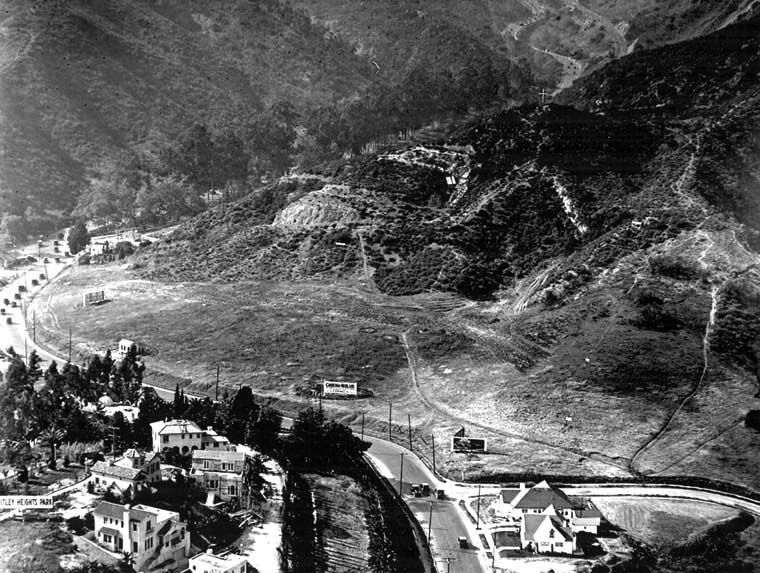 |
|
| (ca. 1930)* - Aerial view of Cahuenga Pass looking northwest. Whitley Heights is at the left. The Hollywood Bowl is located at center left (out of view). |
 |
|
| (1930)* - Cars travel in both directions through the Cahuenga Pass near the Hollywood Bowl. The roadway through the Pass, the lowest through the Santa Monica Mountains, connects the Los Angeles Basin to the San Fernando Valley. The hills are truncated where they were excavated for the road bed. On the left, a large hillside billboard advertises the The Outpost development in the Hollywood Hills. A roadside vendor is setup near the Hollywood Bowl parking sign on the right. |
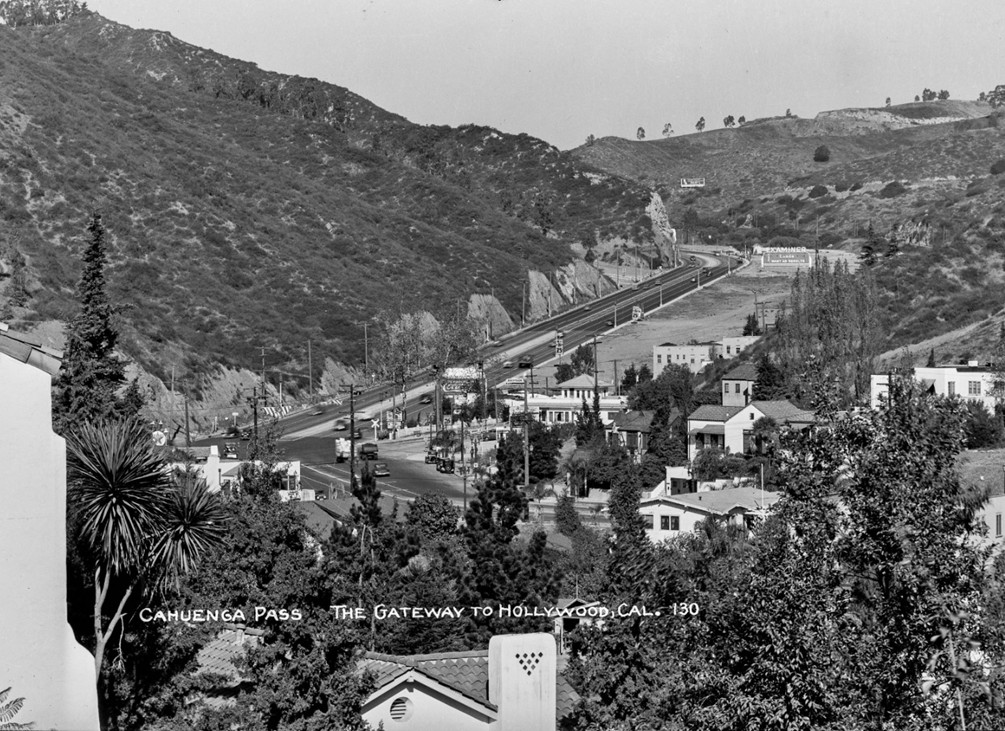 |
|
| (1930s)* – Postcard view of Cahuenga Pass looking north from Hollywood. The intersection of Highland Avenue and Cahuenga Boulevard is seen at center left, marked by a railroad crossing sign. Several signs advertising 25-cent parking for the Hollywood Bowl are clustered near the base of the pass. A prominent sign for “The Berries” restaurant stands at center, catering to motorists en route to the Bowl or beyond. The Bowl entrance lies just out of frame to the left. The Hollywood Freeway had not yet been constructed. Photo by Bob Plunkett from the Ernest Marquez Collection. |
Historical Notes The transition to a modern freeway began with the opening of the Cahuenga Pass Freeway (or Cahuenga Pass Parkway) in 1940. During the late 1940s, the route was sometimes referred to as the Hollywood Parkway in planning documents and press coverage. The name Hollywood Freeway became the official and widely used designation by the early 1950s. The Cahuenga Pass section of the freeway opened in 1949, and by 1954, the full stretch—from downtown Los Angeles to the San Fernando Valley—was complete. |
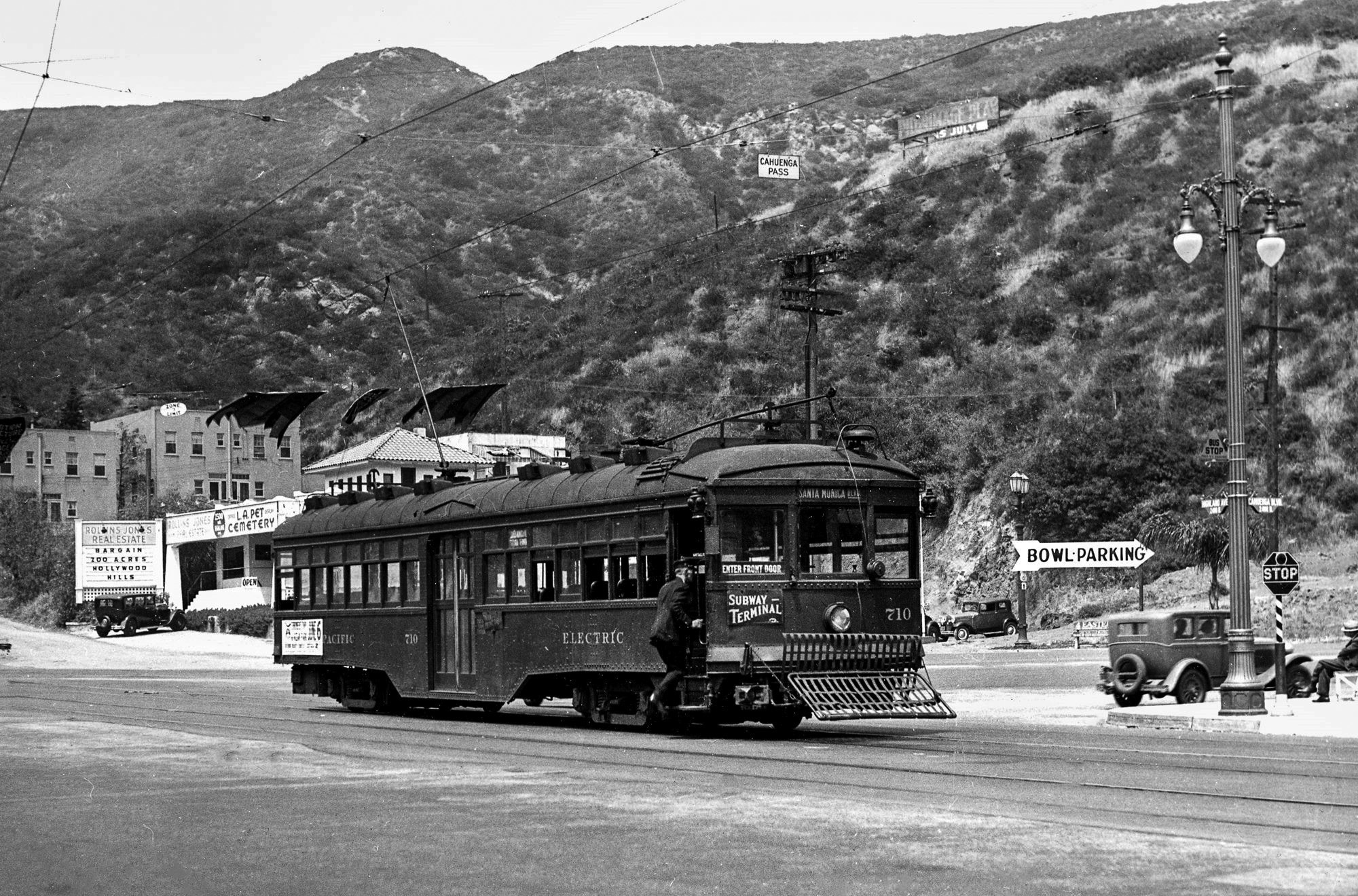 |
|
| (ca. 1930)* – View showing Pacific Electric car #710 inbound from the San Fernando Valley through Cahuenga Pass. The streetcar is at the Hollywood Bowl exit at the corner of Highland Ave and Cahuenga Blvd., heading south on Highland to Santa Monica Blvd. |
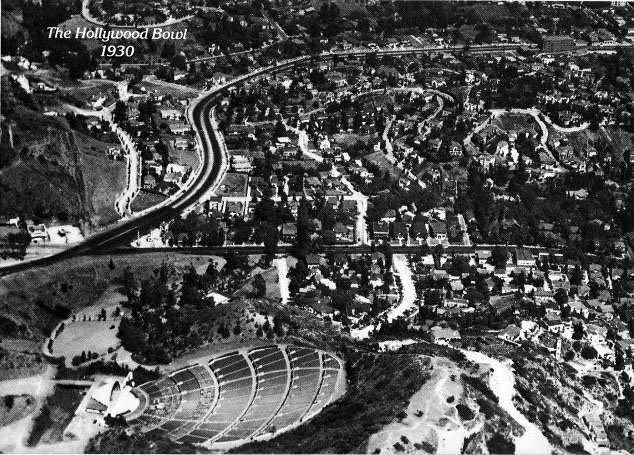 |
|
| (1930)* - Aerial view of the Hollywood Bowl looking east. The neighborhood of Whitley Heights is at the center of photo. The serpentine Cahuenga Boulevard can be seen as it extends out of Cahuenga Pass (middle-left) toward Hollywood (upper-right). |
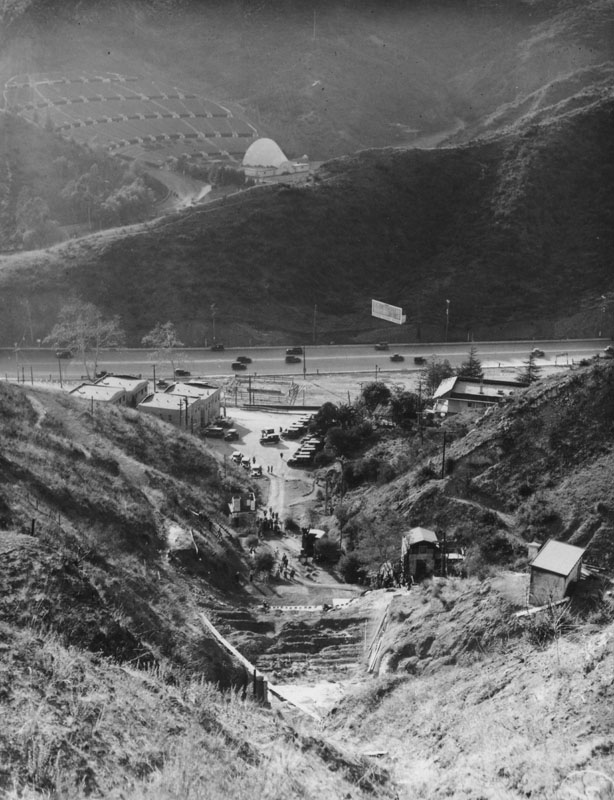 |
|
| (1931)* - Looking down into the site of the future Pilgrimage Play Theatre, revealing the Cahuenga Pass and the Hollywood Bowl in the background. The new structure will resemble the architecture of the Holy Land for the purposes of the play performed there. The previous amphitheater on the site was built in 1920, but a brush fire in October 1929 destroyed that wooden structure. |
Historical Notes In 1976, the Pilgrimage Theatre was renamed the John Anson Ford Theatre in honor of the late L.A. County Supervisor's significant support of the arts. John Anson Ford (1883–1983) helped found the L.A. County Arts Commission, encouraged the Board of Supervisors to support the building of the Music Center and led the County's acquisition of Descanso Gardens, among many other achievements. |
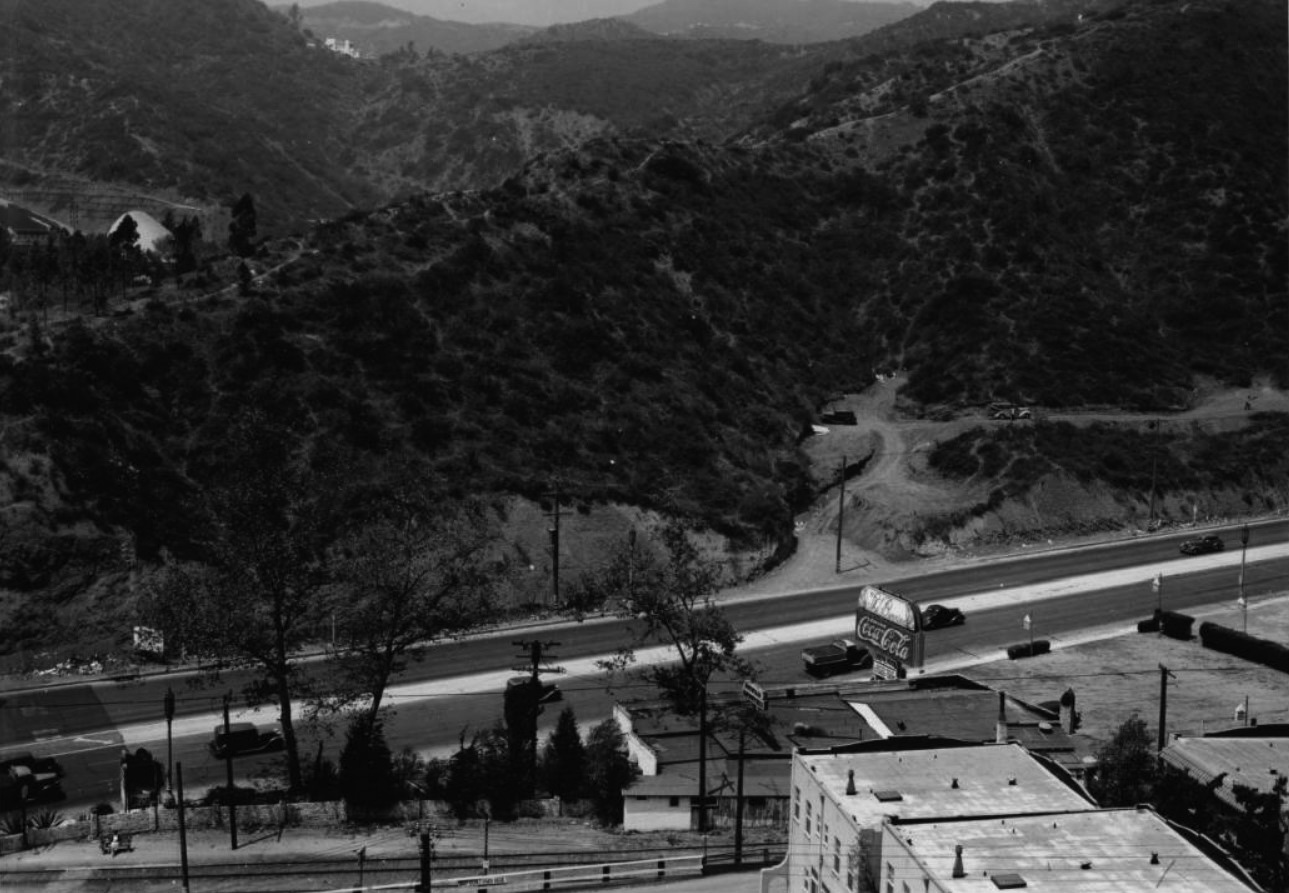 |
|
| (1938)* - Birdseye view looking west over Cahuenga Boulevard. The Hollywood Bowl can be seen at upper-left. At lower center-right a large sign reads: The Berries Dining and Coca Cola |
Historical Notes The Cahuenga Pass was an essential route connecting Hollywood to the San Fernando Valley. In 1938, major infrastructure improvements were planned to ease traffic congestion, including the construction of a new freeway. At the time, the existing road handled both cars and Pacific Electric Railway trolleys. The "Cahuenga Pass Freeway" would eventually open in June 1940. |
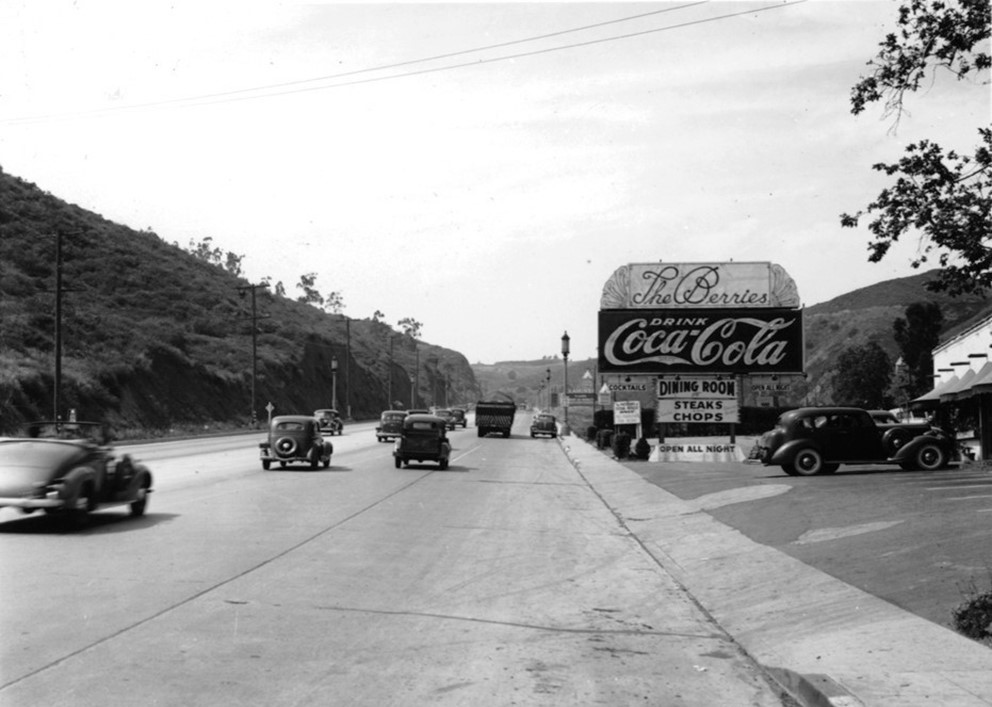 |
|
| (1938)* – Heading home toward the San Fernando Valley on Cahuenga Boulevard past the entrance to the Hollywood Bowl. A restaurant with an over-sized sign on the right invites you to stop and have steaks / chops with a tall glass of Coca Cola. |
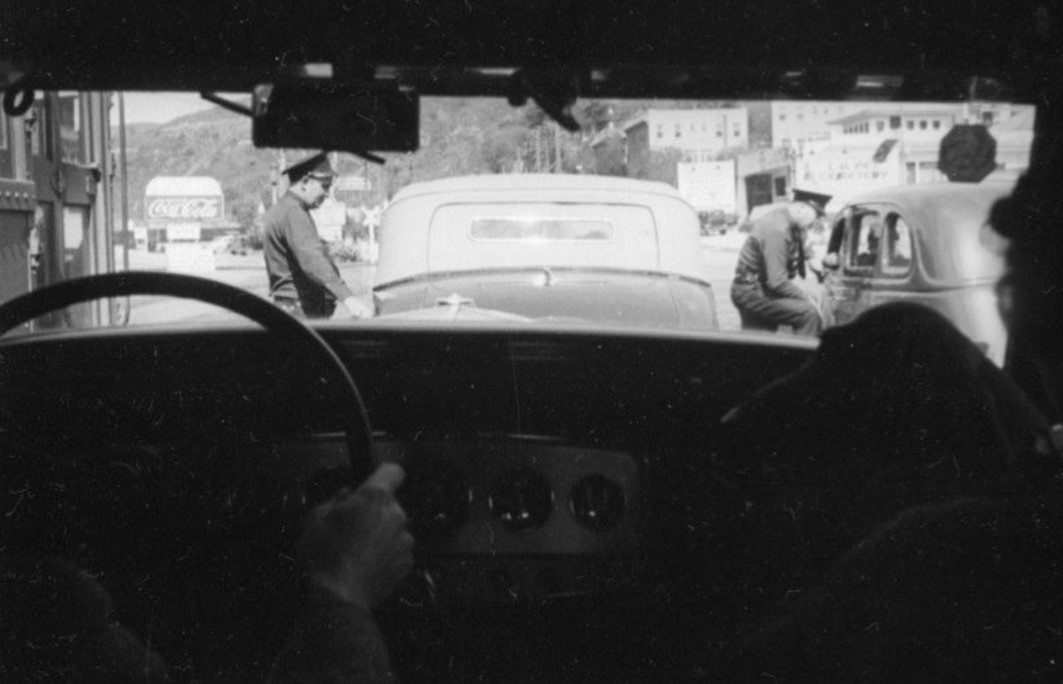 |
|
| (1938)* - This windshield view looking north on Highland at Cahuenga captures a woman holding a dog in her lap in the passenger seat, two police officers speaking to two different cars at a police checkpoint, and surrounding businesses like the Los Angeles Pet Cemetery (2500 North Highland) and signs including a Coca Cola billboard. This area has changed due to the 101 freeway. Photo from the Herman J Schultheis Collection. |
Then and Now
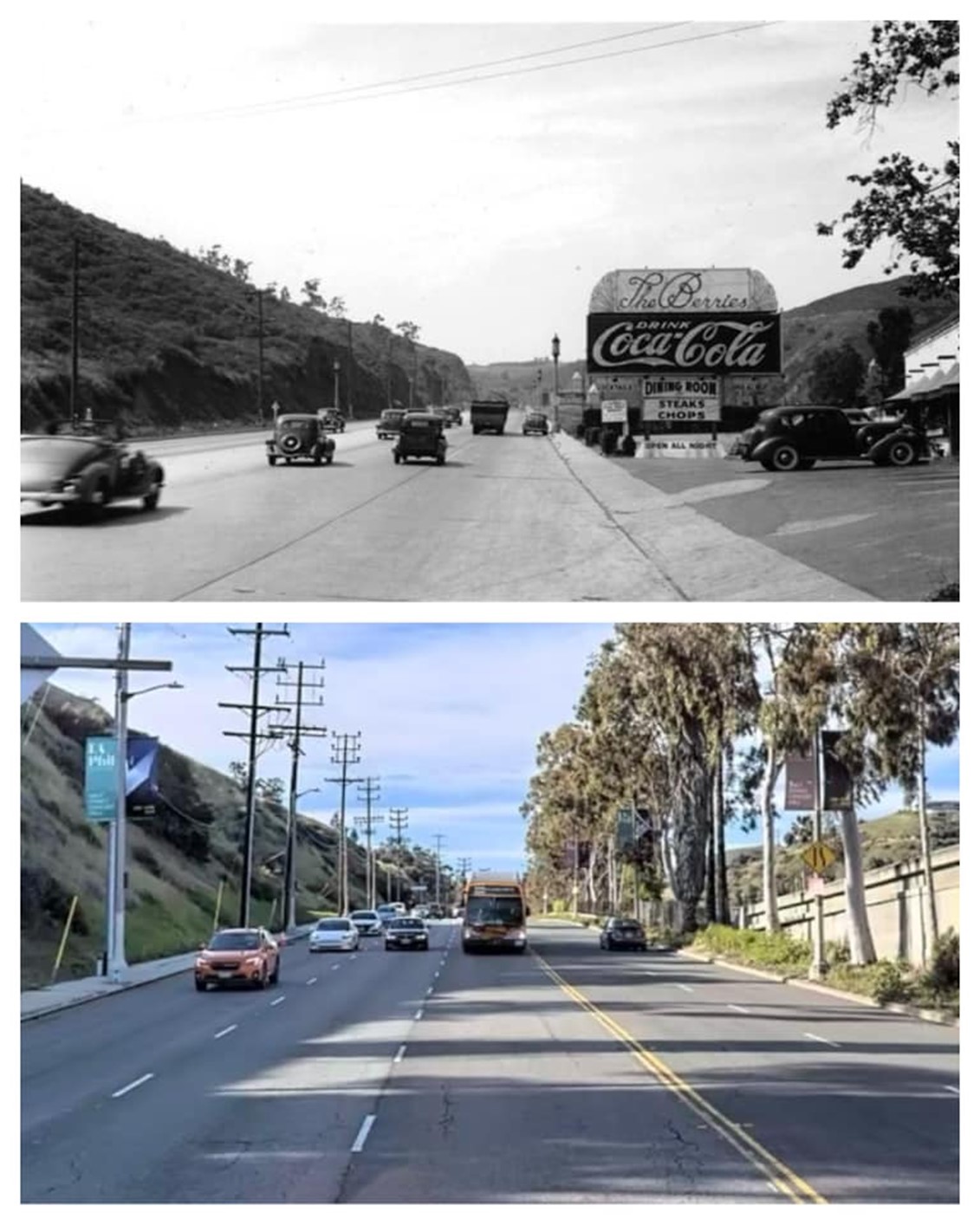 |
|
| (1938 vs 2023)* – Looking north on Cahuenga Boulevard just past the entrance to the Hollywood Bowl. Photo comparison by Trey Callaway. |
Historical Notes The above section of Cahuenga Boulevard is located between the Hollywood Bowl entrance and Pilgrimage Bridge with the Hollywood Freeway seen on the right. |
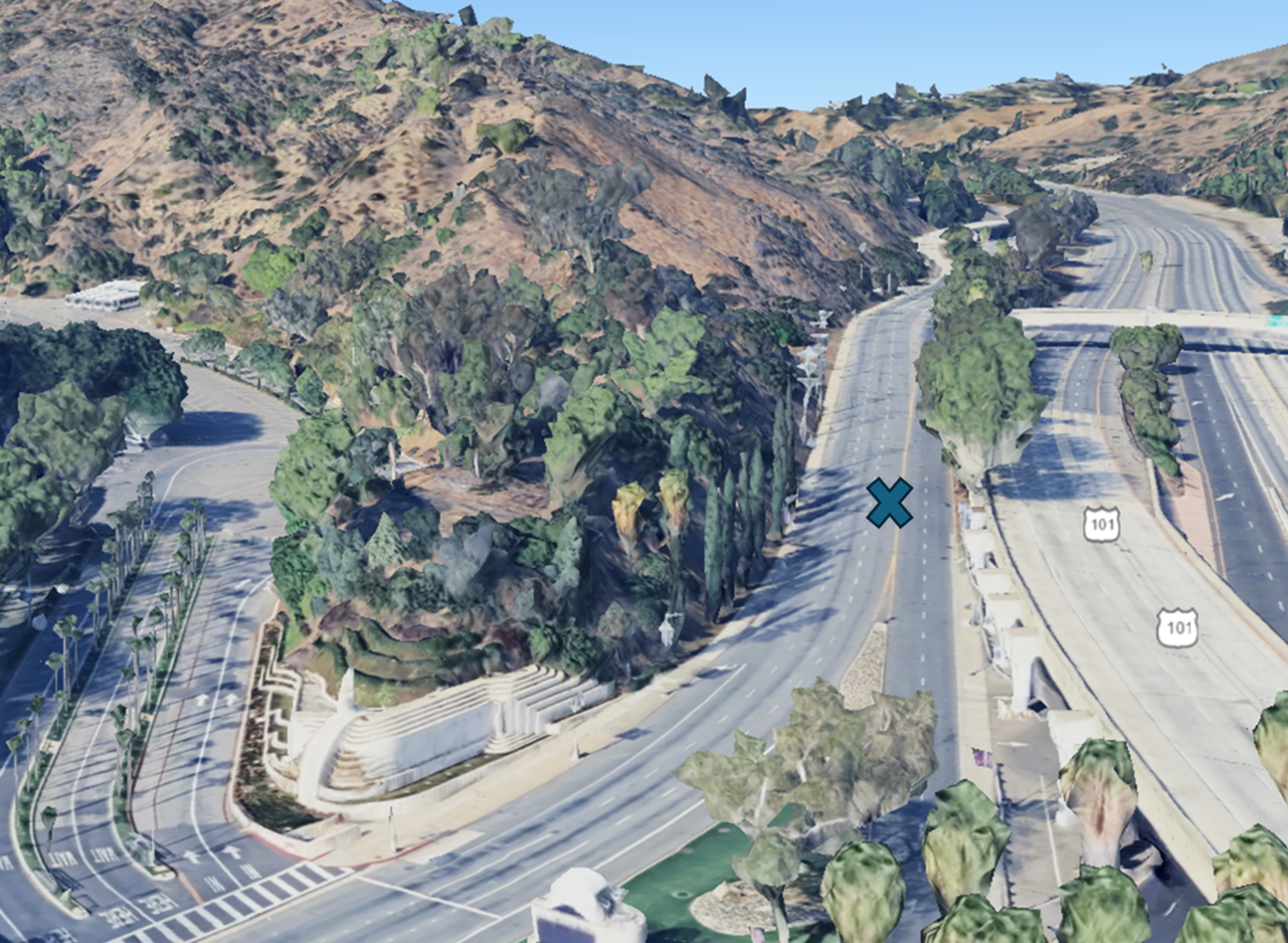 |
|
| (2023)* - Google Earth view showing the approximate location of the previous photo, situated between the Hollywood Bowl entrance and Pilgrimage Bridge. |
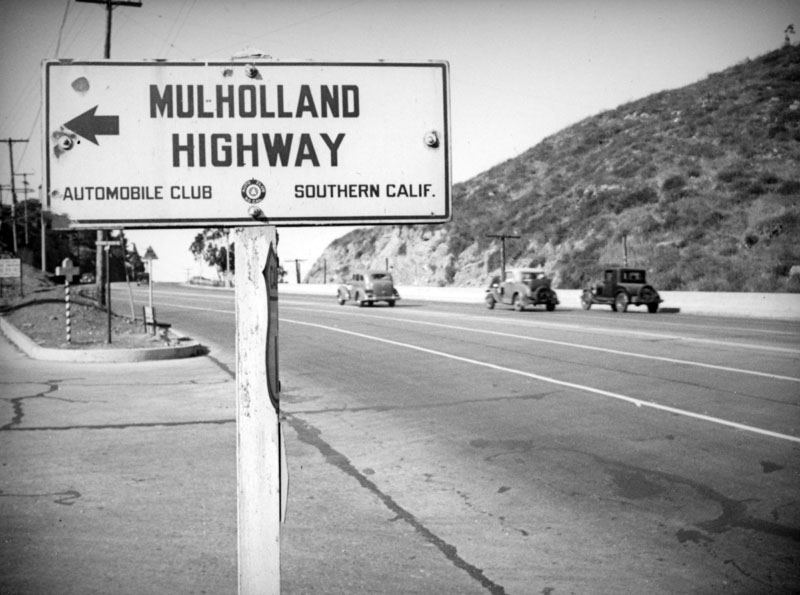 |
|
| (ca. 1938)* - This view of a Mulholland Highway directional sign, which is attributed to the Automobile Club and includes an AAA logo, is taken from the Cahuenga Pass where Cahuenga meets Mulholland. The natural hillside is visible to the east because this is before the 101 freeway was built. The name of the road would be changed to Mulholland Drive in 1939. |
 |
|
| (1930s)* - View looking northwest of Cahuenga Pass with the Pilgrimage Play Theatre parking lot in the foreground. Cahuenga runs from the foreground at left towards the San Fernando Valley at upper center-right. The Hollywood Bowl is out of view to the left. |
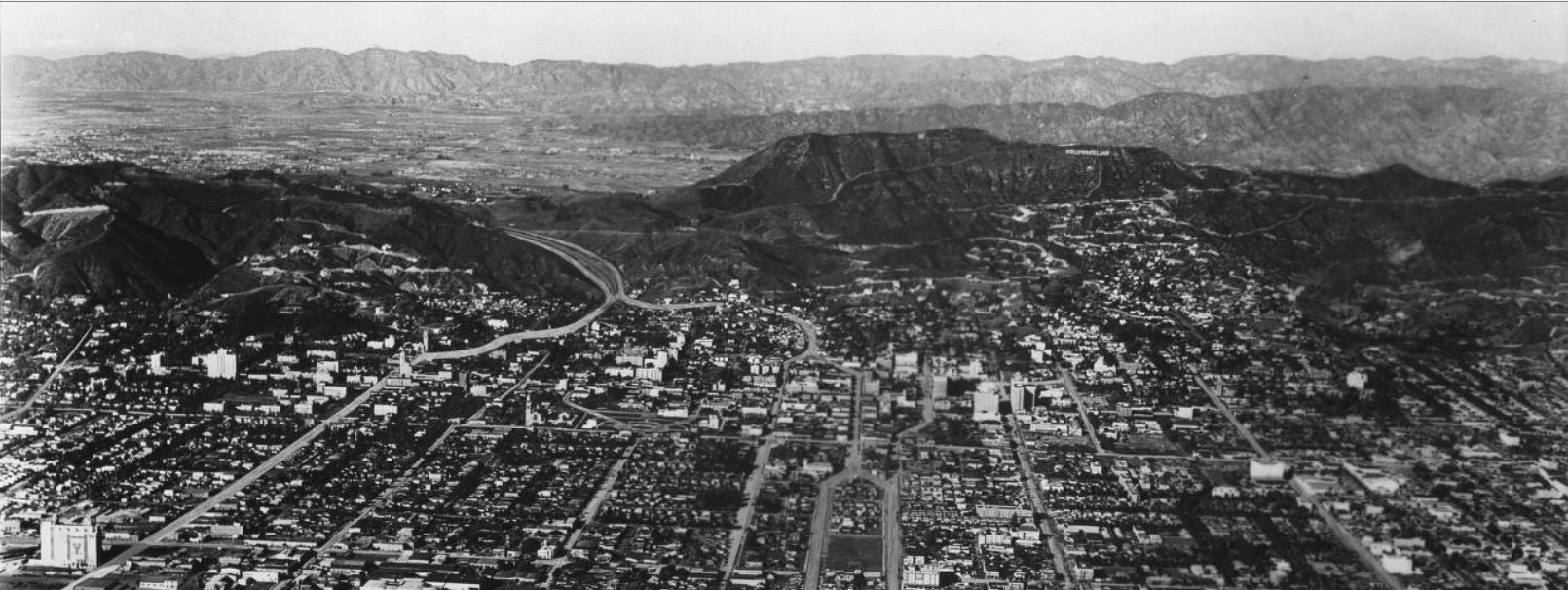 |
|
| (ca. 1930s)^ - Panoramic aerial view of Hollywood showing the Chauenga Pass as it heads towards the San Fernando Valley. The major street running from bottom left diagonally up toward the Cahuenga Pass is Highland Avenue. |
* * * * * |
Cahuenga and Highland: Gateway to Hollywood
.jpg) |
|
| (1937)* - Postcard view looking north showing Cahuenga Pass where Highland Avenue converges with Cahuenga Boulevard, "The Gateway to Hollywood". |
Historical Notes For decades, this junction served as the main northern entry into Hollywood. Travelers passing through the Cahuenga Pass reached this point just before entering the heart of the movie capital. |
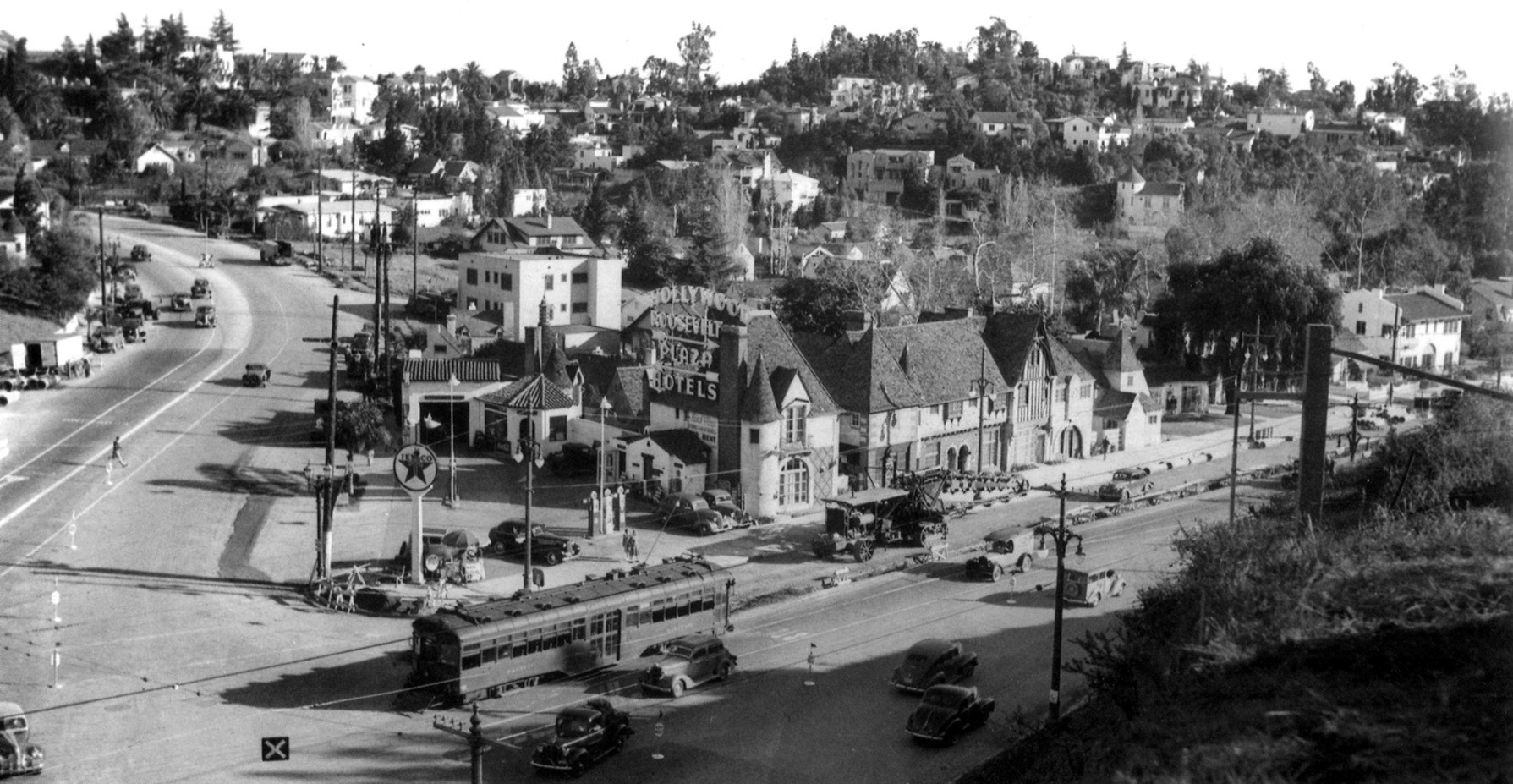 |
|
| (1937)* - Panoramic view looking toward the southeast corner of Cahuenga (left) and Highland Ave (right). Streetcars and automobiles share the road at this busy intersection. A Texaco service station stands on the corner with the Hollywood Roosevelt Plaza Hotels behind it (Note: this hotel is not related to the famous Roosevelt Hotel on Hollywood Boulevard). |
Historical Notes This corner was home to the French Village, a small cluster of cottages and shops built in 1920. It became a gathering spot for actors, writers, and coaches in the 1920s–40s. The view also shows the heavy congestion that pushed city planners to seek traffic fixes. In 1937, work began on a tunnel under Highland to relieve pressure at this intersection. A large boring tractor can be seen at center. |
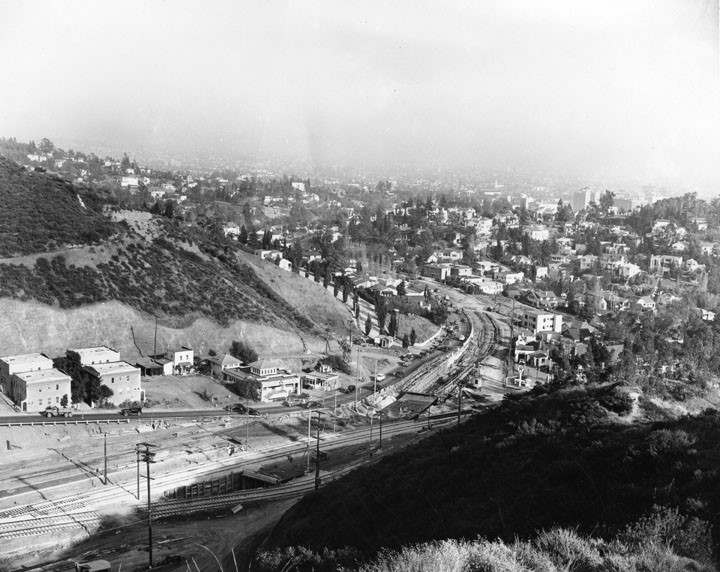 |
|
| (1937)* - View looking southeast toward Whitley Heights showing the construction of a tunnel (Cahuenga Tunnel) under Highland Avenue. Cahuenga Boulevard veers off to the left and would become the location of the Hollywood Freeway in the early 1950s. |
Historical Notes The tunnel was an ambitious attempt to untangle the crossroads of Highland and Cahuenga. It aimed to separate local and through traffic, even as plans for bigger freeway projects were already being discussed. |
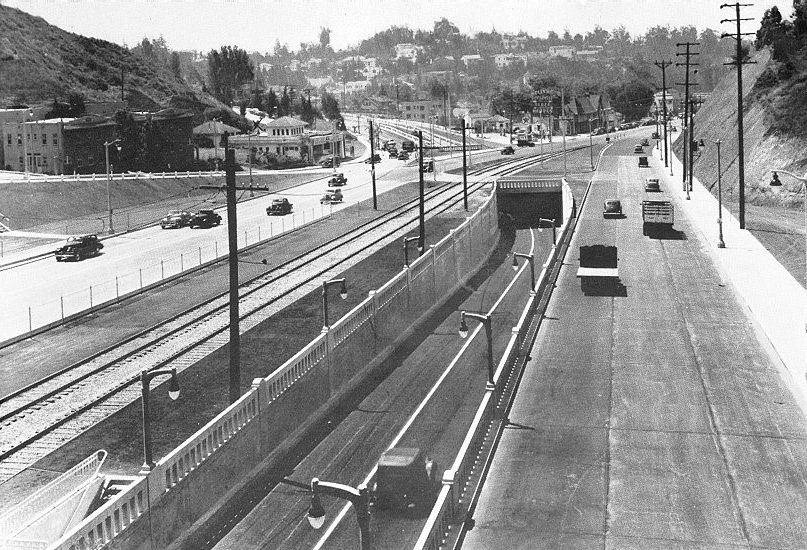 |
|
| (ca. 1938)* - View looking southeast showing the Cahuenga and Highland intersection shortly after a tunnel was bored to relieve congestion. US 101 traffic took the tunnel. Highland Ave traffic went to the right. |
Historical Notes This underpass temporarily eased congestion, but it also created a confusing system of split traffic. The solution would not last, as automobile use kept rising. |
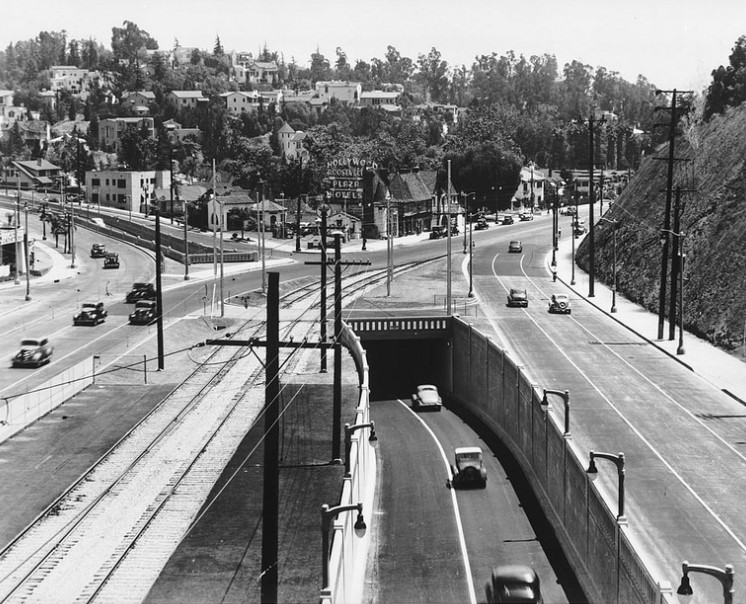 |
|
| (1938)* - Looking southeast at Whitley Heights across the intersection of Cahuenga Boulevard shortly after the construction of the new underpass to Highland Avenue. The entrance to the Hollywood Bowl is just beyond the shoulder of the hill on the right. |
Historical Notes The complicated layout of roads and tunnels here would later be simplified through widening and realignment of Cahuenga Boulevard. The Bowl, just out of view, remained the major landmark anchoring this corridor. |
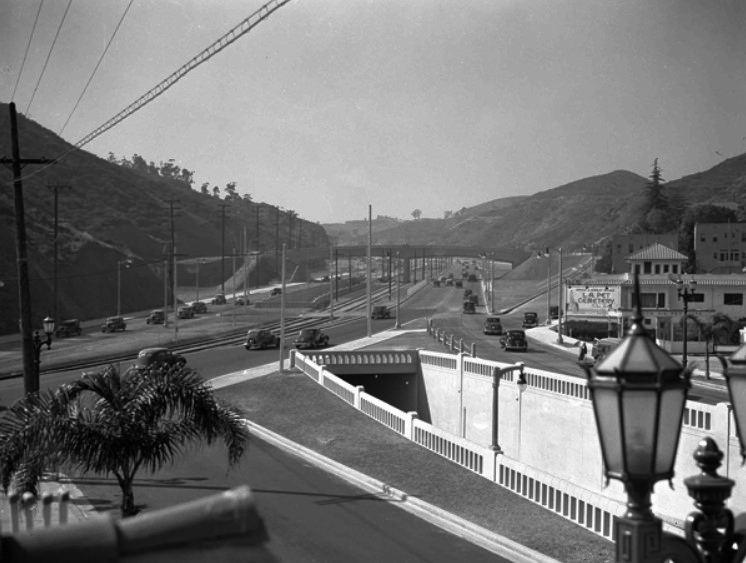 |
|
| (1940s)* - View looking northwest showing Cahuenga Pass as it heads toward the San Fernando Valley. The tunnel at center-right (since closed) extended Highland Boulevard to the north, under the Freeway. The Hollywood Bowl is on left (out of view) on the other side of the freeway. |
Historical Notes On June 15, 1940, the first two-mile section of the Hollywood Freeway opened here, then called the Cahuenga Pass Freeway. Pacific Electric “Red Car” trolleys ran down its center until 1952, making this one of the few freeways in America designed to carry both cars and rail. |
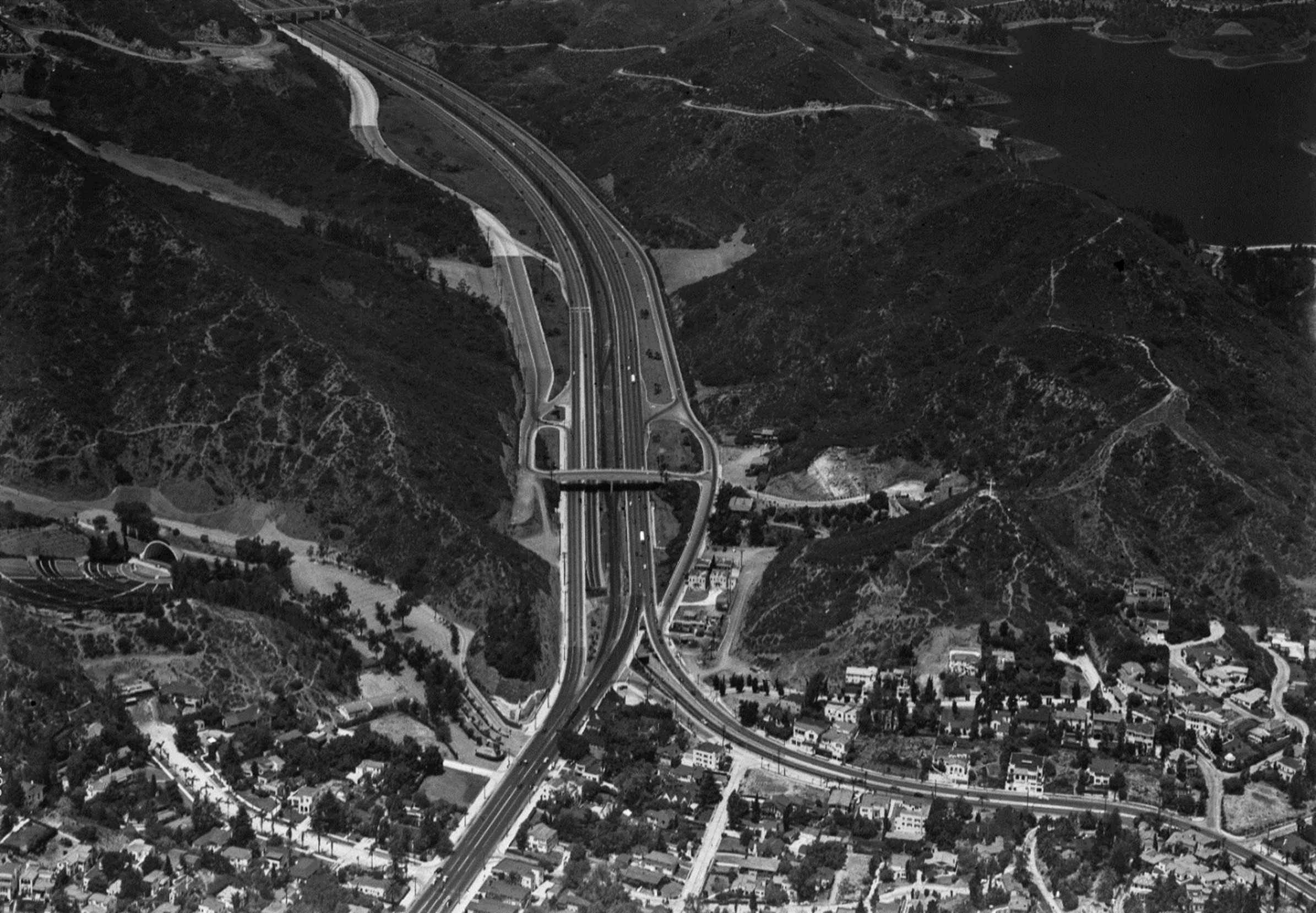 |
|
| (1940s)* - Aerial view showing where Highland Avenue merges with Cahuenga Boulevard and forms the new freeway through Cahuenga Pass (Cahuenga Pass Freeway). The Hollywood Bowl is visible at lower left and the John Anson Ford Amphitheatre off of Cahuenga Boulevard at center right, with the Hollywood Reservoir seen in the hills beyoned (upper right). Photo from the Ernest Marquez Collection. |
Historical Notes The 1940 freeway carried the U.S. 101 designation but was not yet called the Hollywood Freeway. That name came later, when the road was extended south toward downtown Los Angeles and officially renamed in 1954. |
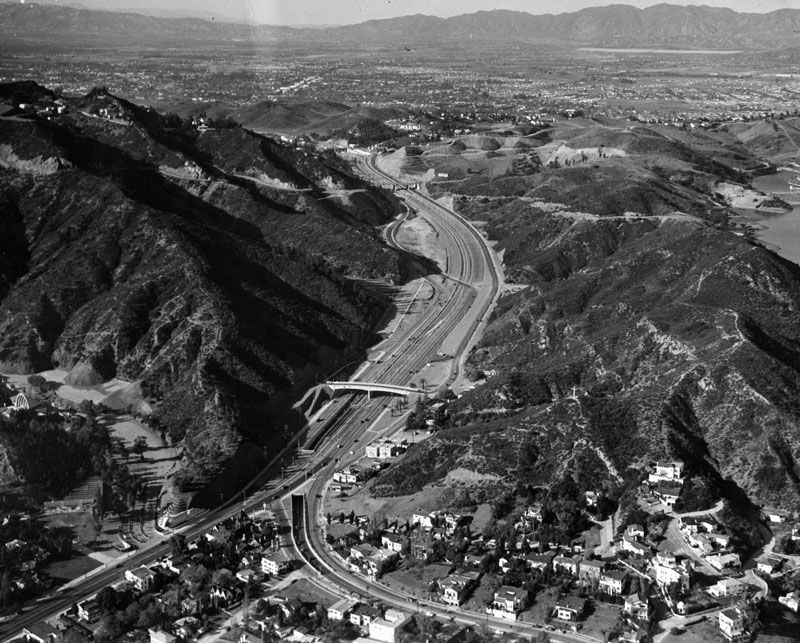 |
|
| (ca. 1951)* - Bird's eye view of the Hollywood Freeway through the Cahuenga Pass, looking towards the Valley. The Cahuenga Tunnel under Highland Avenue can be seen at lower center-left. The "Muse of Music" Statue at the entrance to the Hollywood Bowl is visible just to the left of the tunnel as is part of the Hollywood Bowl shell (center-left). |
Historical Notes By the early 1950s, traffic had again outgrown the original Cahuenga Pass Freeway. Plans were already underway to connect this section to the rest of the Hollywood Freeway system. |
Before and After
 |
|
.jpg) |
|
| (1938)* vs. (1953)* - View is looking south, with bottom photo showing how the final link of Hollywood Freeway will connect up with the south end of Cahuenga Pass. Tunnel (3) will be eliminated, and a new bridge constructed (broken lines). (1) Shows detour for southbound traffic from Cahuenga Pass to Highland Avenue (2) and on around bridge construction work (left background). |
Historical Notes In 1953, the Cahuenga Tunnel was demolished and the area rebuilt for the Hollywood Freeway Extension linking Cahuenga Pass to downtown Los Angeles. |
* * * * * |
From Parkway to Freeway: Cahuenga Pass at Highland
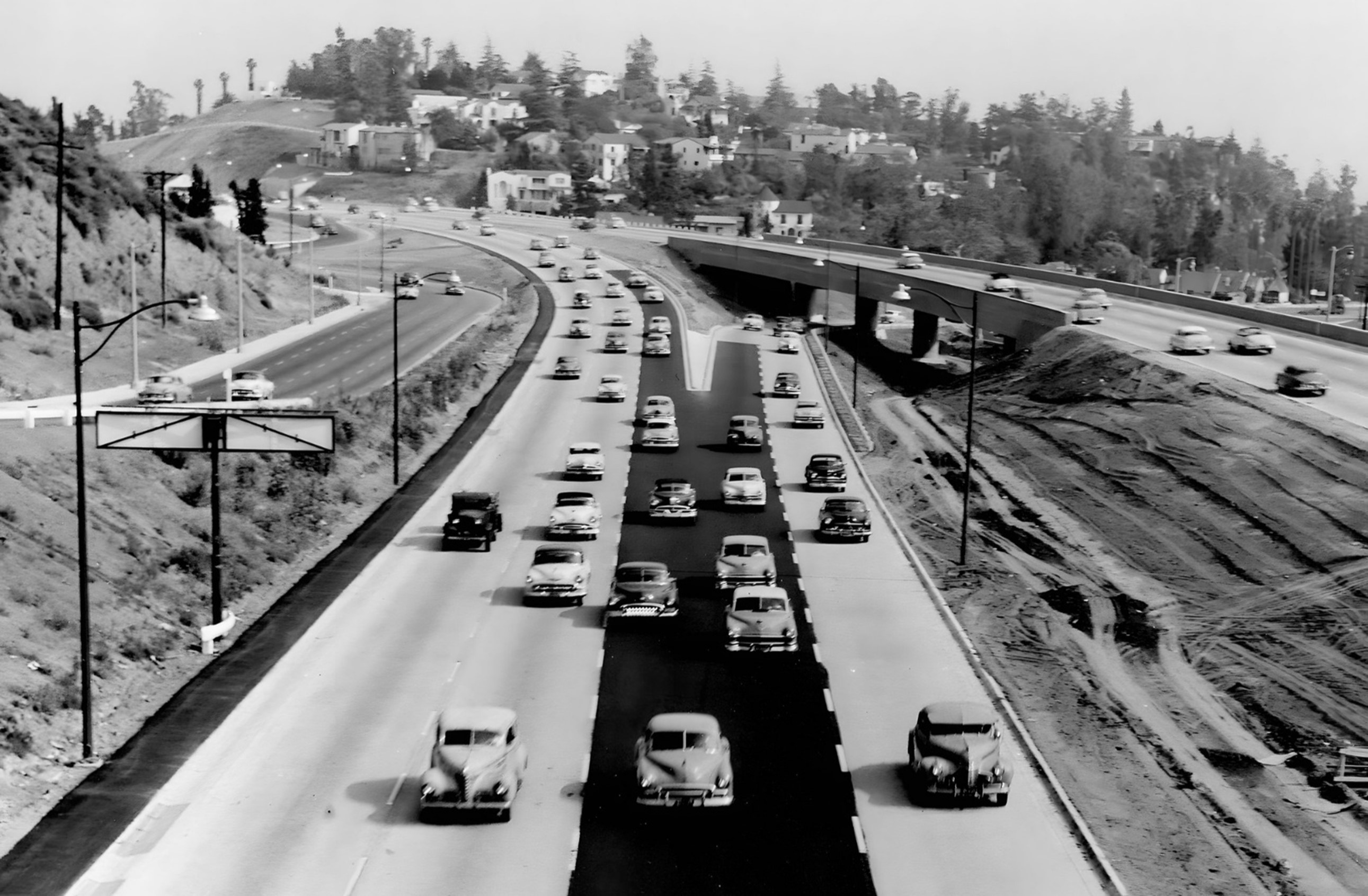 |
|
| (1954)* - Newly reconstructed NB Cahuenga Pkwy (now Hollywood Fwy US-101) at Highland Ave; view SE from Pilgrimage Bridge. |
Historical Notes The 1954 rebuild transformed the parkway into a true freeway, with more lanes, higher speeds, and modern interchanges. It symbolized Los Angeles’ postwar push to move cars quickly across the city. |
Before and After
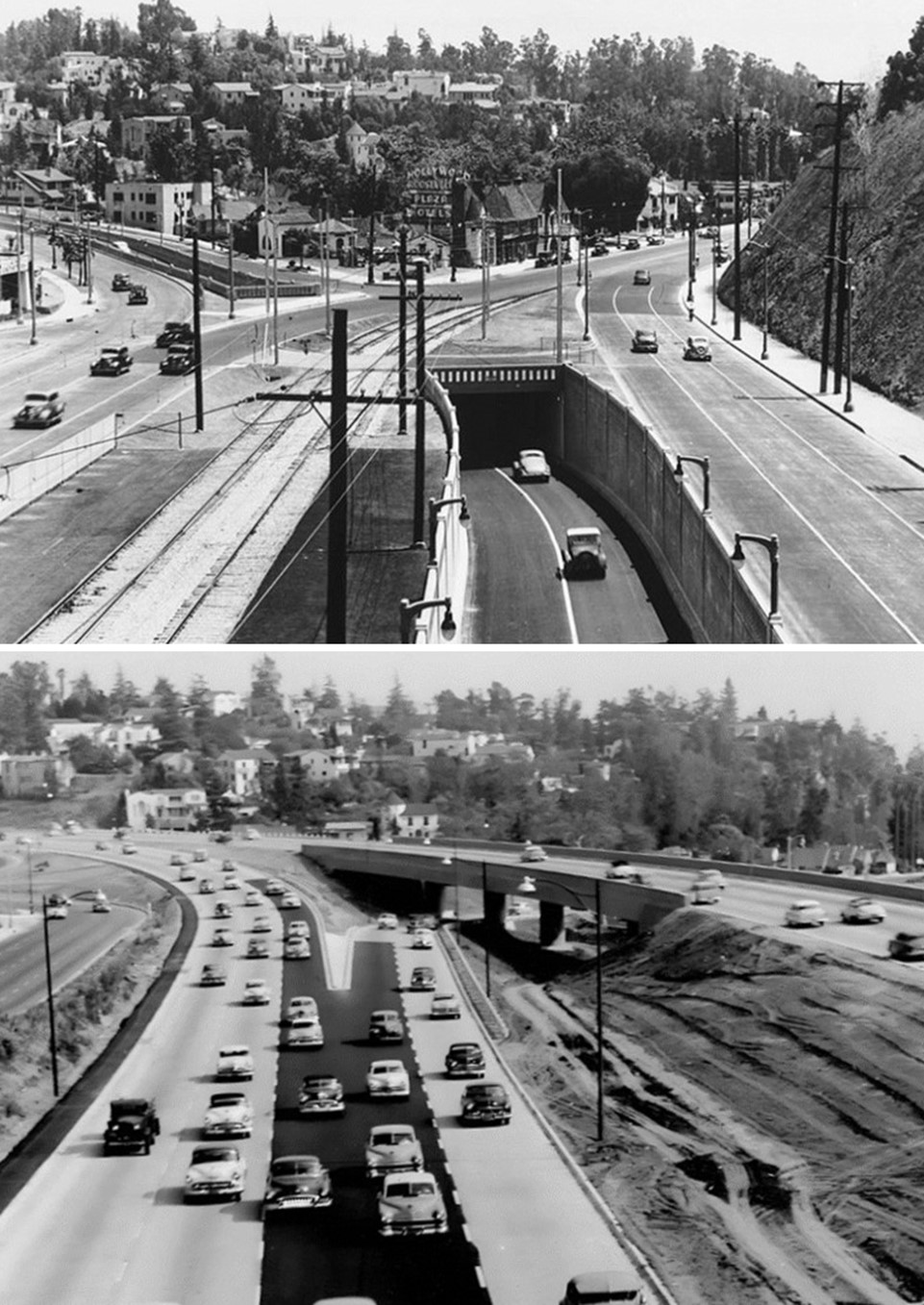 |
|
| (1938 vs. 1954)* – View showing the NB Cahuenga Pkwy (now Hollywood Freeway US-101) before and after reconstruction at Highland Avenue as seen from the Pilgrimage Bridge. Photo comparison by Jack Feldman. |
Historical Notes The landscaped, slower-moving parkway of 1938 gave way to the stark concrete of a modern freeway by 1954. The comparison highlights the city’s transition from scenic drives to speed-driven infrastructure. |
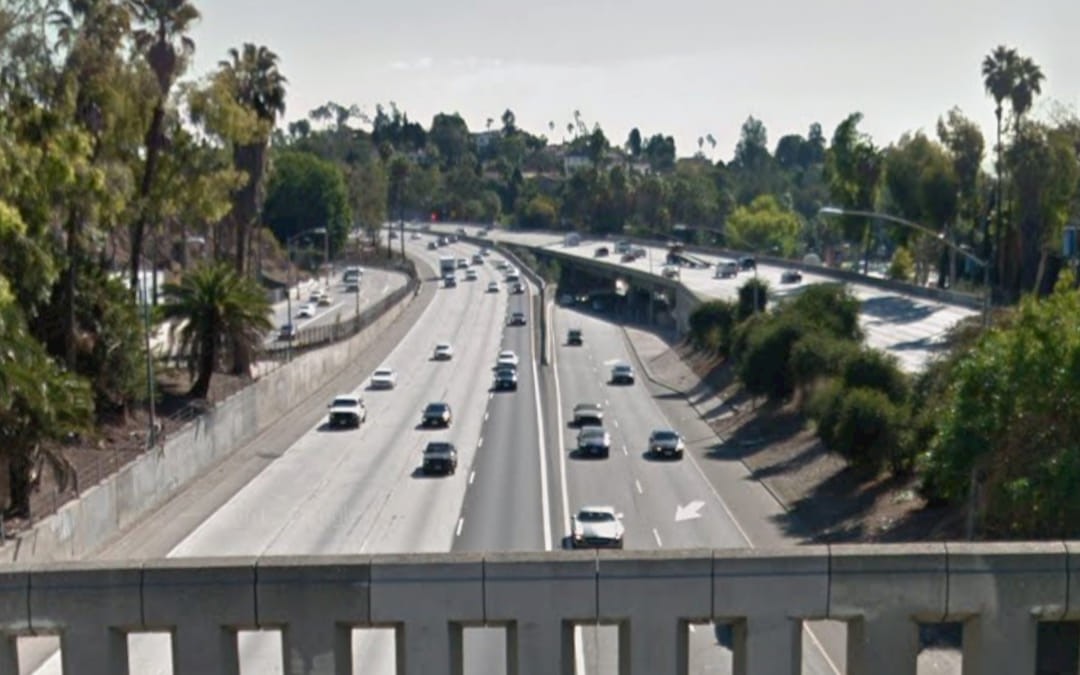 |
|
| (2020s)* - Contemporary view as seen from the Pilgrimage Bridge. Photo courtesy of Mark Newton-John. |
Historical Notes Today, this stretch of the Hollywood Freeway is among the busiest in the state, carrying more than 300,000 vehicles a day. Whitley Heights still anchors the background, but the green parkway setting has long since been replaced by dense freeway structures. |
Then and Now
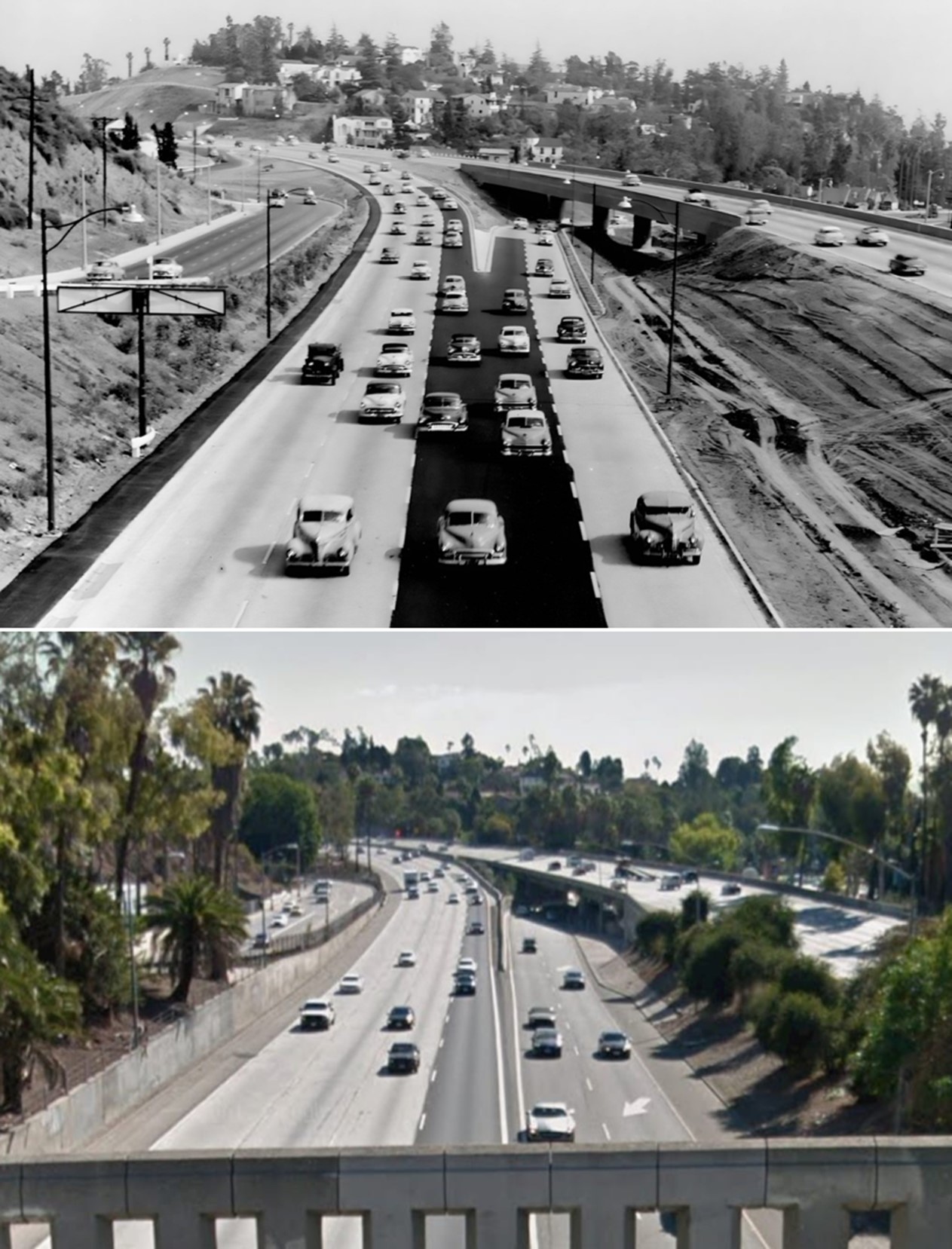 |
|
| (1954 vs. 2020s)* – View looking toward Whitley Heights and the Highland Avenue on-ramp to the NB Hollywood Freeway (US -101) as seen from the Pilgrimage Bridge. Photo comparison by Jack Feldman. |
Historical Notes The 1954 view represented progress and efficiency; the 2020s view shows the long-term burden of freeway dependence. The Highland on-ramp remains a central feature, unchanged despite decades of heavier traffic. |
Before and After with Annotations
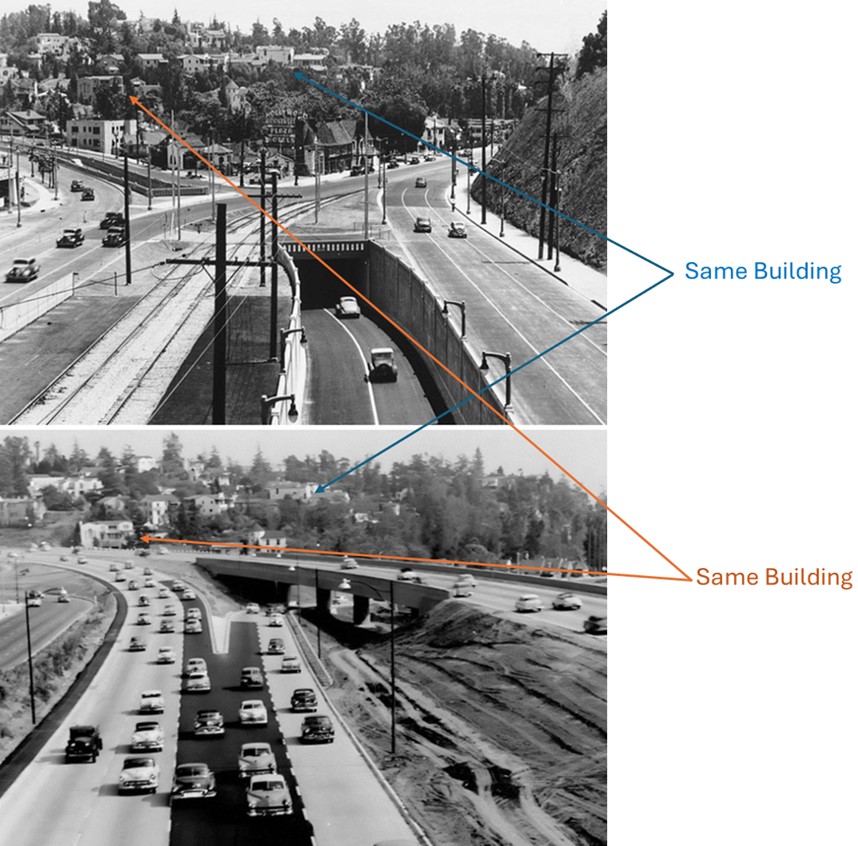 |
|
| (1938 vs. 1954)* – View showing the NB Cahuenga Pkwy (now Hollywood Freeway US-101) before and after reconstruction at Highland Avenue as seen from the Pilgrimage Bridge. Photo comparison by Jack Feldman. |
Historical Notes The annotations show how landscaped medians were removed, Whitley Heights was cut back, and curves were straightened. These changes mark the city’s decision to trade beauty for speed in reshaping the Cahuenga Pass. |
* * * * * |
Cahuenga Pass Parkway Construction
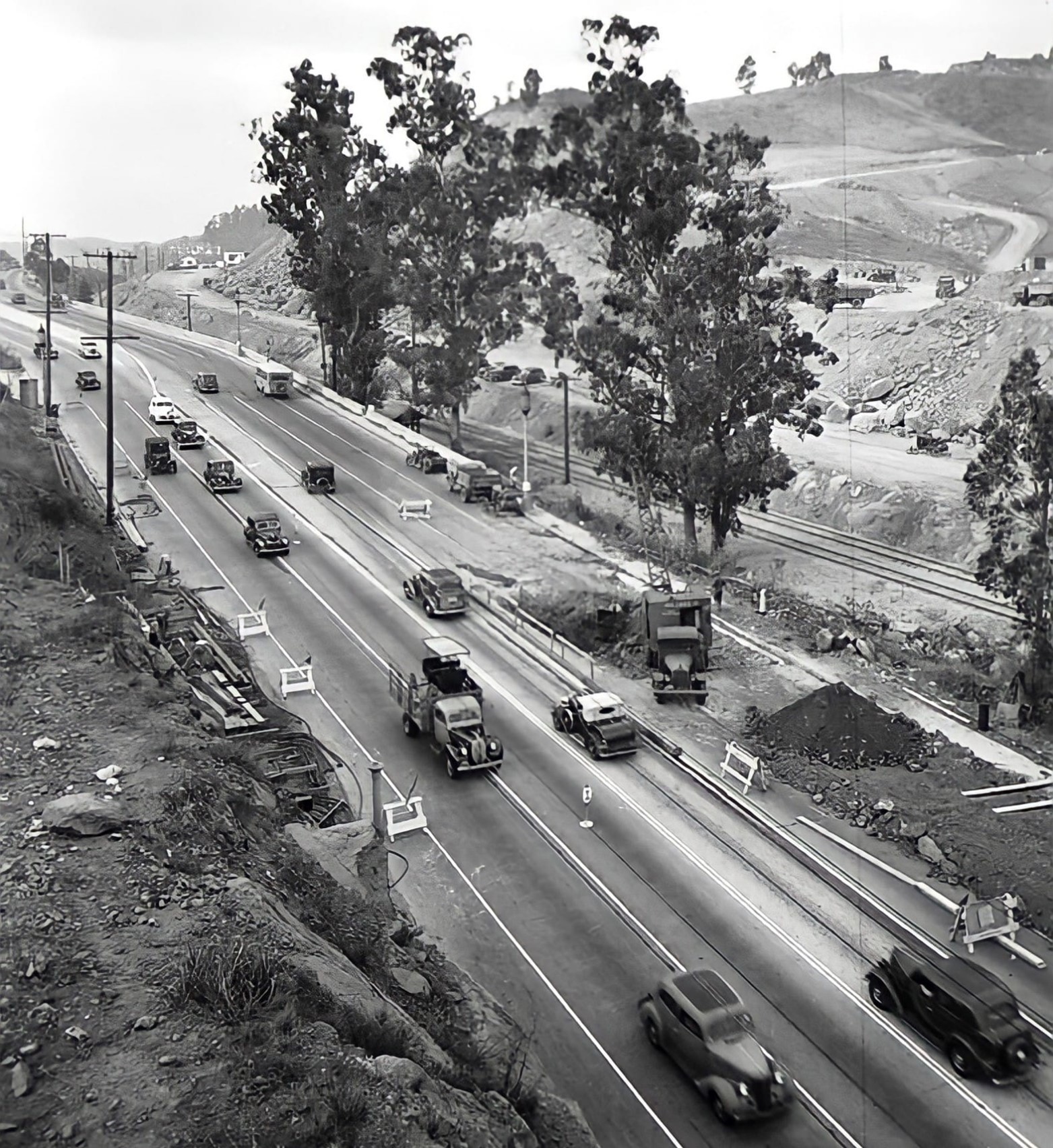 |
|
| (1939)* - Looking NW over Cahuenga Pkwy (US-101, later Hollywood Fwy) construction near present-day Mulholland Dr overcrossing with Cahuenga Blvd in foreground. |
Historical Notes The construction of the Cahuenga Pass Parkway in the late 1930s faced several significant challenges. One of the foremost difficulties was the need to keep the existing road through the pass open to traffic throughout the entire construction period. At the time, the pass was already a critical artery, carrying between 45,000 and 50,000 vehicles per day, making any closure or major disruption untenable for the region’s commuters and commerce. This required careful phasing of construction and innovative traffic management to ensure continuous flow while major infrastructure was built. The construction of the Mulholland Bridge was a complex undertaking, requiring the maintenance of heavy daily traffic-between 45,000 and 50,000 vehicles-through the Cahuenga Pass during the build. The bridge’s tall, vertical design distinguished it from the other parkway bridges, and the project included additional infrastructure such as service roads, wooden guard rails, pedestrian tunnels for safe access to trains, and a vehicular tunnel beneath the roadway. These features reflected a thoughtful integration of automobile and rail transit within a challenging natural landscape, emphasizing both functionality and aesthetics. |
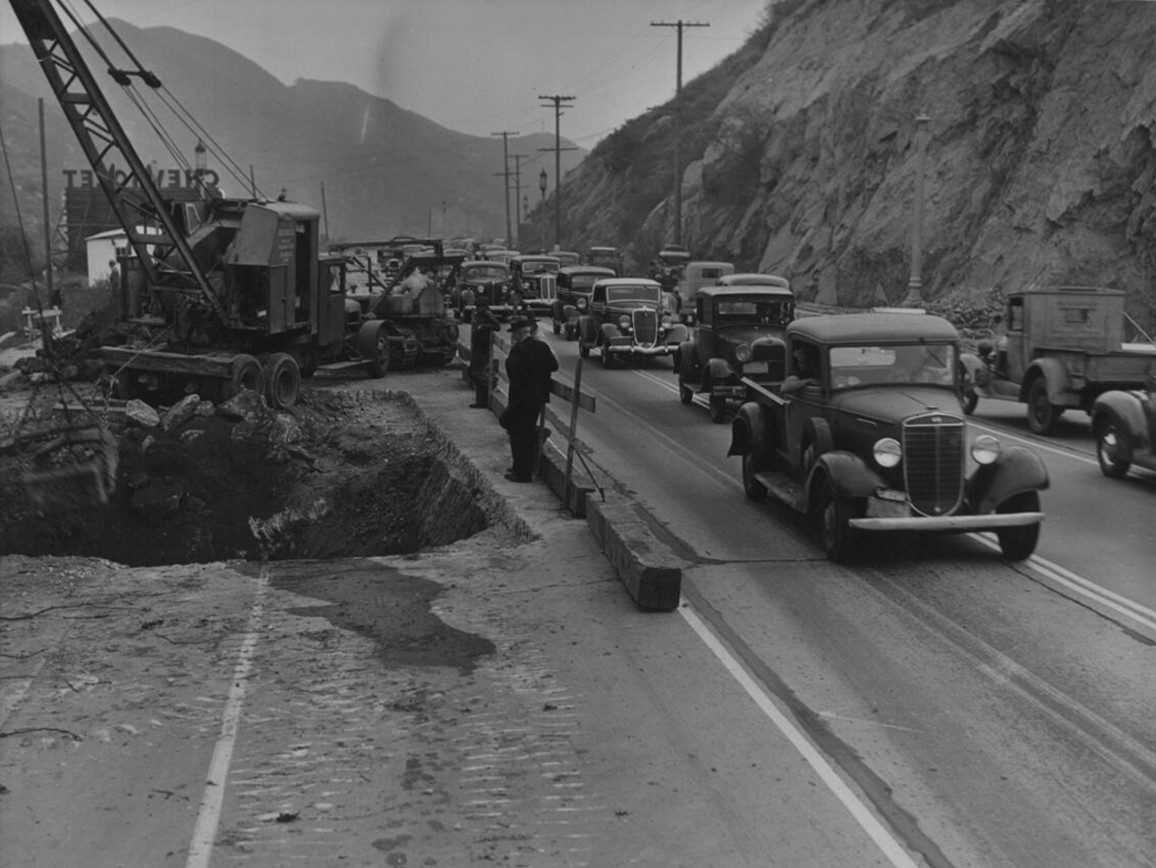 |
|
| (1939)* - View of construction and traffic jam on Cahuenga Pass. |
Historical Notes The construction of the Cahuenga Pass Parkway in the late 1930s faced several significant challenges. One of the foremost difficulties was the need to keep the existing road through the pass open to traffic throughout the entire construction period. At the time, the pass was already a critical artery, carrying between 45,000 and 50,000 vehicles per day, making any closure or major disruption untenable for the region’s commuters and commerce. This required careful phasing of construction and innovative traffic management to ensure continuous flow while major infrastructure was built. Additionally, the project was under intense time pressure due to funding constraints, as the Public Works Administration’s financial support was set to expire by July 1, 1940. To meet this deadline, the work was divided into two main phases, with the first segment completed and dedicated just two weeks before the funding cutoff. The construction also had to contend with the aftermath of the devastating floods of March 1938, which damaged many bridges and roadways in the region, prompting urgent planning and design for replacements and improvements. These factors, combined with the engineering complexities of building new bridges, grade separations, and tunnels in a narrow, heavily traveled natural corridor, made the Cahuenga Pass Parkway project a landmark achievement in Los Angeles infrastructure history. |
* * * * * |
Mulholland Drive Viaduct (aka Mulholland Drive Bridge)
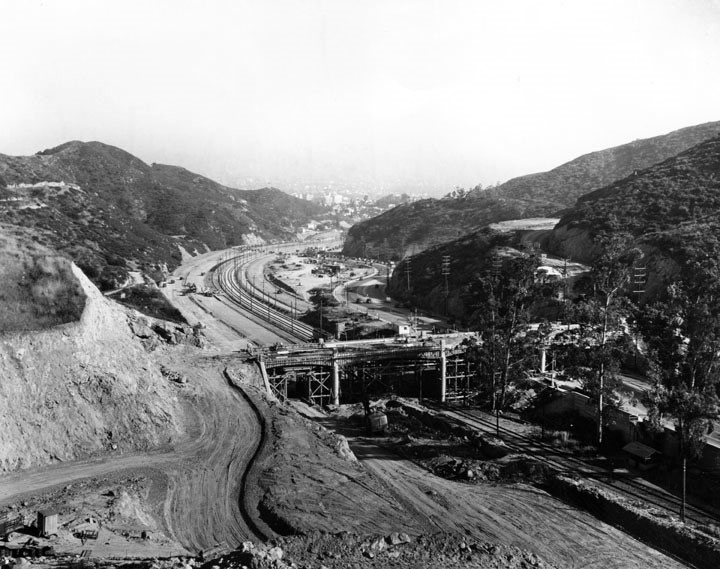 |
|
| (ca. 1939)* - View of Cahuenga Pass looking towards Hollywood showing the construction of the Mulholland Drive Bridge. Mulholland Drive (originally Mulholland Highway) can be seen winding its way up the hill at right. |
Historical Notes The Mulholland Bridge in Cahuenga Pass was constructed in the late 1930s as a key part of the Cahuenga Pass Parkway project, an innovative effort to improve transportation between Hollywood and the San Fernando Valley. Spearheaded by Los Angeles City Engineer Lloyd Aldrich, the project envisioned an eight-lane highway with a central barrier to separate northbound and southbound traffic, while also accommodating Pacific Electric Railway tracks. The Mulholland Bridge, completed and dedicated on June 15, 1940, was one of three major bridges built along the parkway, showcasing the era’s advanced engineering and Streamline Moderne architectural style. The structure on Mulholland Drive that crosses the Cahuenga Pass is historically known as the Mulholland Drive Viaduct, built around 1939 to span the pass and the Hollywood Freeway below. This elevated structure consists of multiple connected spans, fitting the definition of a viaduct as a long series of bridges or arches over terrain and roadways. However, it is sometimes also referred to simply as the Mulholland Drive Bridge in various contexts, reflecting a more general usage of the term "bridge" for this crossing. Despite this interchangeable naming, the term "viaduct" is more precise for describing the structure at Cahuenga Pass due to its length and multi-span design. When it officially opened on December 27, 1924, Mulholland Highway was 24 miles long, running from Cahuenga Pass to Calabasas. The name was changed to Mulholland Drive in 1939. |
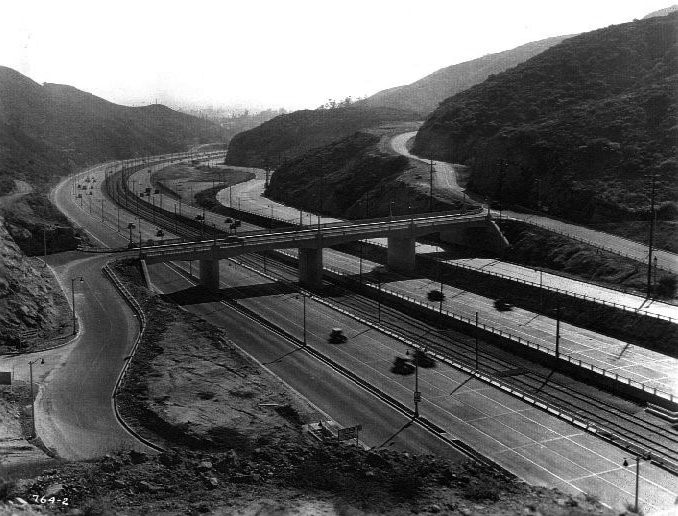 |
|
| (1940)* – View showing the newly completed Cahuenga Pass Freeway looking southwest toward Hollywood with the Mulholland Drive overcrossing at center. The Pacific Electric Railway tracks are visible in the median. |
Historical Notes The Cahuenga Pass Parkway, including the Mulholland Bridge, was completed in two phases by the end of 1940 at a total cost of about $1.7 million. The bridge remains an important transportation link in Los Angeles and stands as a monument to the city’s ambitious public works programs of the era. Mulholland Drive is associated with two major elevated structures named after it in Los Angeles. The first is the Mulholland Drive Bridge over the 405 Freeway in the Sepulveda Pass, originally built in 1959 and replaced in 2013, serving as an important connection between West Los Angeles and the San Fernando Valley. The second is the Mulholland Drive Viaduct, constructed around 1939, which spans the Cahuenga Pass and the Hollywood Freeway (U.S. 101). While this structure is technically a viaduct due to its multiple spans, it is sometimes also referred to as a bridge. Together, these two crossings highlight Mulholland Drive’s role in bridging key transportation corridors in Los Angeles. |
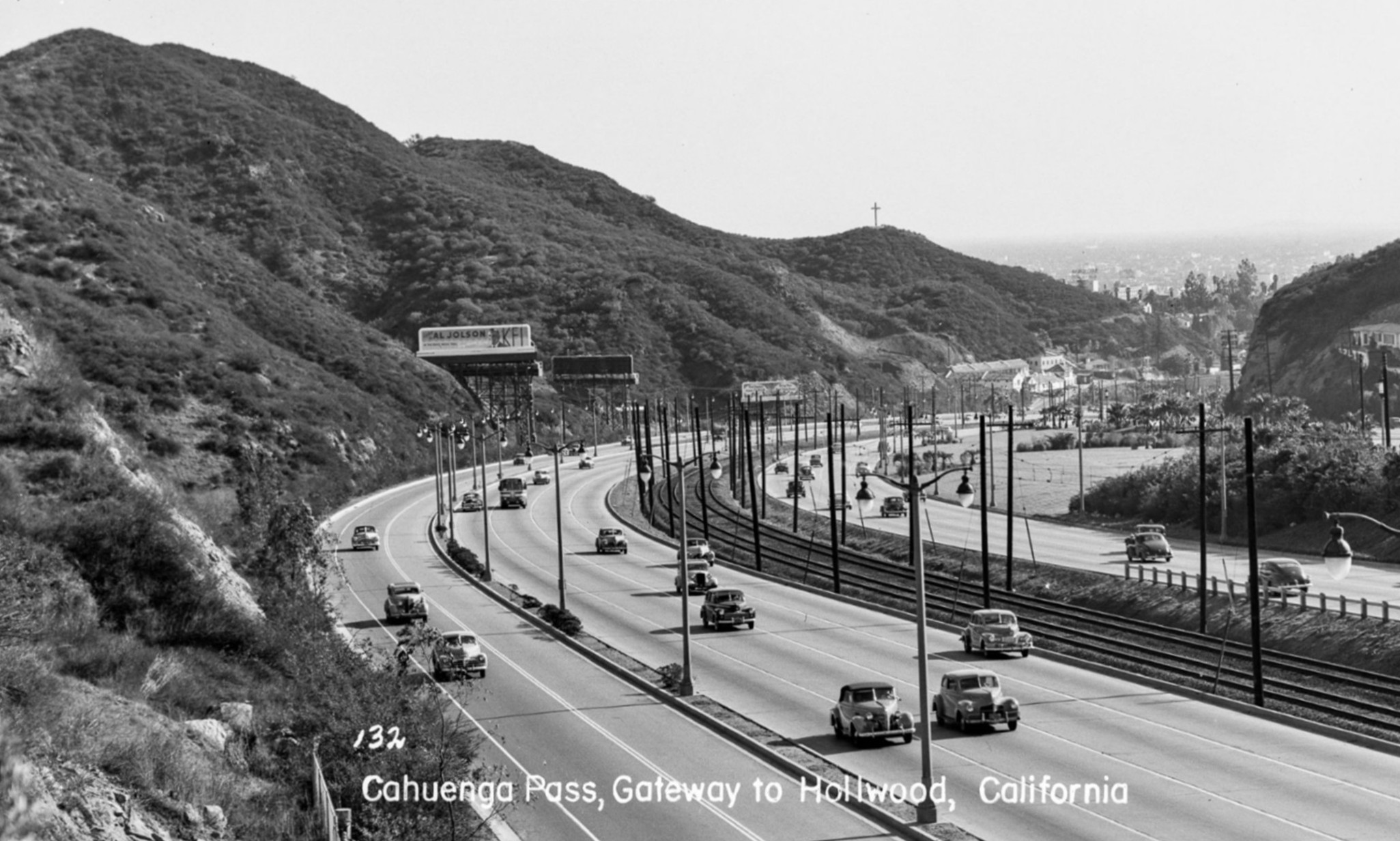 |
|
| (1940s)* – Cahuenga Pass, Gateway to Hollywood, as seen from near the Mulholland Drive Bridge. Photo by Bob Plunkett from the Ernest Marquez Collection. |
Historical Notes Cars glide through the Cahuenga Parkway, part of U.S. Route 101, as it winds through the pass toward Hollywood. The 40-foot Hollywood Pilgrimage Memorial Cross, installed in 1923, rises on the hilltop above the Pilgrimage Theatre. A rooftop sign promotes Al Jolson on KFI radio. |
* * * * * |
Cahuenga Pass Parkway
.jpg) |
|
| (ca. 1940)* - Panoramic view of Hollywood looking northwest toward the Cahuenga Pass. The newly constructed Hollywood Freeway through Cahuenga Pass (known as Cahuenga Pass Parkway) is visible at the top of the photo, with the San Fernando Valley far off in the distance (compare to previous photo). |
Historical Notes Built at a cost of $1.5 million and partly financed by the federal Public Works Administration (PWA), the two-mile Cahuenga Pass Parkway eliminated a notorious bottleneck at the place where one of the state's first highways -- El Camino Real -- crossed the Santa Monica Mountains. |
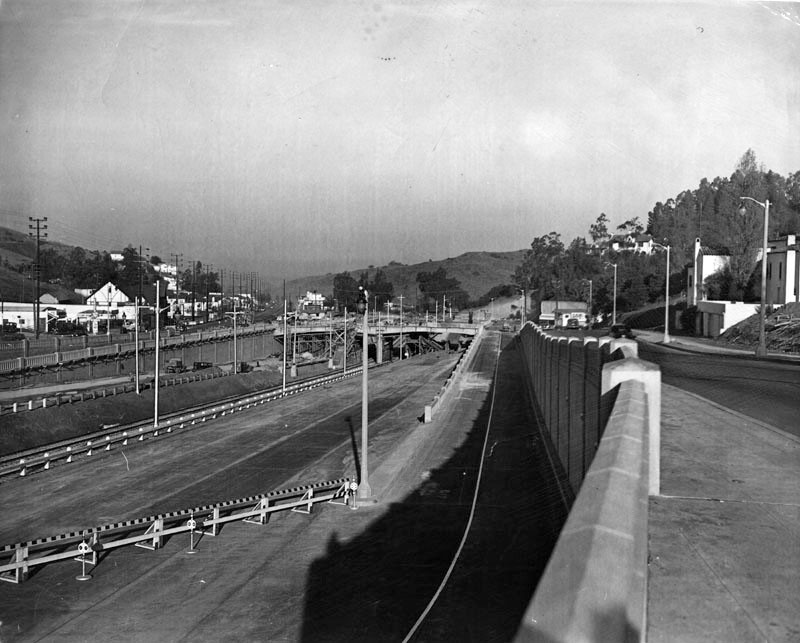 |
|
| (1940)* – View showing the new Cahuenga Pass Parkway at the Barham exit before its official opening. |
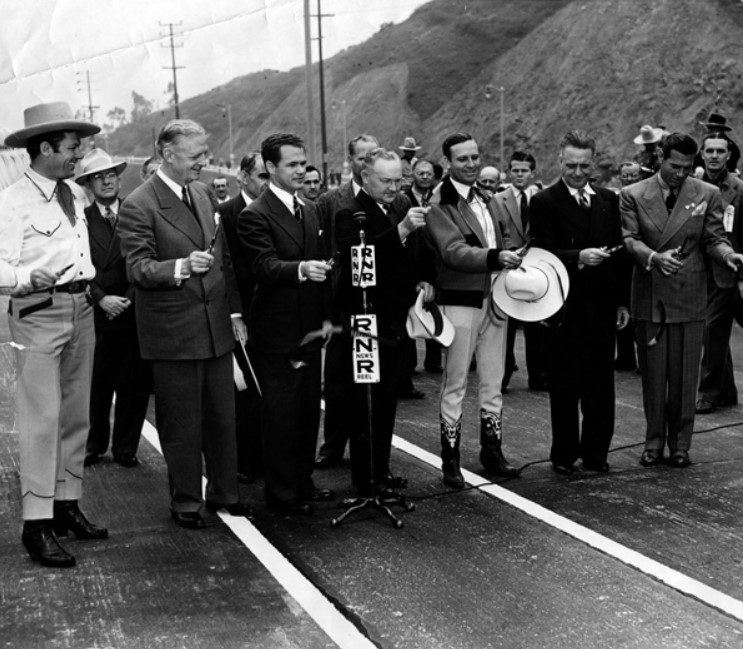 |
|
| (1940)* - View showing the dedication ceremony for the Cahuenga Pass Parkway on Jun 15, 1940. |
Historical Notes From left to right: Tom Keene, honorary mayor of Sherman Oaks, Governor Culbert Olson, John B. Kingsley, president of Hollywood Chanber of Commerce, Mayor Fletcher Bowron of Los Angeles, actor and singer Gene Autry, honorary mayor of North Hollywood, Mayor Frank C. Gillson of Burbank, and actor Richard Arlen. |
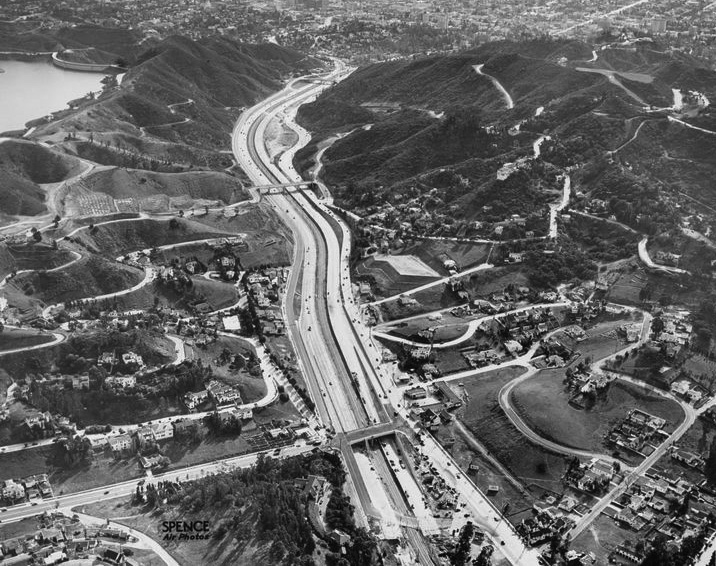 |
|
| (1940)* - Aerial view looking southeast showing the new Cahuenga Pass Parkway with the Hollywood Reservoir seen at upper left. |
Historical Notes The Cahuenga Pass Parkway replaced a narrow, winding road between Hollywood and the San Fernando Valley with an eight-lane superhighway. A pair of Pacific Electric rails ran down the freeway's center divider. |
 |
|
| (ca. 1940)* – View looking north toward the Mulholland Drive Bridge showing traffic in both directions of the Cahuenga Pass Parkway. |
 |
|
| (ca. 1940)* - View shows the Cahuenga Pass Parkway, later the Hollywood Freeway, near the Hollywood Bowl. Mulholland Drive Bridge (built in 1940) can be seen in the background. A car appears stopped on the side of the freeway. |
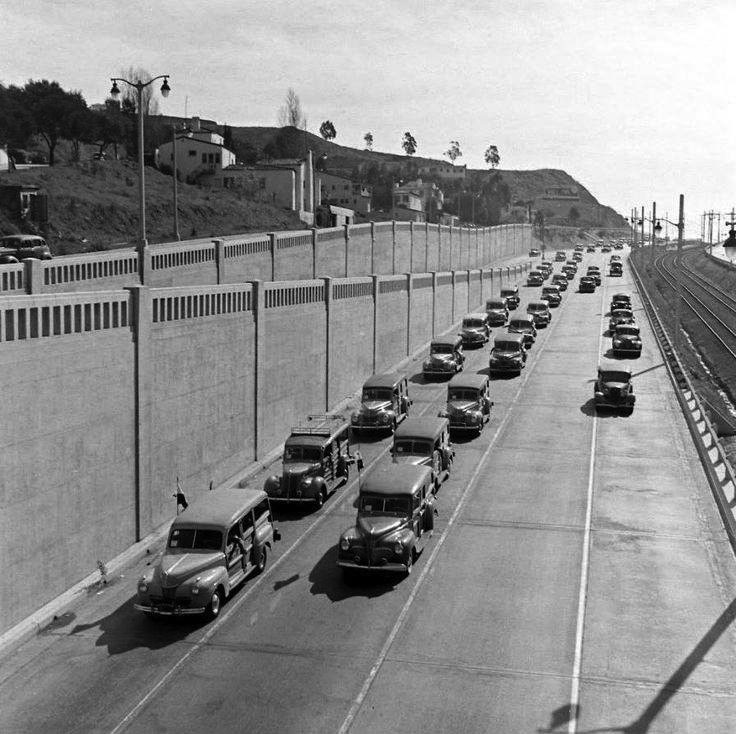 |
|
| (ca. 1942)* - View showing a caravan of woody wagons (aka "Station Wagon Brigade") heading north through Cahuenga Pass near the Barham exit. |
Historical Notes Also known as the 1st Evacuation Corps, the "Station Wagon Brigade" was formed in response to the fears that the anticipated Japanese invasion would require a massive evacuation of Southern California. Sort of like the “taxicab army” of the First World War, it was planned to organize and use civilian station wagons to evacuate families and individuals without personal transportation. |
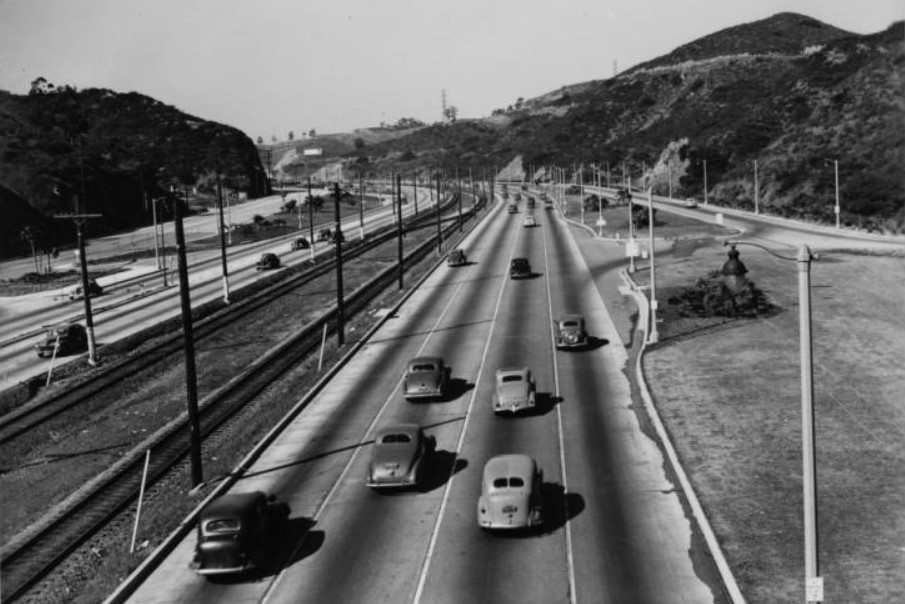 |
|
| (1943)* - View looking northwest of Cahuenga Pass Parkway with fairly light traffic. Note the Pacific Electric tracks in the center median. |
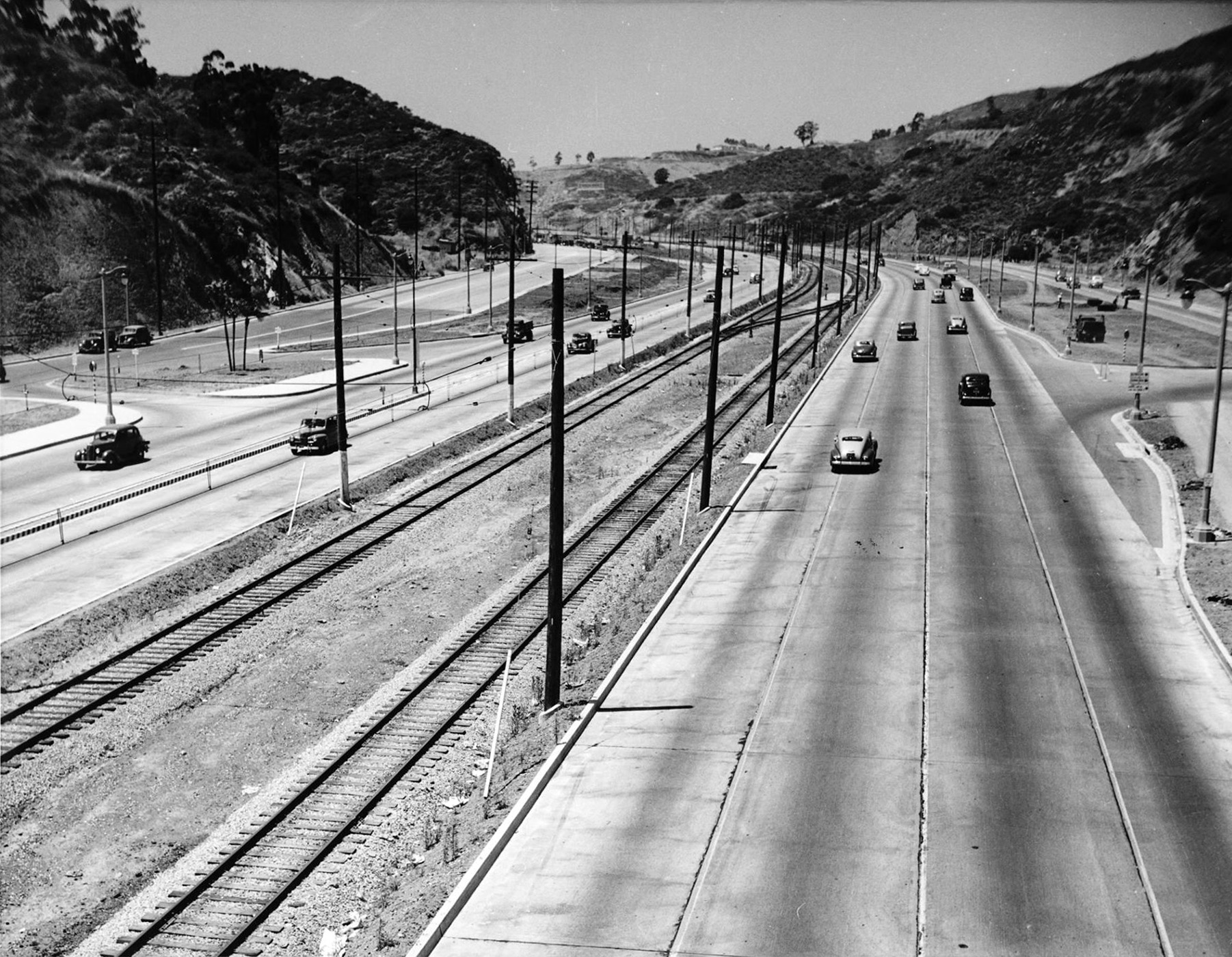 |
|
| (1940s)* – Close-up view showing the tracks in the center median of Cahuenga Pass. |
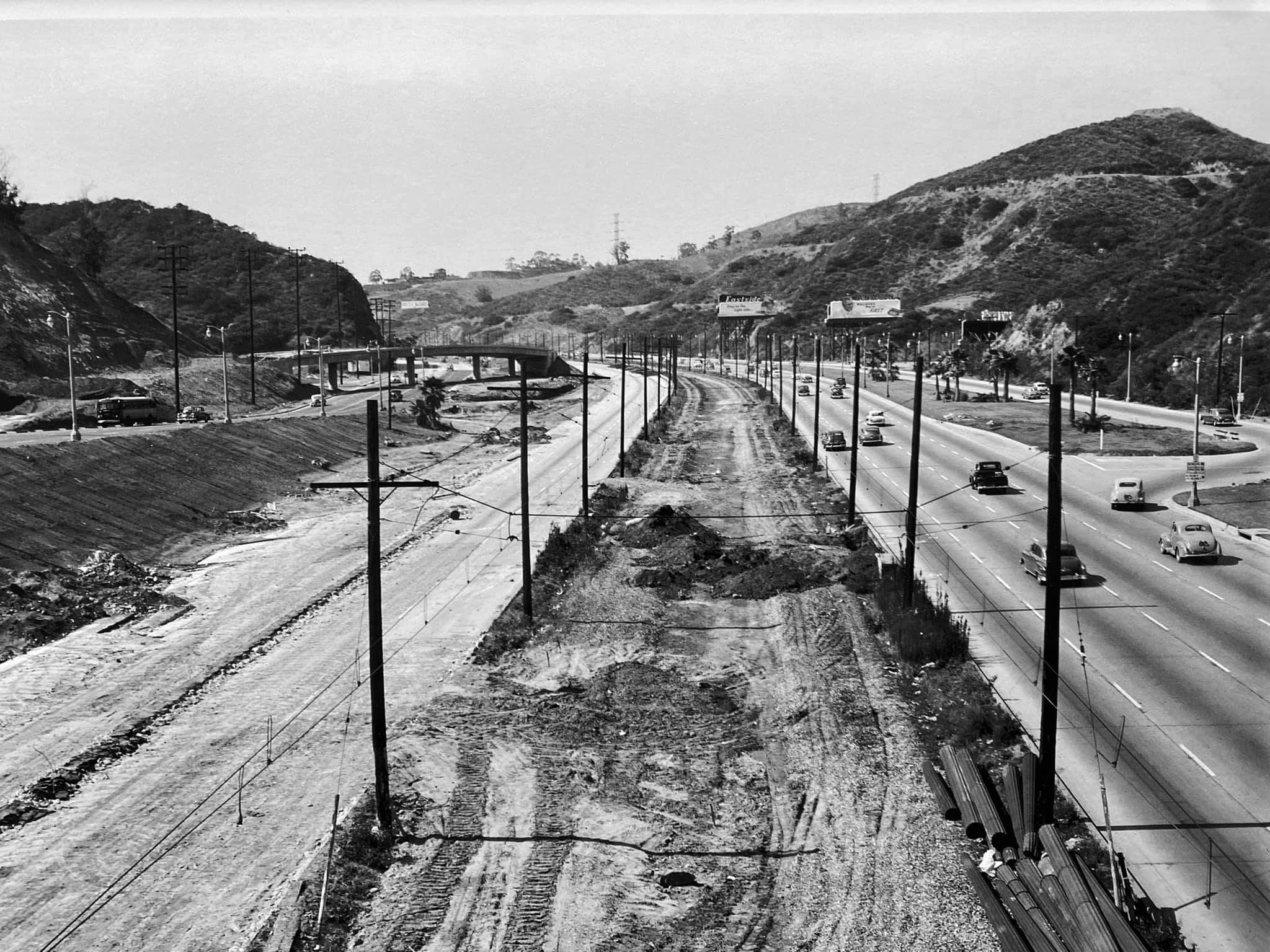 |
|
| (1953)* - Cahuenga Pass after the center median tracks have been removed (compare to previous photo). In the distance can be seen the Highland off-ramp under construction. 1952 was the last year Pacific Electric Railway trolleys ran down the center of the "Cahuenga Pass Freeway", (Hollywood Freeway). Photo by Richard C. Miller |
* * * * * |
Mulholland Bridge
 |
|
| (1947)*^#* – Postcard view looking southeast showing the Mullholland Drive Bridge (built in 1940) crossing the Cahuenga Pass Freeway (later Hollywood Freeway), the “Gateway to Hollywood", with Mulholland Drive winding up into the Hollywood Hills in the upper-right. |
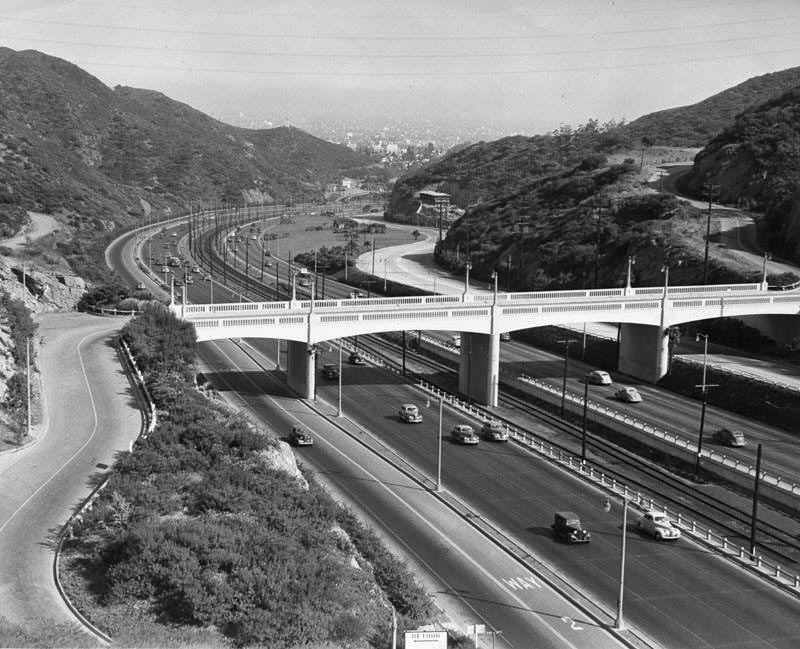 |
|
| (1947)* - View of Cahuenga Pass looking towards Hollywood at the Mulholland Bridge. |
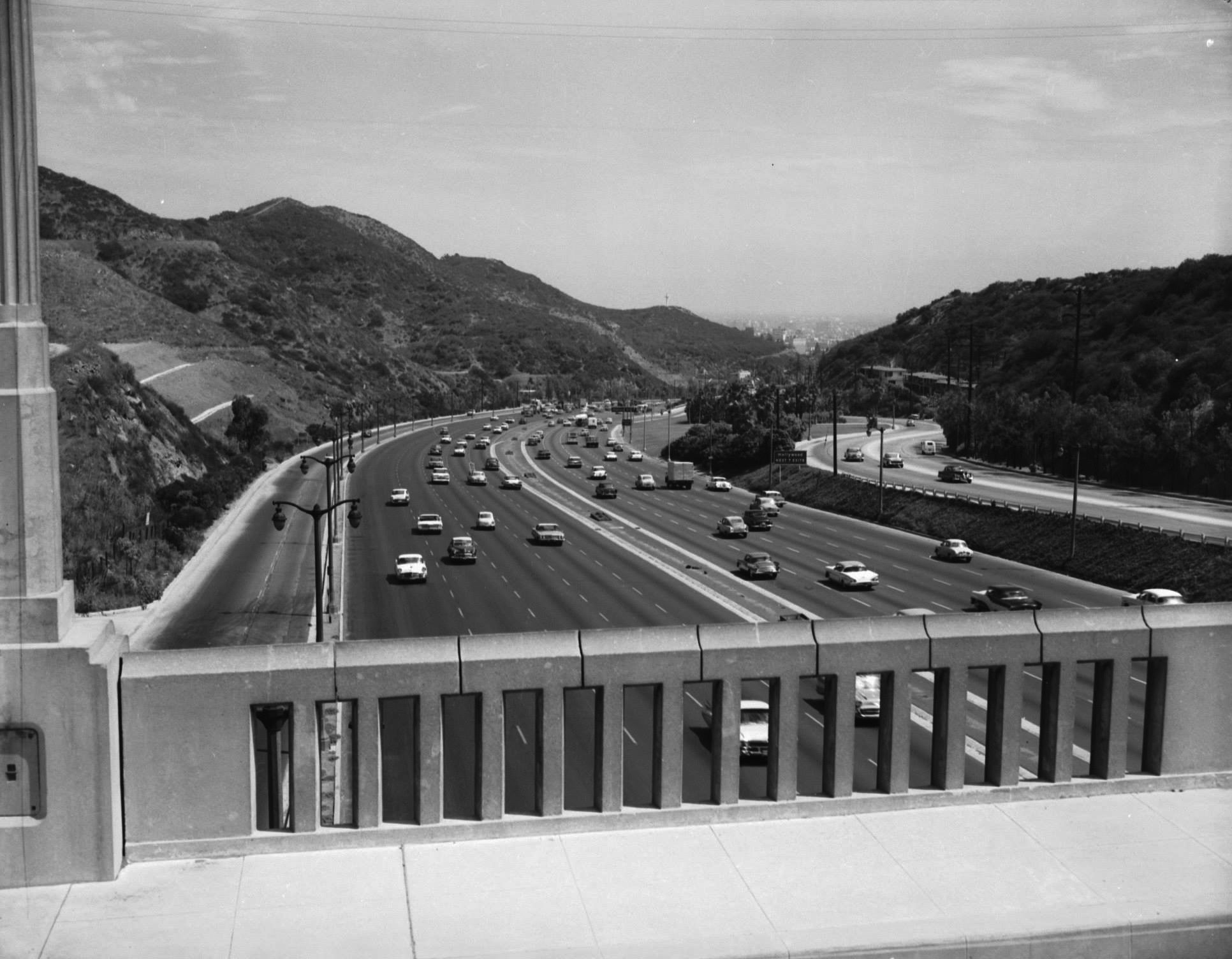 |
|
| (1950s)* – Cahuenga Pass as seen from the Mulholland Overpass looking towards Hollywood. |
Franciscan Motel
 |
|
| (1949)* - View showing the Franciscan Motel, overlooking the Hollywood Bowl. Photo by Julius Shulman. |
Historical Notes The buildings nearest the freeway were demolished sometime between 1972 and 1980. The ones at the back of the lot, however, survive today. They are now in what seems to be the north parking lot of the Ford Theatre. Click HERE for contemporary view. |
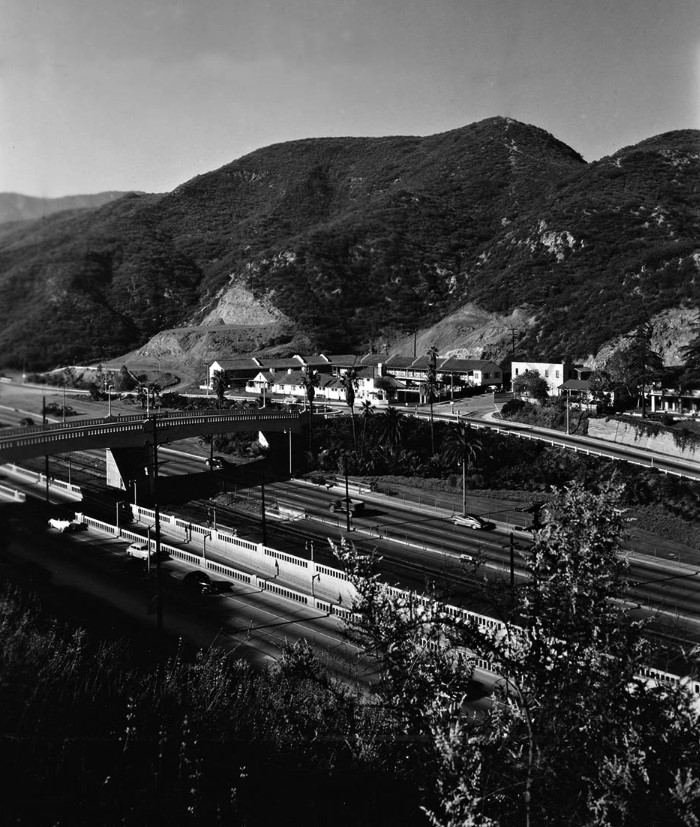 |
|
| (1949)* – View looking northwest across Cahuenga Pass. The complex on the north side of the pass is the Franciscan Motel (no longer standing) whose entrance was directly opposite the Pilgrimage Bridge. Click HERE for contemporary view. |
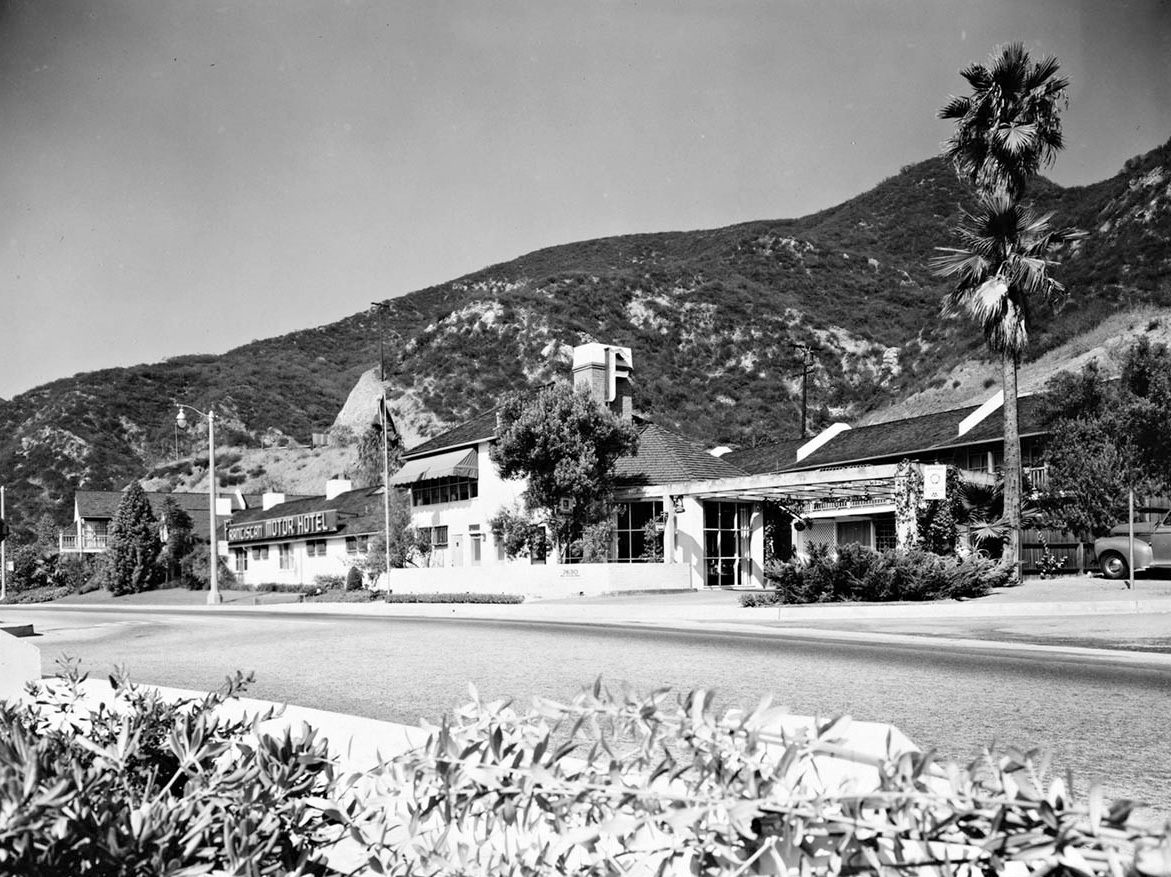 |
|
| (1951)* – Close-up view showing the front of the Franciscan Motel in Cahuenga Pass. Photo by Julius Shulman |
Cahuenga Pass Extension to Vineland
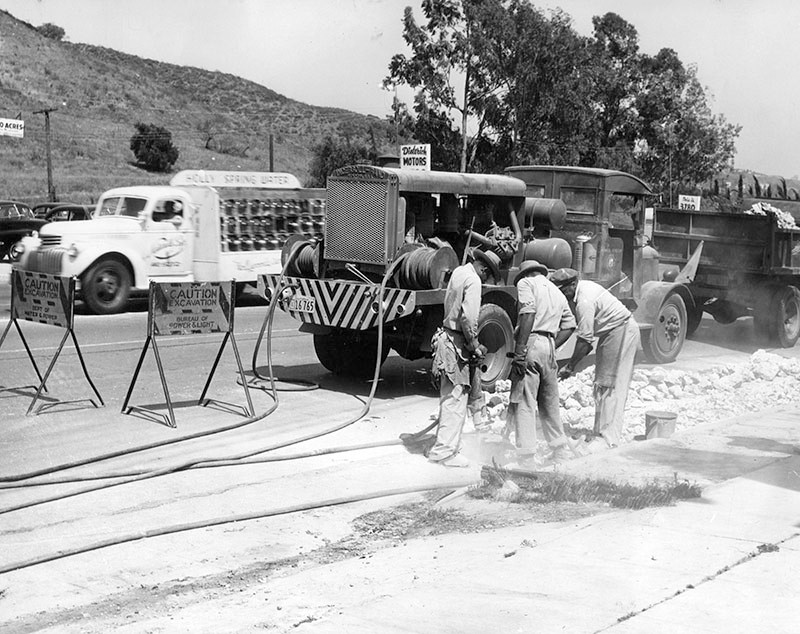 |
|
| (1947)* - Photo caption dated June 14, 1947 reads, "Extension of the Hollywood freeway along Ventura boulevard to Vineland avenue started with the thunder of air-hammers at Universal City, as the last cars to use the intersection of Lankershim and Ventura boulevard whizzed by in back of the workmen. A detour soon will go around the intersection." |
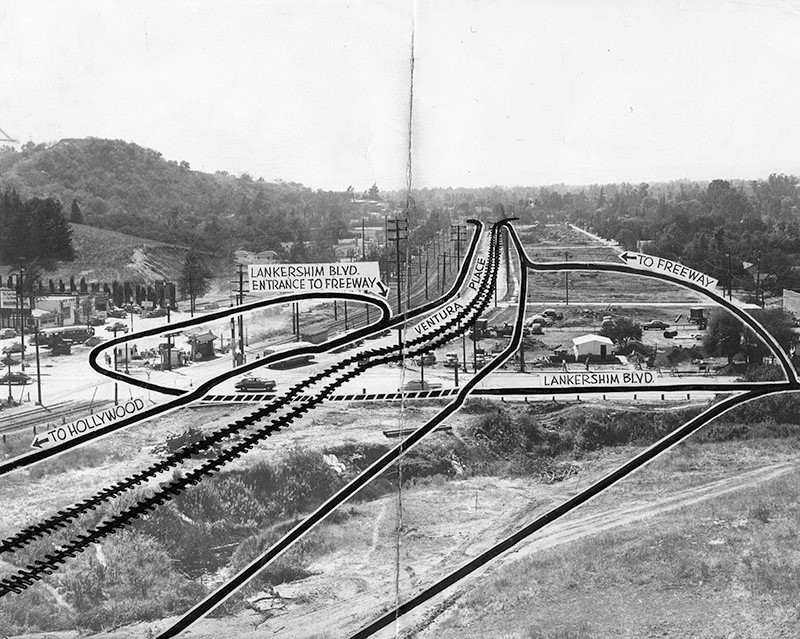 |
|
| (1947)* - Photograph caption dated July 12, 1947 reads, "Most complex part of the new freeway link connecting Vineland avenue and Cahuenga Pass will be at Universal City, above, where a grade separation will be constructed over Lankershim boulevard. |
Historical Notes This Valley Times photo-diagram shows where rail lines will be relocated down the center of the new freeway link. Traffic leading into the Valley will follow the lane on the right of the tracks; that leading to Hollywood will stream down a parkway at the left of the rail lines. Lankershim boulevard traffic onto the freeway's Hollywood-bound lane will go under the freeway and rise on a looped ramp as shown at left. Lankershim traffic into the Valley-bound freeway lane will follow the road at upper right. To get onto Lankershim from the right hand freeway lane, cars will use the road shown in right lower foreground. |
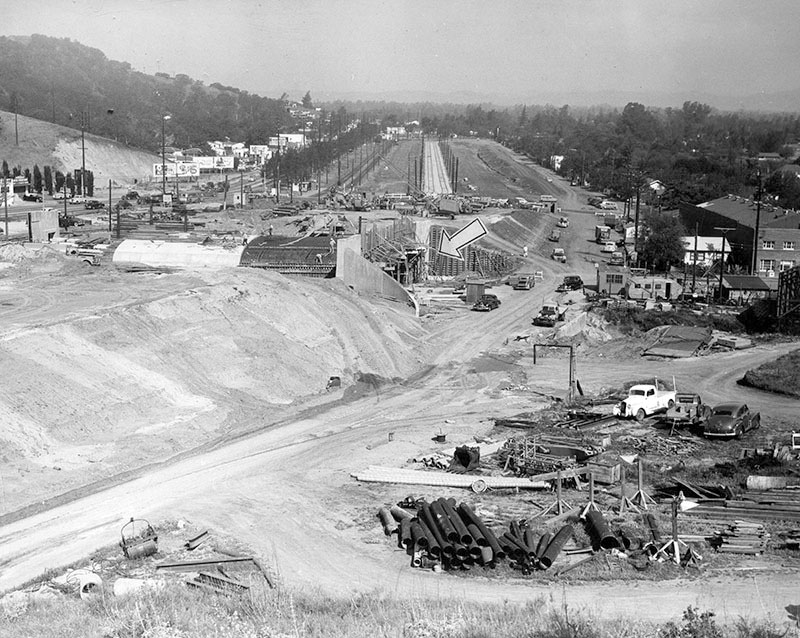 |
|
| (1948)* - Photograph dated May 8, 1948 shows the construction of a freeway underpass at Lankershim and Cahuenga boulevards. The project is part of the extension of the Hollywood Freeway connecting Vineland Avenue and the Cahuenga Pass. |
Historical Notes The bridge/tunnel was built as part of the Cahuenga Freeway; it is now known as the Lankershim/101 Freeway Bridge and Tunnel. |
 |
|
| (1948)* - View showing paving of Hollywood Freeway lanes that extend from the Cahuenga Pass to Vineland Avenue. In between the freeway lanes are electric lines used by Pacific Electric trains. Photo date: November 10, 1948 |
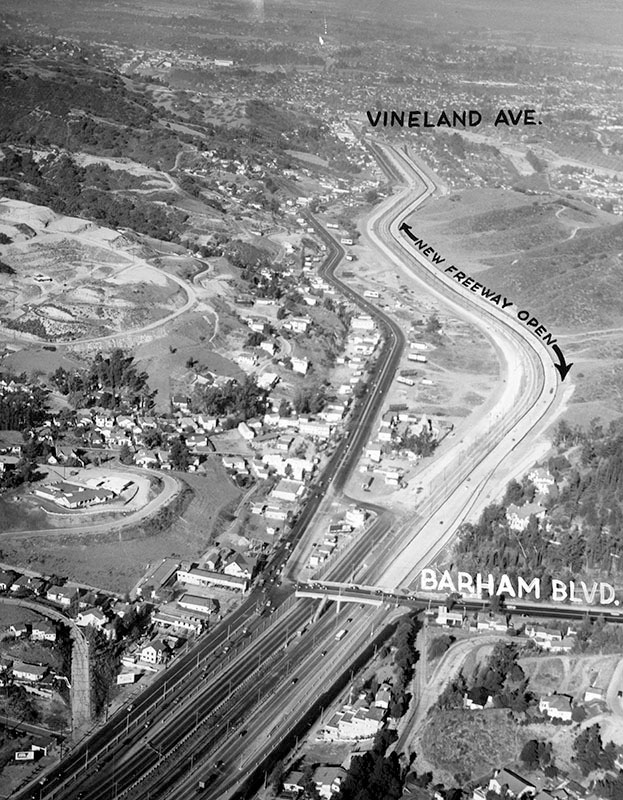 |
|
| (1948)* - Aerial view of the Hollywood Freeway extension from Barham Boulevard to Vineland Avenue. Universal City is seen to the right of the freeway, and Studio City to the left. Phote date: November 14, 1948 |
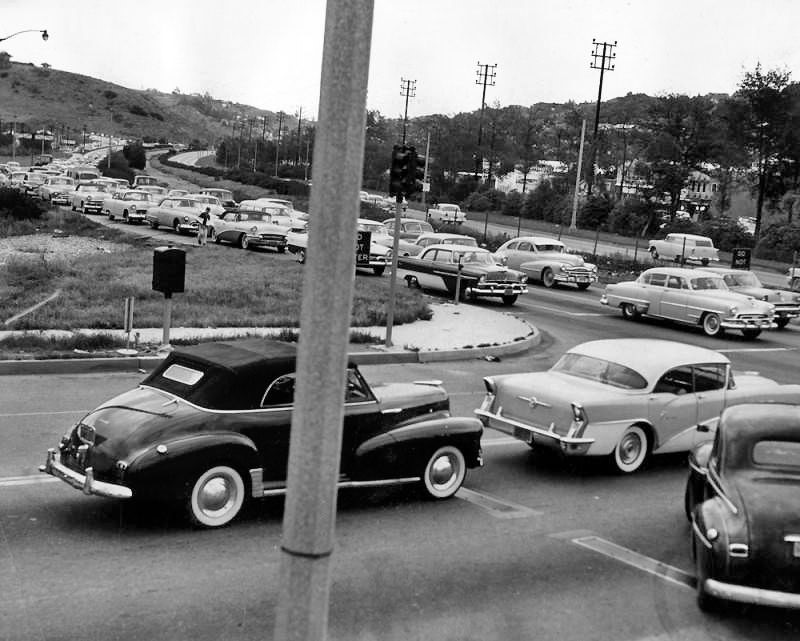 |
|
| (1956)* - Intersection of Vineland and the end of the Hollywood Freeway extension through Cahuenga Pass. |
Historical Notes Photograph caption dated April 30, 1956 reads, "May be city's busiest intersection - Pouring from all directions, cars meet at intersection of Vineland avenue and Ventura boulevard, labeled as 'possibly Los Angeles' busiest intersection' by Traffic Manager Lloyd Braff. Last count indicates 86,000 cars pass through here over 24-hour period." - Valley Times |
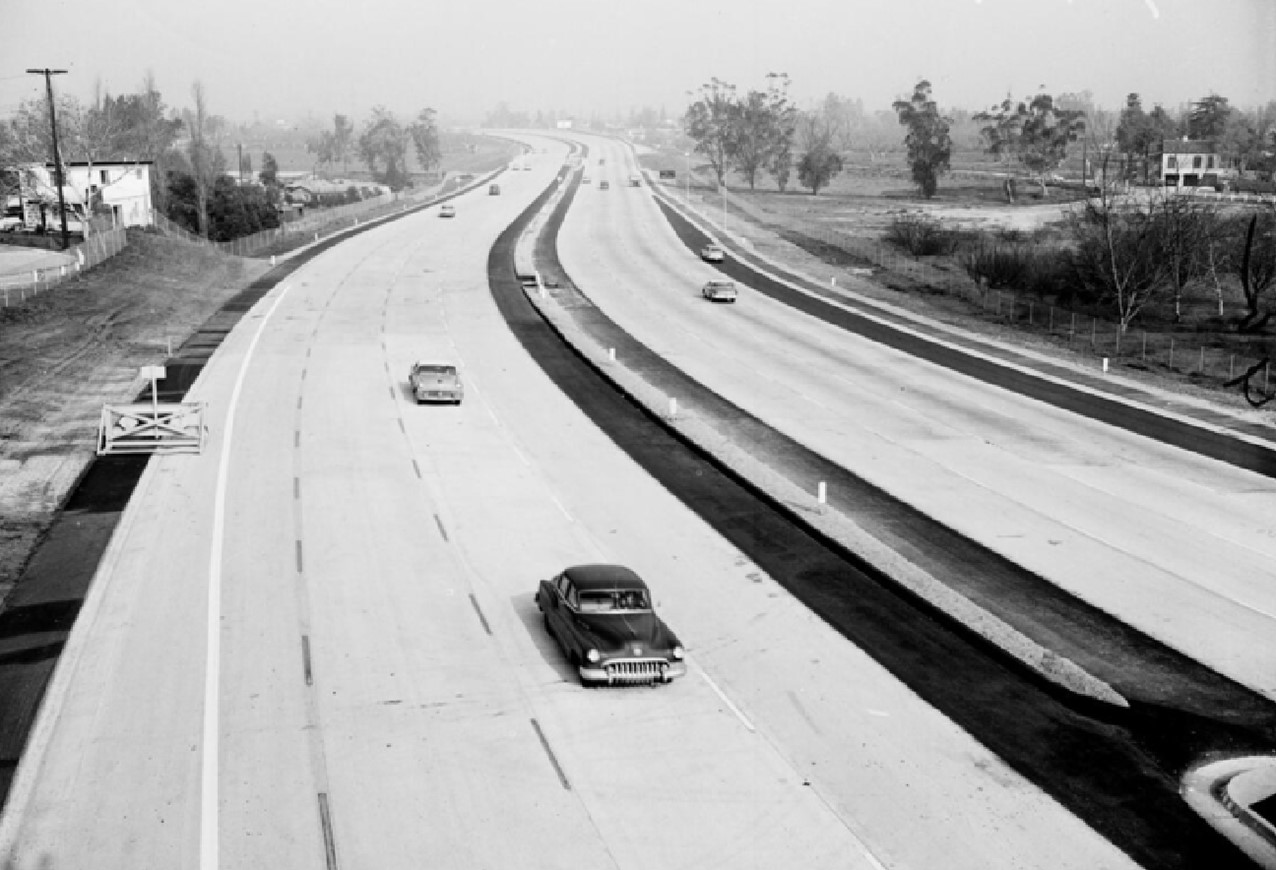 |
|
| (1958)* - Opening of new Hollywood Freeway link from Vineland to Moorpark. Photo date: Feb 7, 1958 |
* * * * * |
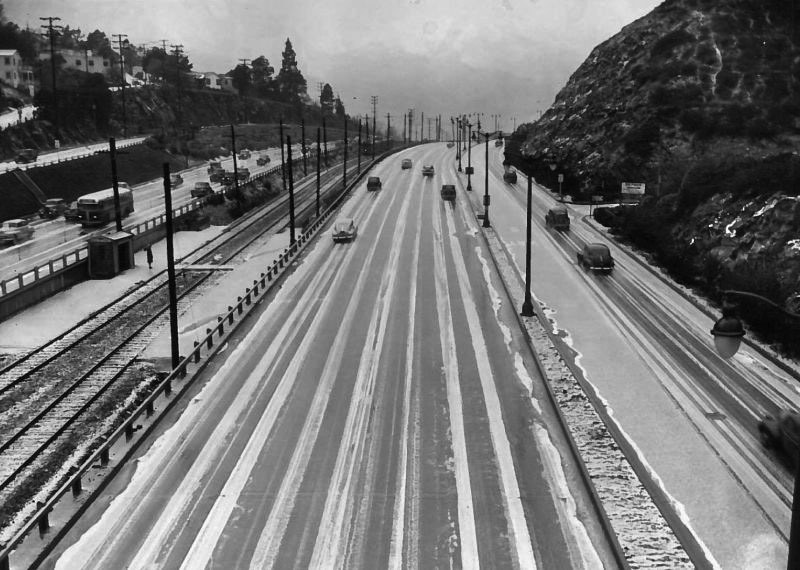 |
|
| (1948)^^ - View looking toward the San Fernando Valley showing a rare sight - freshly fallen snow in Cahuenga Pass. |
Historical Notes Snow is a rare occurrence in the Los Angeles Basin. While it's common in the region's mountains, the moderating effect of the Pacific means that at lower elevations temperatures rarely fall below the point necessary to create snow. Since records were first kept in 1921, snow has fallen on downtown Los Angeles only ten times—and not once since 1962. |
 |
|
| (1948)* - View of Cahuenga Pass Freeway with snow already melted on the pavement. Northbound freeway lanes are completely empty. |
Pacific Electric Red Cars - Cahuenga Pass
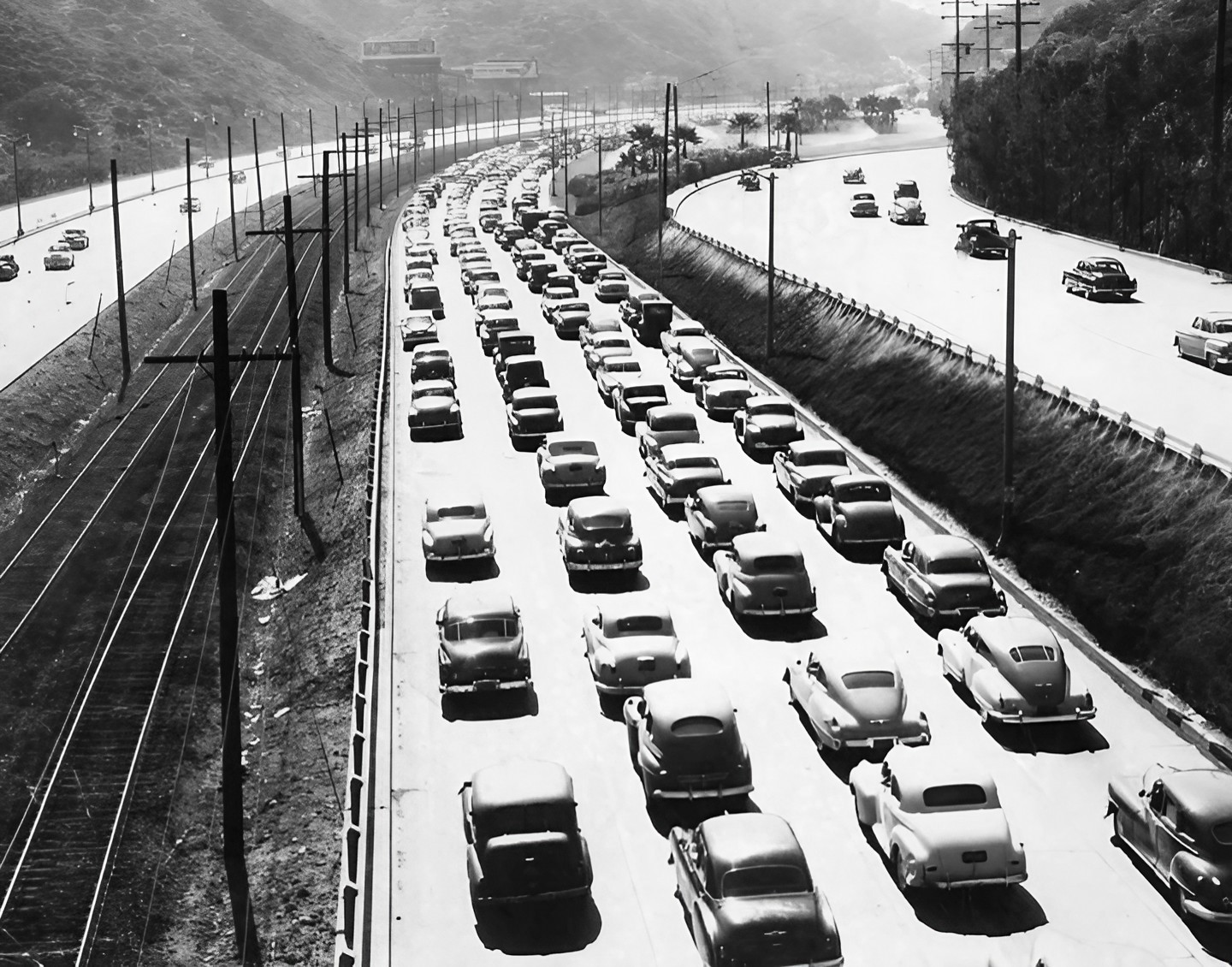 |
|
| (1948)* - View of Cahuenga Pass during rush hour, showing a line of cars bumper to bumper heading into the city from the San Fernando Valley, with Pacific Red Car tracks on the left. |
Historical Notes The Pacific Electric (PE) streetcar line through Cahuenga Pass was a critical transportation infrastructure that connected Los Angeles to the San Fernando Valley in the early 20th century. Completed in 1911, the line was part of PE's Western Division and played a pivotal role in regional development. Initially running on its own right-of-way west of the state highway, the route was later integrated with the Hollywood Subway and eventually relocated to the median of the Hollywood Freeway. |
 |
|
| (1948)* - View looking southeast showing Pacific Red Car, tracks, and the Barham Station at center of Cahuenga Pass. |
Historical Notes The view above is from the top of Barham Bridge which at the time had a stairway running down to the tracks. |
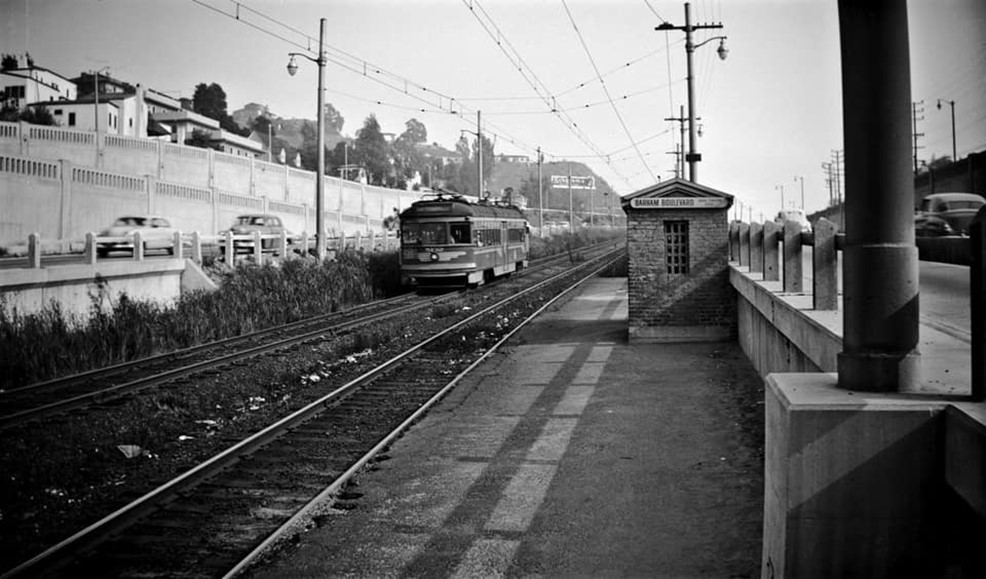 |
|
| (1948)* - Ground view as seen from under the Barham Bridge showing the approach of a Pacific Red Car. |
Historical Notes The line used various Pacific Electric streetcars over its lifetime, including the 5050 Class Hollywood Cars, the last type to operate on the line. Documented streetcar numbers include 5011, 5130, and 5138. |
.jpeg) |
|
| (ca. 1948)* - View looking southeast showing a Pacific Red Car stopped at the Barham Station with the Barham Bridge in the background. |
\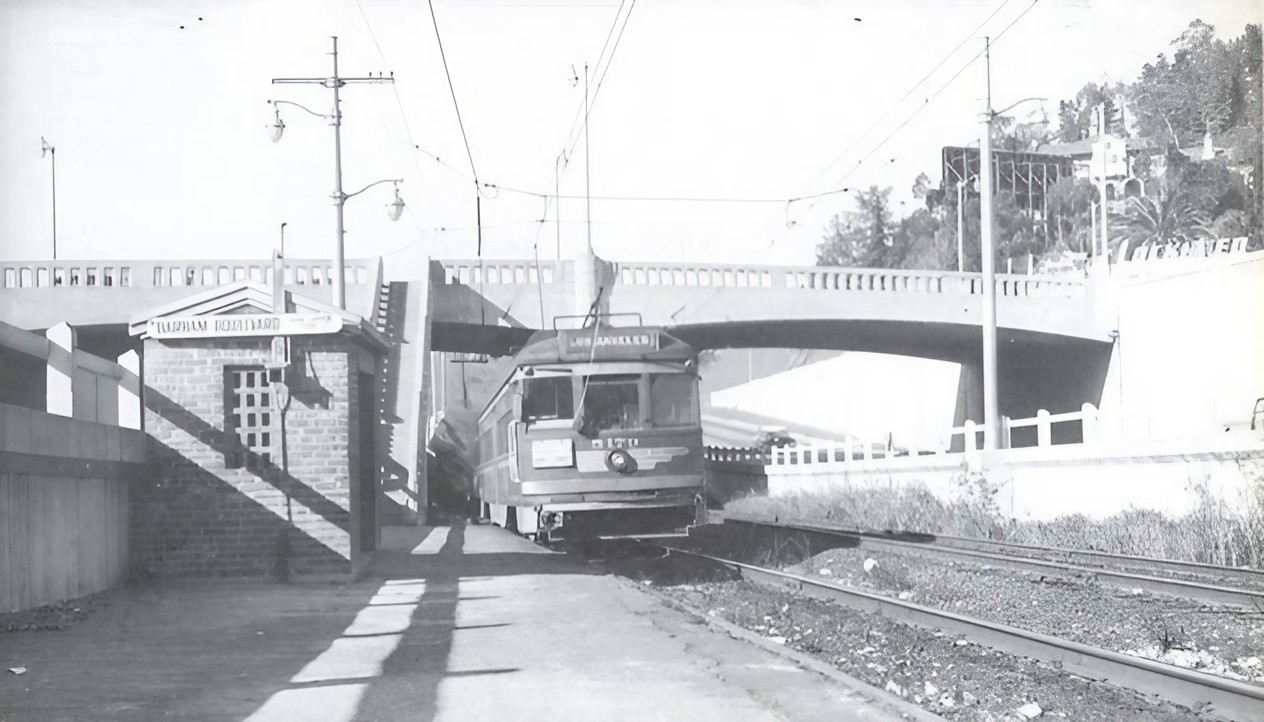 |
|
| (ca. 1950)* - Barham Boulevard Stop. |
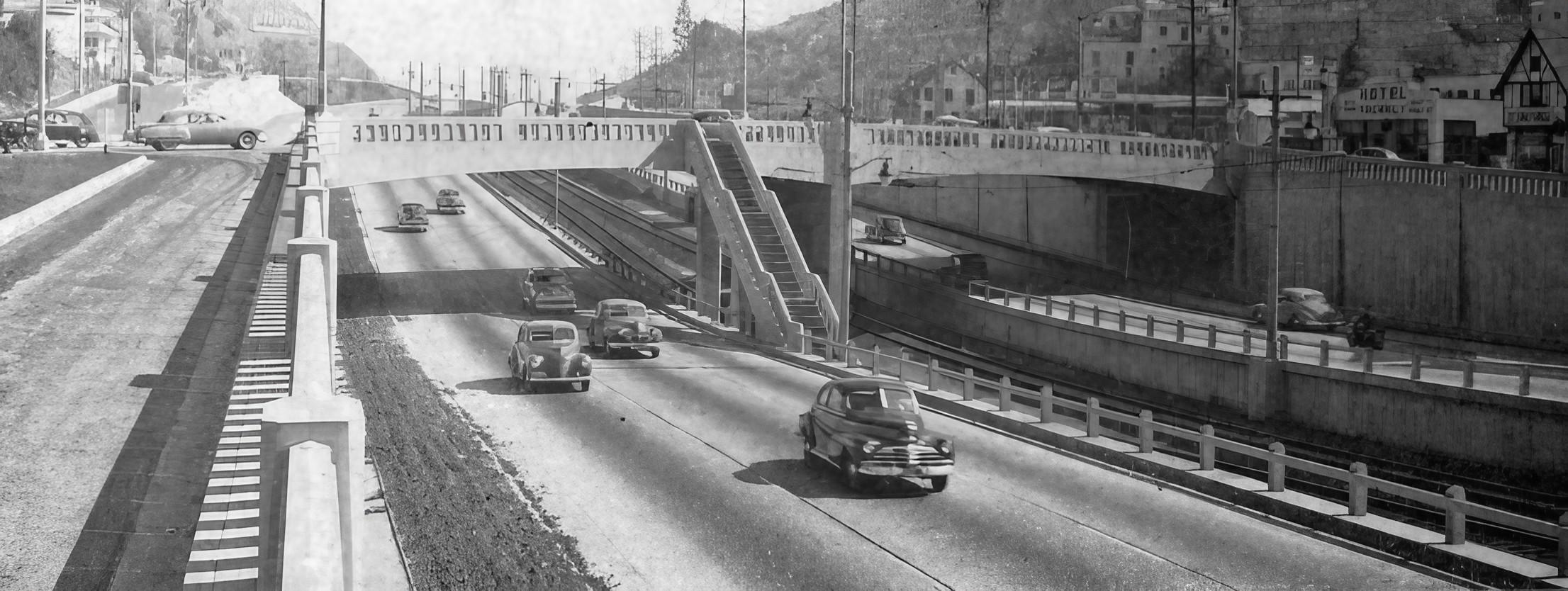 |
|
| (1949)* – Barham Bridge over Cahuenga Pass, looking southeast, with a stairway leading down to the Pacific Red Car tracks in the center median. |
Then and Now
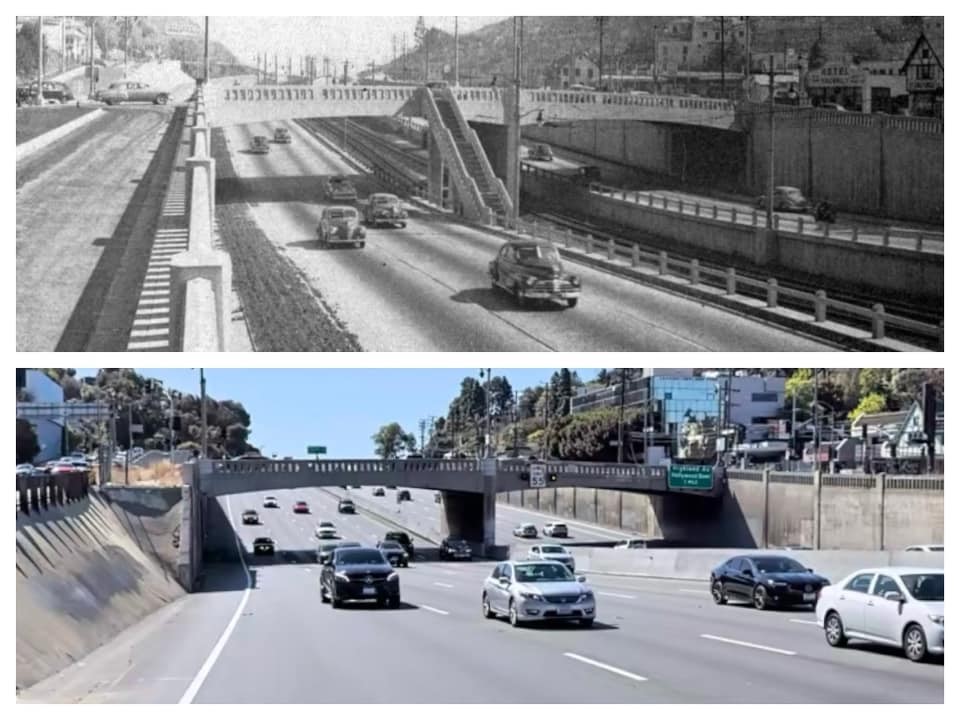 |
|
| (1949 vs 2022)* – Looking southeast toward the Barham Bridge in Cahuenga Pass. Comparison photo by Trey Callaway |
.jpg) |
|
| (1949)* - Early morning commute as cars head into Hollywood and metropolitan Los Angeles from the San Fernando Valley. |
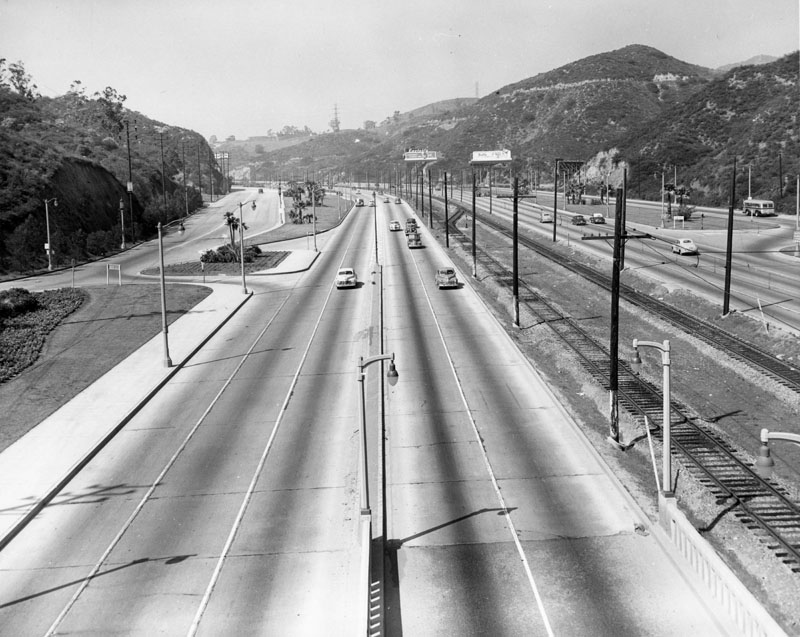 |
|
| (1949)* - View of the roads, rail lines, and cars traveling through the Cahuenga Pass, the most important section of the Hollywood Freeway, which is the "gateway" that opens fast traffic from the San Fernando Valley into Hollywood and the heart of metropolitan Los Angeles. The short city-built Cahuenga Pass Freeway was opened on June 15, 1940. |
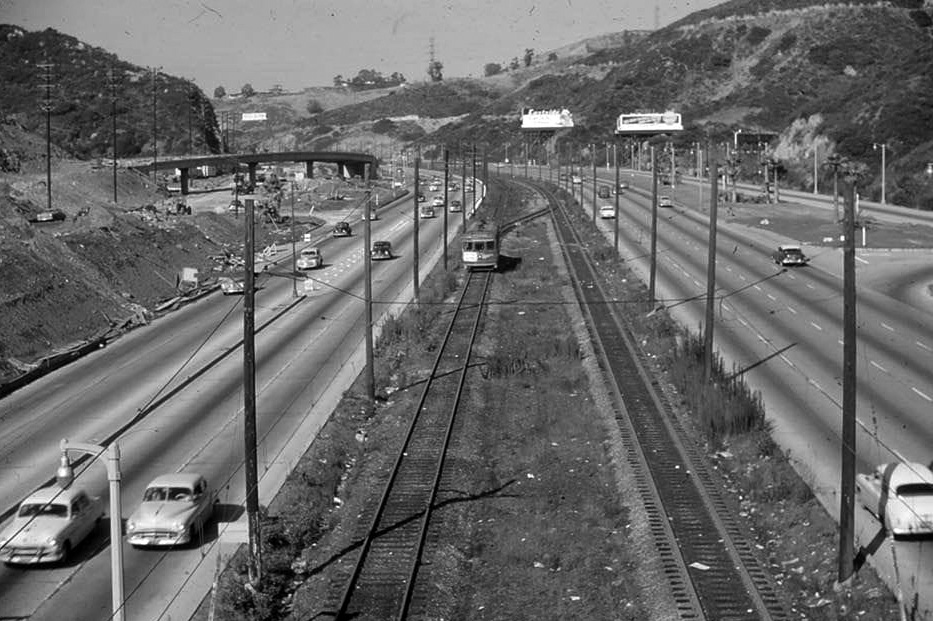 |
|
| (ca. 1950)* - A Pacific Red Car returning from the San Fernando Valley travels along the Cahuenga Pass toward Los Angeles. The Next Stop? The Hollywood Bowl. |
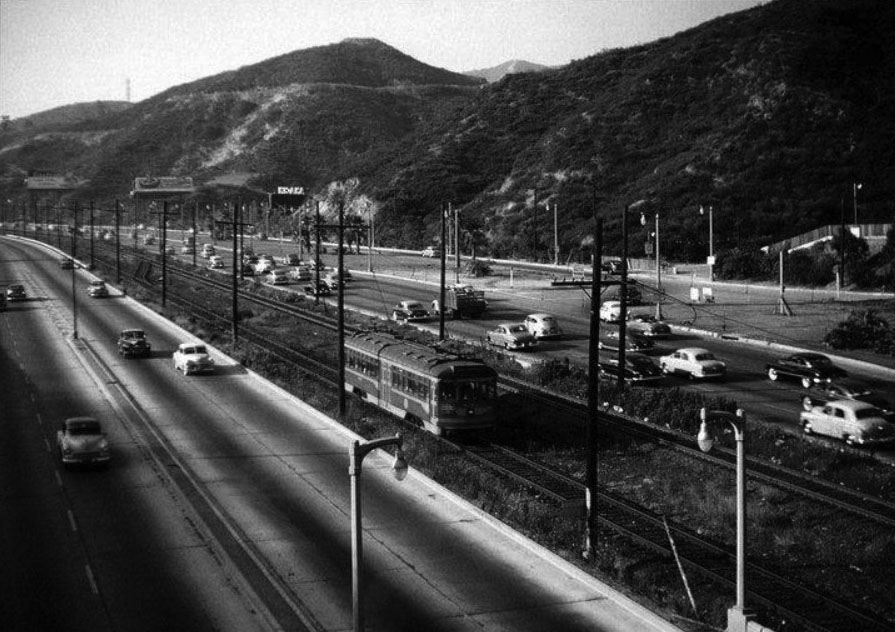 |
|
| (ca. 1950)* - A Pacific Red Car heading toward Hollywood as it travels through Cahuenga Pass. |
 |
|
| (1952)* - A Pacific Electric streetcar coming from the San Fernando Valley through the Cahuenga Pass center median. Photo from the Ernest Marquez Collection. |
Historical Notes The San Fernando PE Line, which encompassed the Cahuenga Pass segment, was an impressive transportation network spanning 27.5 miles and featuring 36 stations. Key stops included the Hollycrest station in the freeway median and a strategic location at the Hollywood Bowl entrance. Throughout its operational years, the line utilized various streetcar models, with the PE 5050 Class Hollywood Cars being the final type of vehicle used on this historic route. |
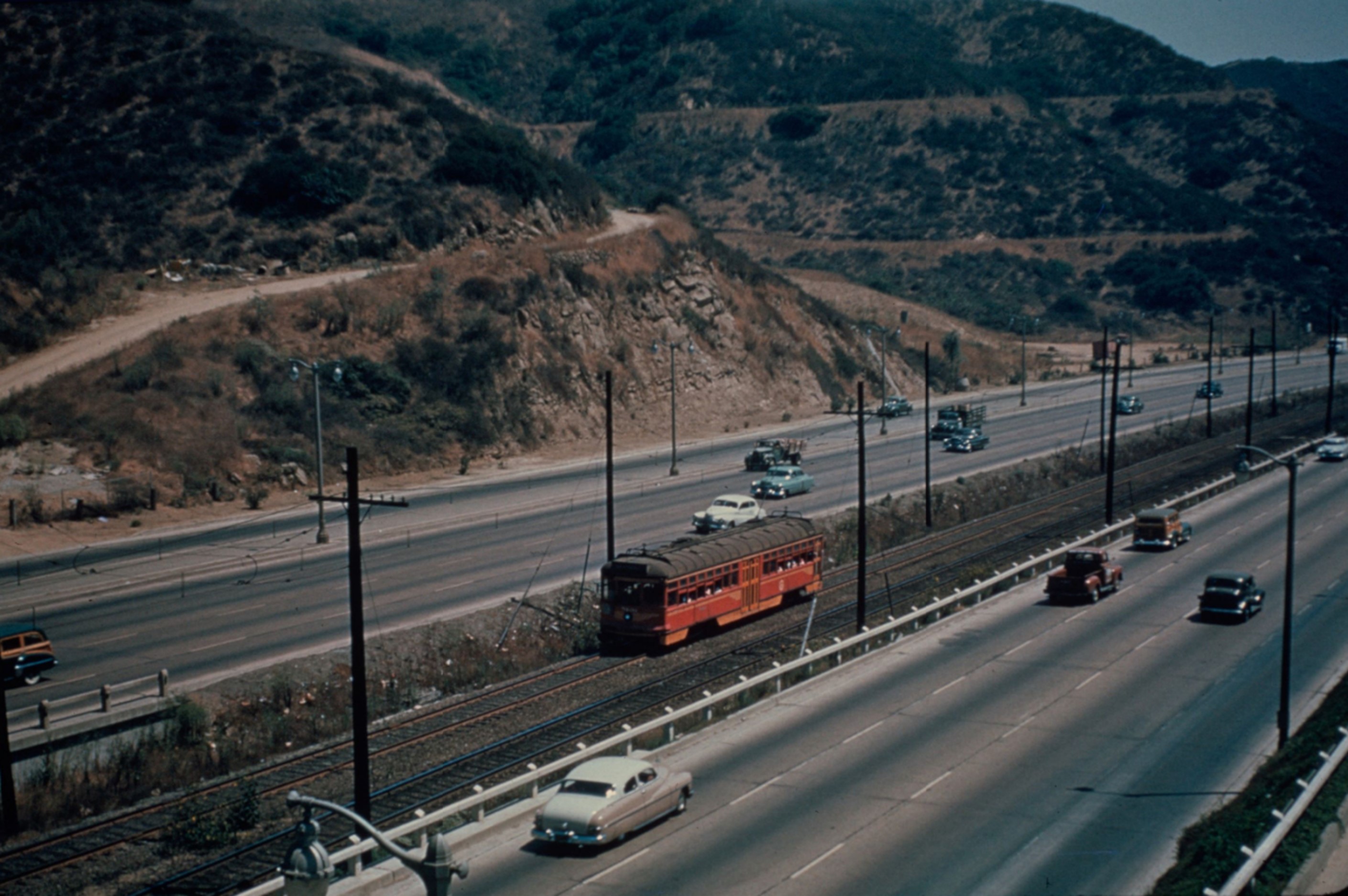 |
|
| (1952)* – Pacific Electric Railway streetcar no. 5138 travels in the median of Highway 101 (Hollywood Freeway) through Cahuenga Pass, on the Van Nuys Line. Photo from the Ernest Marquez Collection. |
Historical Notes Streetcar 5138 holds a special place in the history of this line, as it was the last regular car to depart from Subway Terminal at 1:20 AM on Sunday, December 28, 1952, marking the end of regular service on this route. The Van Nuys Line, which included the Cahuenga Pass segment, was an impressive 27.5-mile network with 36 stations. |
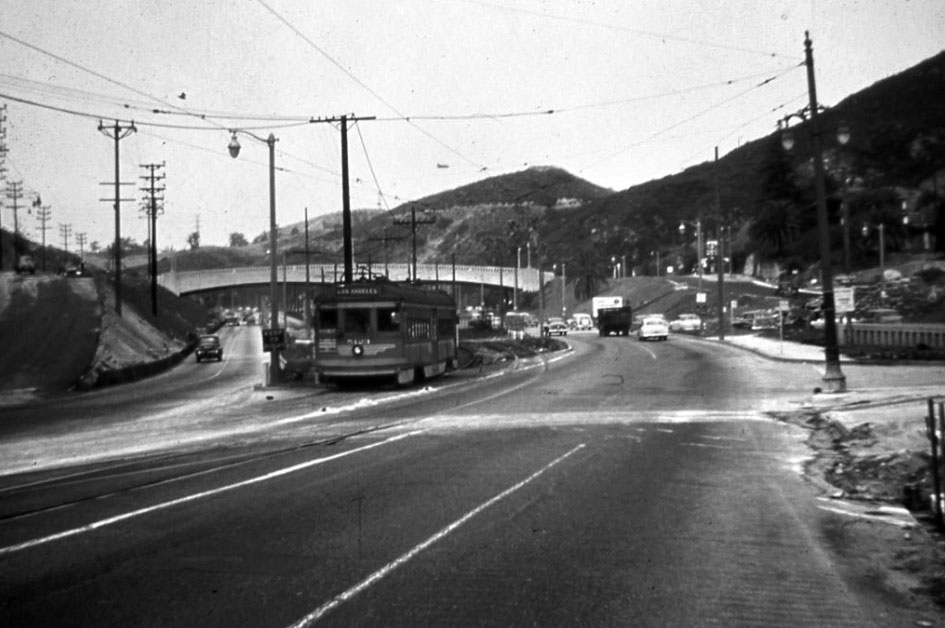 |
|
| (1952)* – View looking north on Cahuenga at Highland Avenue showing a Pacific Red Car heading south toward downtown. |
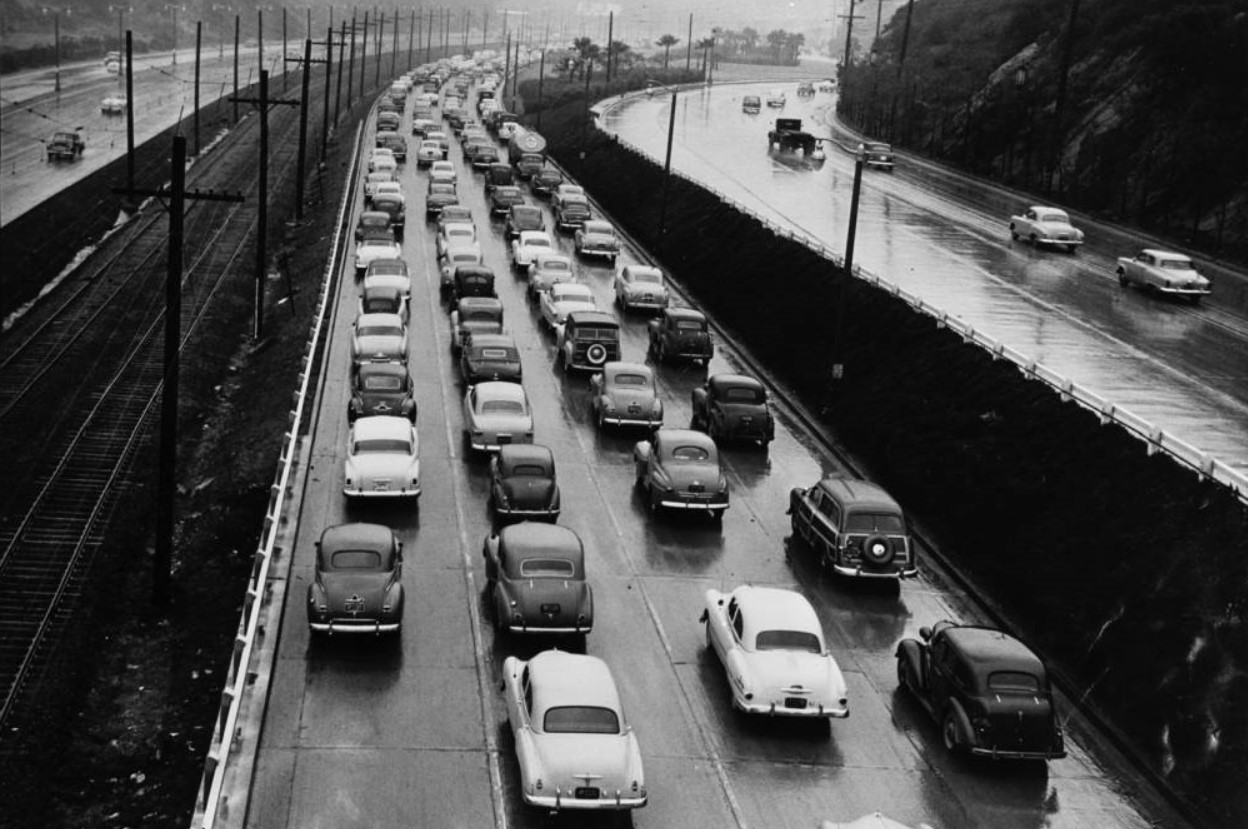 |
|
| (1952)^^ - View of Cahuenga Pass during rush hour traffic on a rainy morning. View is looking southeast toward downtown Los Angeles. |
 |
|
| (1952)* - A Pacific Electric Red Car headed south in the median of the Hollywood Freeway near Barham. |
Historical Notes 1952 was the last year Pacific Electric Railway trolleys ran down the center of the "Cahuenga Pass Freeway", (Hollywood Freeway). |
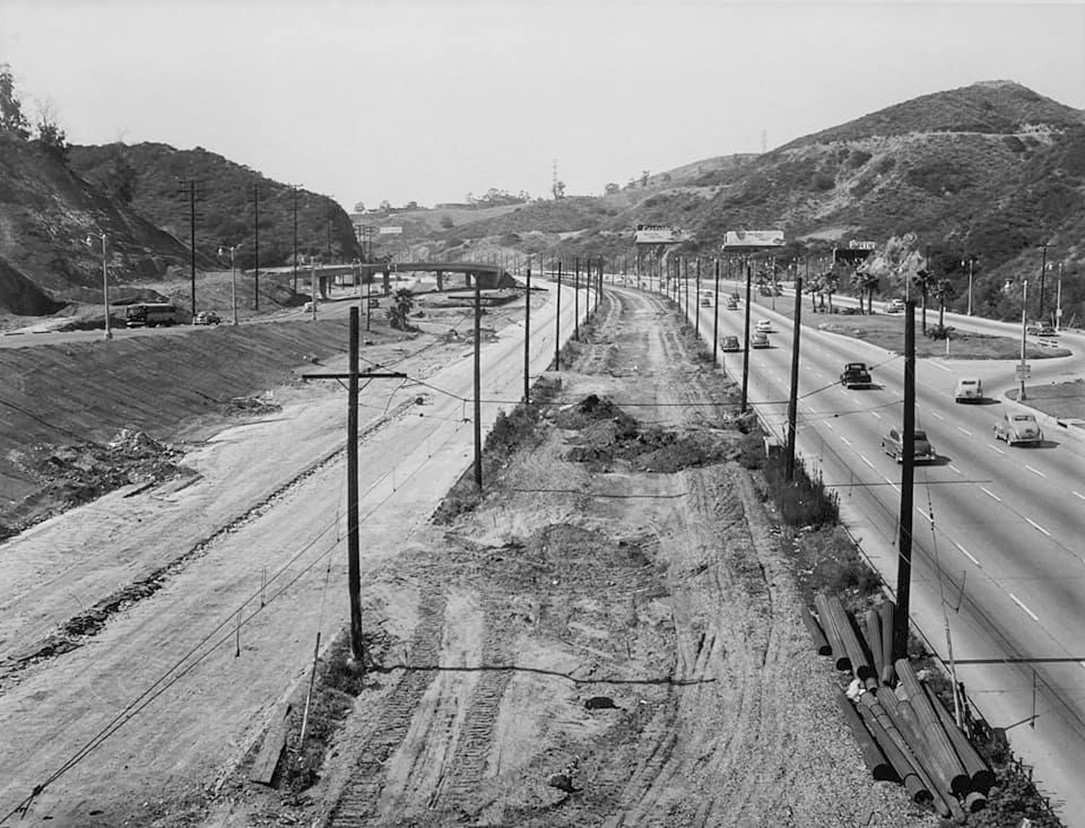 |
|
| (1953)* - Removal of the Red Car tracks in the in the center median of the Cahuenga Pass Freeway, soon to be Hollywood Freeway. View is looking north from the Pilgrimage Bridge near the Hollywood Bowl. |
Historical Notes The decline of the PE streetcar service through Cahuenga Pass was gradual but inevitable. Services were initially truncated to North Sherman Way in 1938, signaling the beginning of the end for this once-vital transportation link. The final day of operation through the pass came on December 28, 1952, when the remaining segment to Van Nuys was permanently replaced by bus services, marking the end of an era in Los Angeles transportation history. |
Before and After
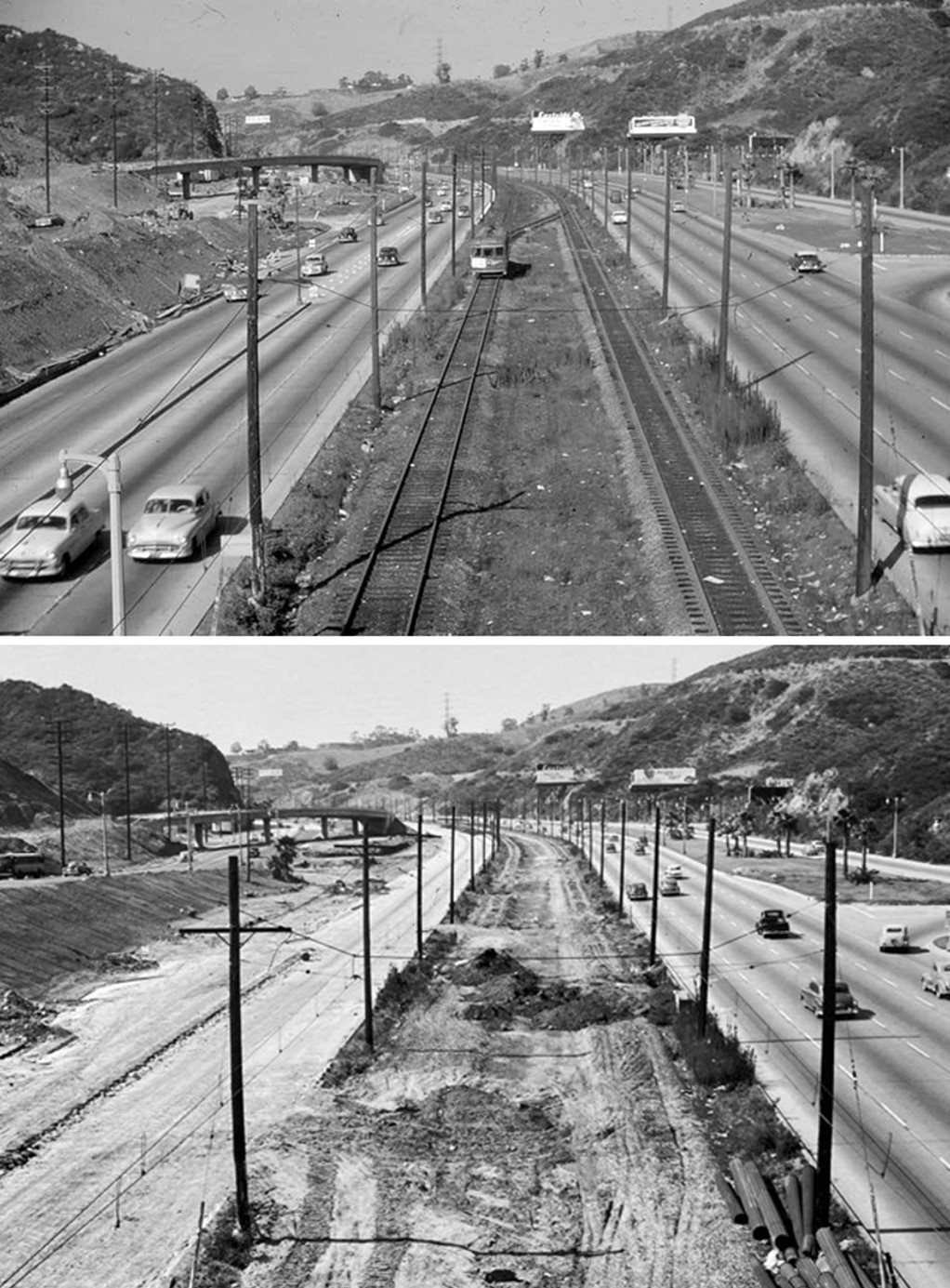 |
|
| (1950 vs. 1953)* - 'Before and After' views of the removal of Red Car tracks from the median of the Cahuenga Pass Freeway (later renamed the Hollywood Freeway), looking north from the Pilgrimage Bridge near the Hollywood Bowl. Photo comparison by Jack Feldman. |
Historical Notes The Pacific Electric Railway trolleys ran down the center of the freeway (then known as the Cahuenga Pass Freeway) until December 28, 1952, when the service was discontinued and replaced by buses. Following the end of trolley service, the tracks were removed from the freeway's median strip in 1953. |
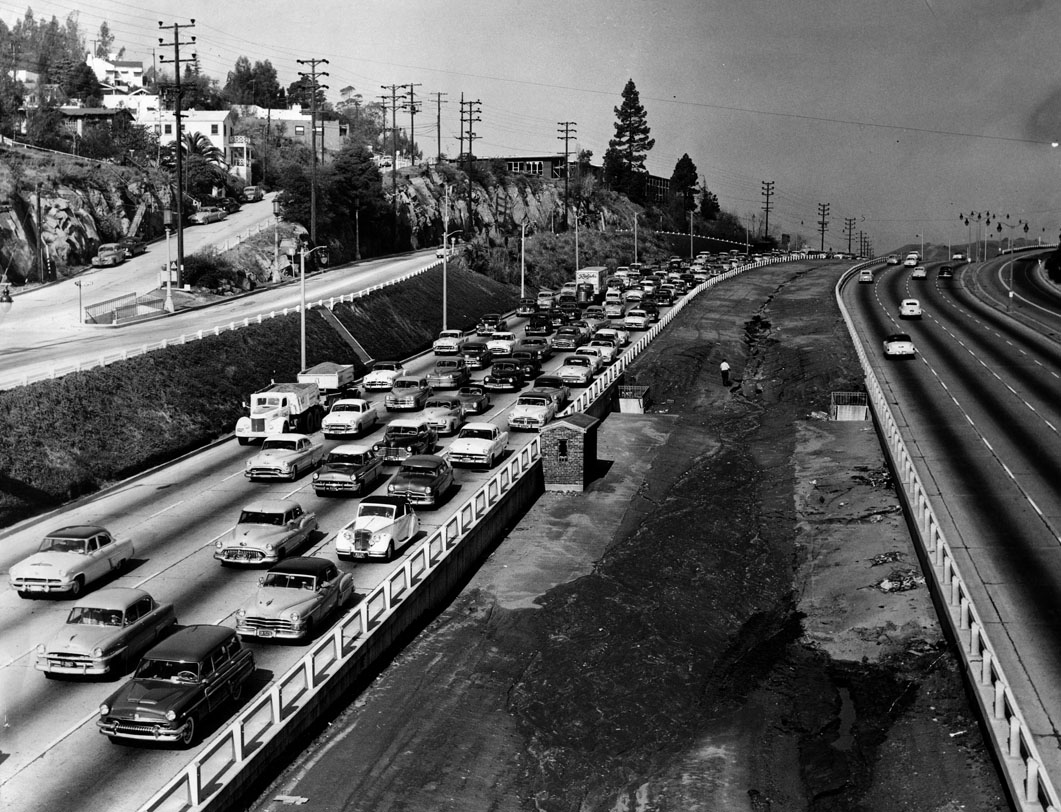 |
|
| (1955)* - View looking north from Mulholland Drive bridge showing the Hollywood Freeway with center median stripped away of its rails that had been there since 1911. |
Historical Notes The removal was part of a larger trend of dismantling the Pacific Electric Railway system. The decision to remove the tracks aligned with the increasing dominance of automobile transportation and the expansion of the freeway system in Los Angeles. After the tracks were removed, the space in the median was repurposed to add additional lanes for vehicular traffic. |
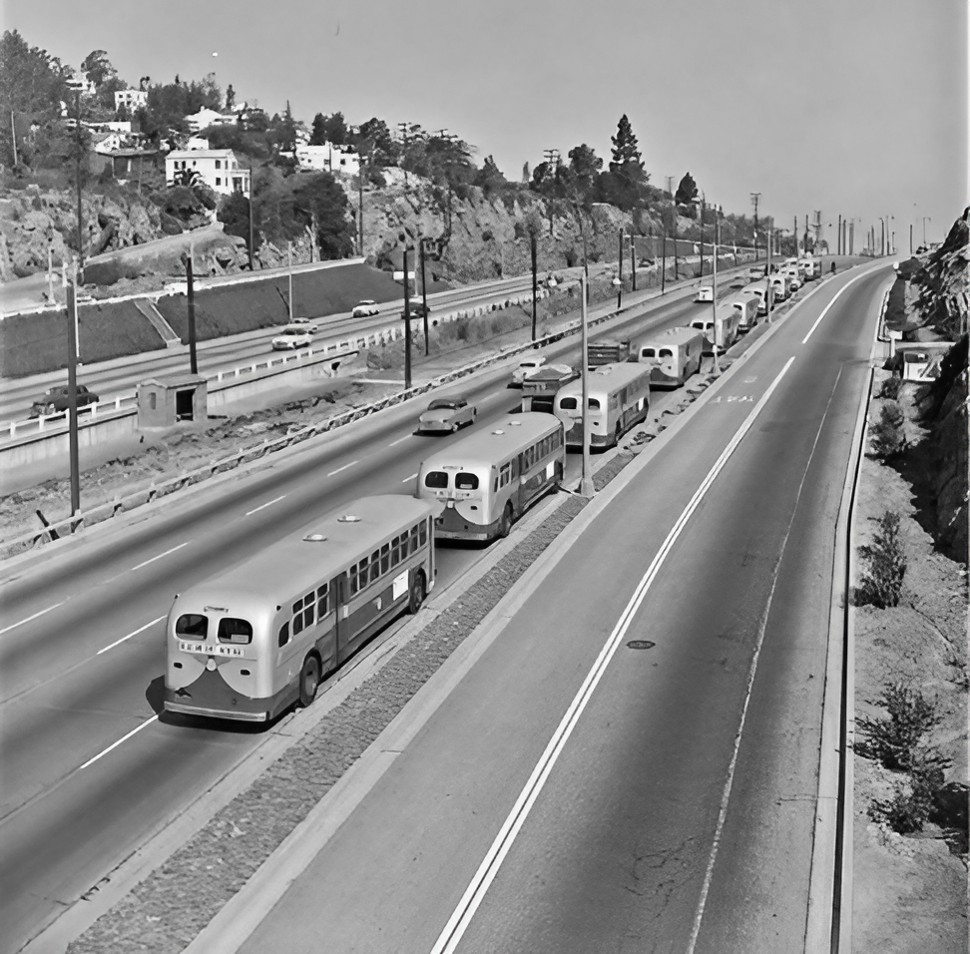 |
|
| (1950s)*^^ - View looking north through the Cahuenga Pass showing a line of buses which replaced the Pacific Electric Red Car. |
Historical Notes Operation of the Pacific Electric Red Car through the Cahuenga Pass to Owensmouth and San Fernando began in 1911 and was terminated in 1938; thereafter the terminus was at Van Nuys Boulevard and North Sherman Way. On December 28, 1952, busses over the Hollywood Freeway replaced all rail service to the San Fernando Valley on this line. |
Then and Now
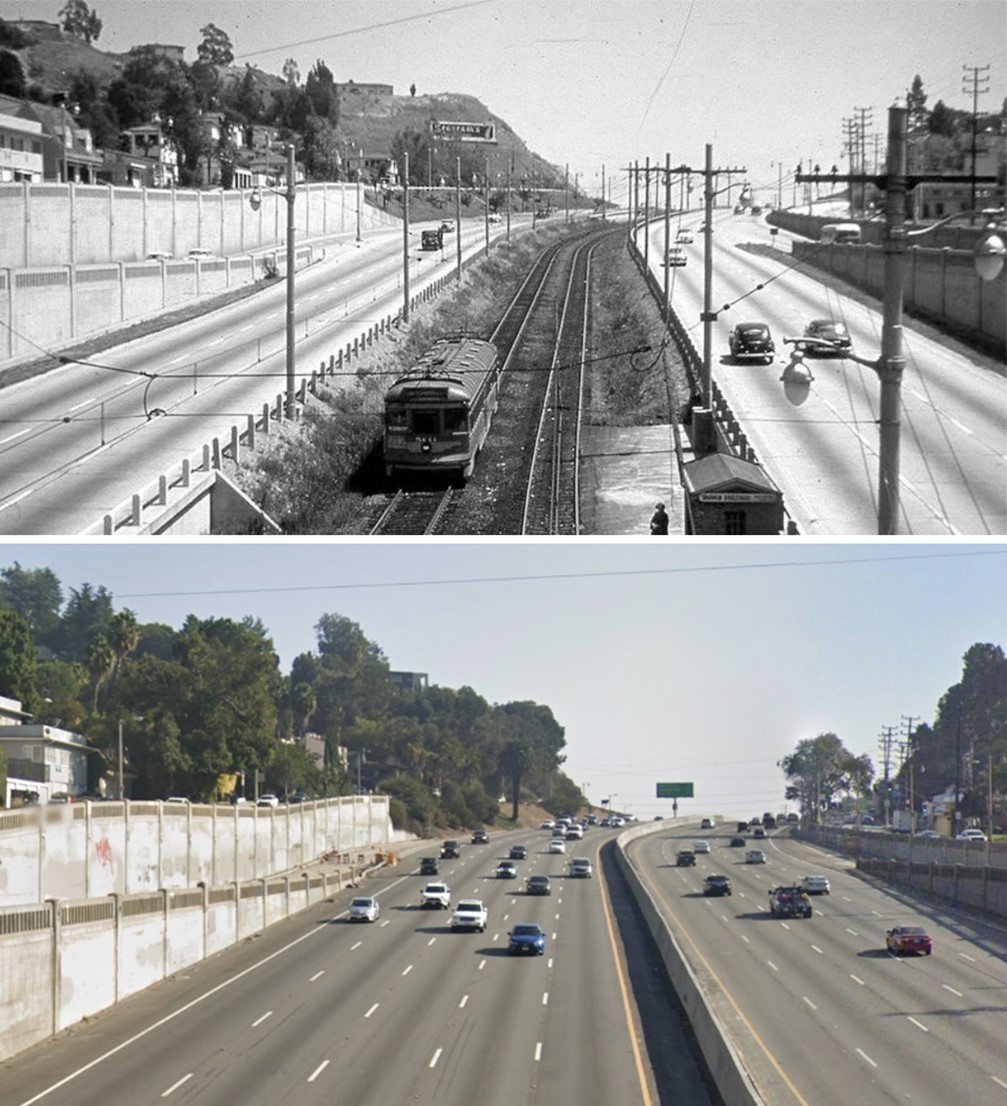 |
|
| (1948 vs. 2021)* - Looking southeast from the top of Barham Bridge in Cahuenga Pass. 1952 was the last year Pacific Electric Railway trolleys ran down the center of the "Cahuenga Pass Freeway". Photo comparison by Jack Feldman. |
* * * * * |
Cahuenga and Lankershim
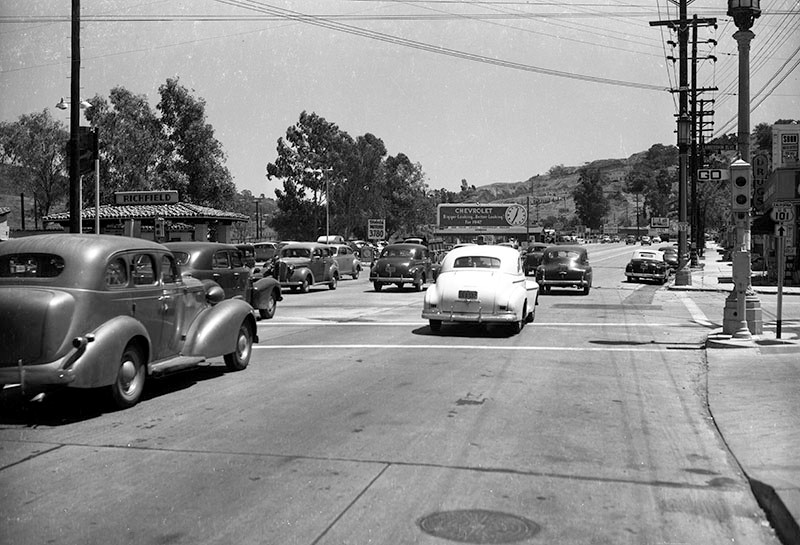 |
|
| (1947)* - Looking southeast down Cahuenga Boulevard, from just west of where it crosses Lankershim Boulevard (center). Seen, from left to right, are a Richfield service station, Dieterich Motors used car lot, a Foster and Kleiser billboard advertising 1947 Chevrolet automobiles, homes up in the hills, the Tasty Nook Cafe, and various other businesses. Photograph dated August 1, 1947. |
Historical Notes Ventura Boulevard turns into Cahuenga Boulevard east of Lankershim. |
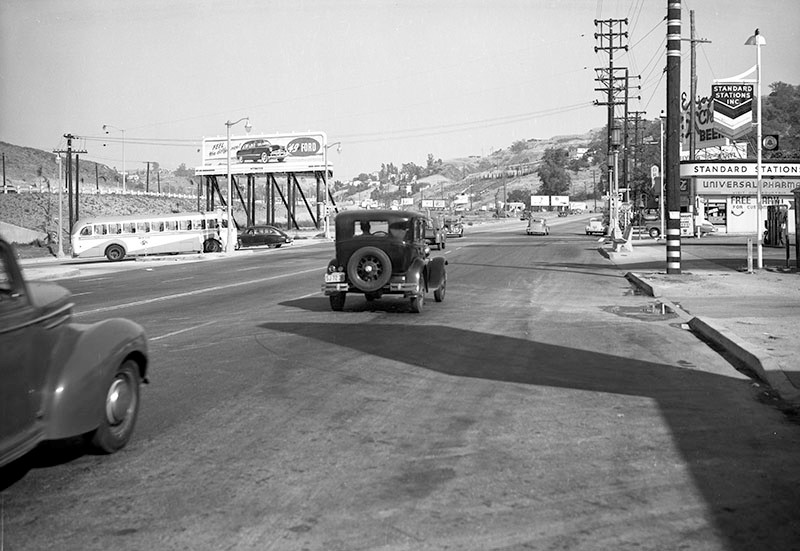 |
|
| (1949)* – View looking southeast down Cahuenga Boulevard, from just west of where it crosses Lankershim Boulevard (center). Seen, from left to right are the Lankershim Bridge and Tunnel (only partially visible), a Foster and Kleiser billboard advertising the 1949 Ford automobile (left), homes up in the hills, a Rexall drugstore and a Standard oil service station. Photograph dated June 23, 1949. |
Historical Notes The bridge/tunnel was built in 1948 as part of the Cahuenga Freeway; it is now known as the Lankershim/101 Freeway Bridge and Tunnel. The corner where the billboard is seen (left of center) was named Yitzhak Rabin Square in 1995 in honor of the slain Israeli Prime Minister. |
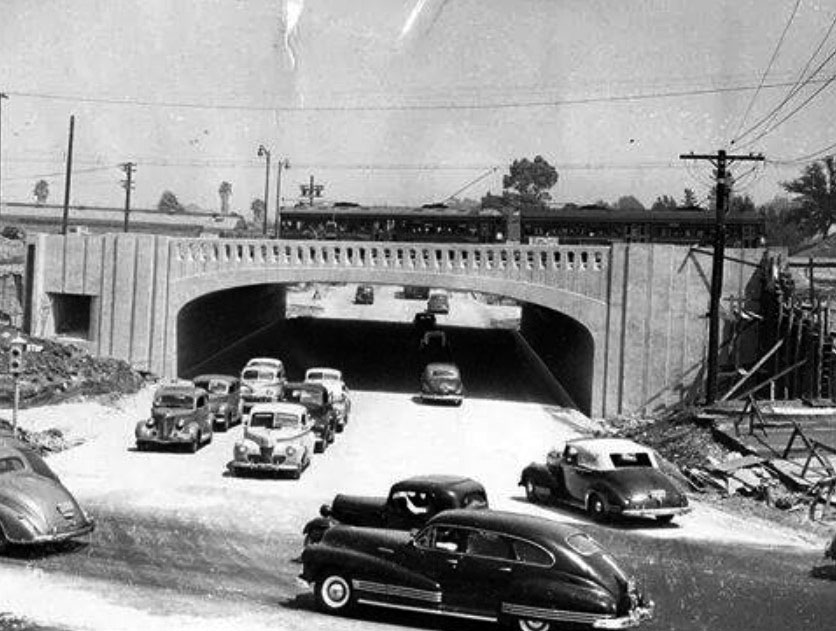 |
|
| (1952)*^*# – View looking north on Lankershim Boulevard at Cahuenga Boulevard showing the freeway underpass built in 1948. Two Pacific Electric Red Cars are passing each other above. |
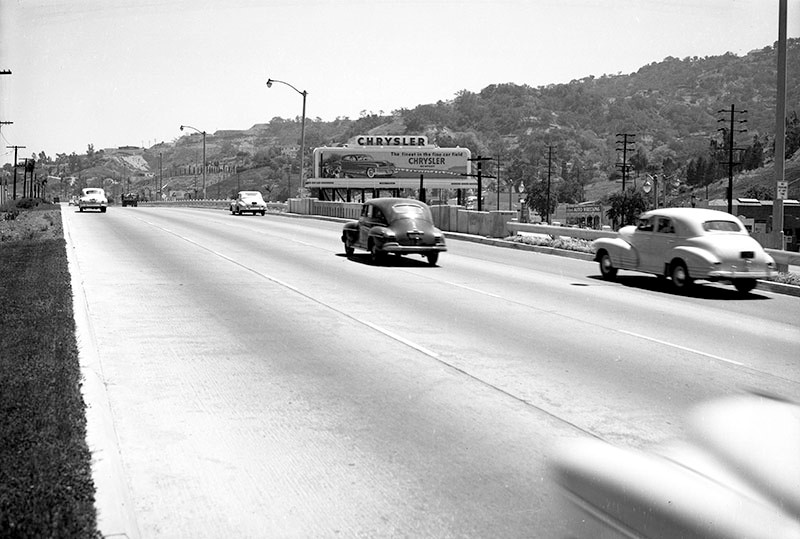 |
|
| (1950)* - Cars travel south down the Cahuenga Pass Freeway over the Lankershim Bridge and Tunnel, just north of where Cahuenga and Ventura boulevards meet in Studio City. |
* * * * * |
Movie Scenes in Cahuenga Pass
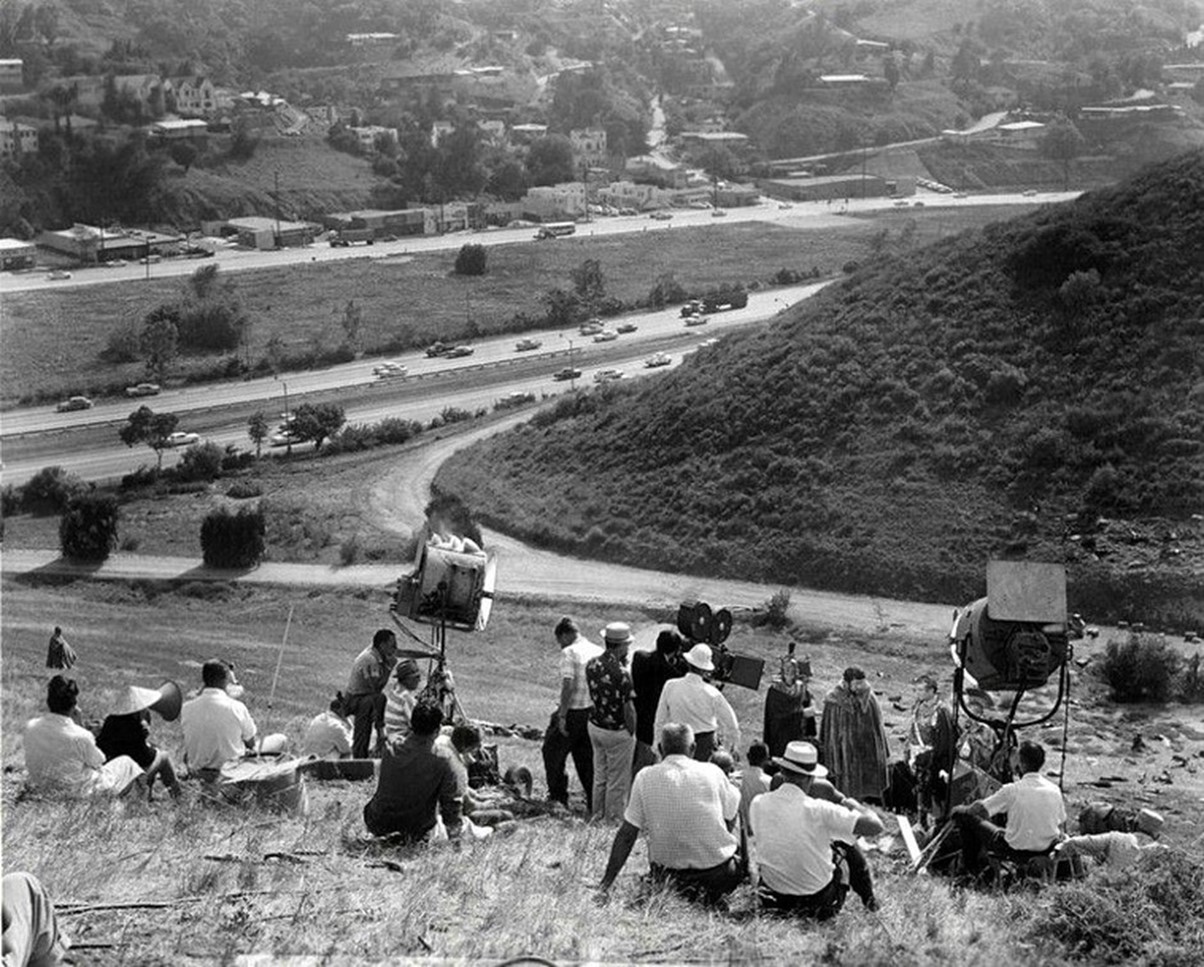 |
|
| (1959)* – View of the filming of 'Spartacus' in Cahuenga Pass, with the Hollywood Freeway (US-101) in the background. The location is on the hills above what is now Hotel Drive, on the site of what is today a Universal Studios parking lot. Photo by J.R. Eyerman for LIFE. |
Historical Notes Photo caption from the Los Angeles Evening News reads: ‘While the busy Hollywood Freeway remains out of the camera’s view, it serves as a contrasting backdrop to the scene from Bryna Productions’ Spartacus—a 74 B.C. setting outside the Gates of Rome. The southern edge of Universal-International Studios borders the freeway, where many travelers can glimpse the movie being filmed. Peter Ustinov, wearing a full-length sheepskin coat, is shown alongside Sir Laurence Olivier, positioned to his right.’ In 1959, Stanley Kubrick filmed scenes for the epic historical drama "Spartacus" in the Cahuenga Pass area of Los Angeles, with the Hollywood Freeway (US-101) serving as a nearby backdrop. The location was strategically selected for its suitable hillside terrain and its proximity to Universal Studios, being just a short drive away. The filming site was likely situated near what is now Hotel Drive, north of Universal Studios Boulevard. During the production, the area offered a unique setting where movie production intersected with everyday urban life, with travelers on the freeway potentially catching glimpses of the historical film being created. |
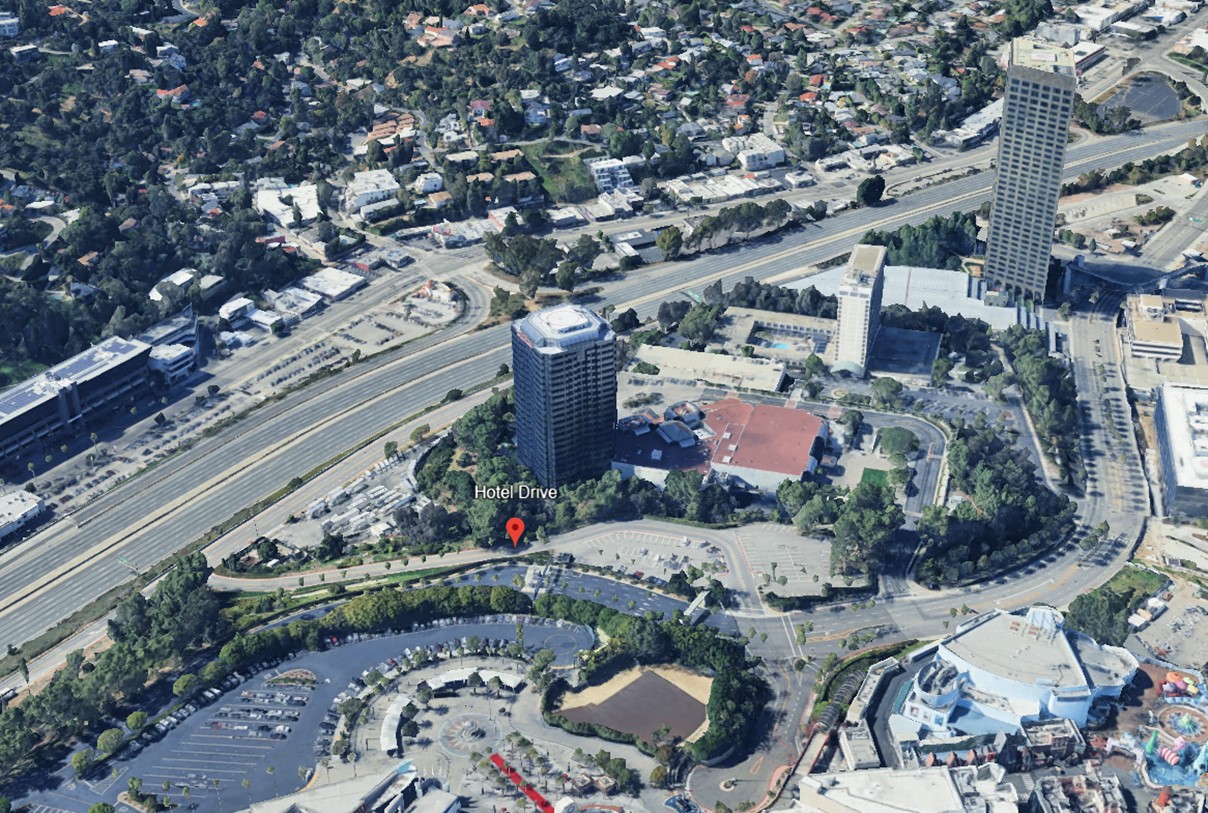 |
|
| (2023)* – Google Earth view looking southwest from above Hotel Drive and Universal Studios, showing the location of the former 'Spartacus' scene, now a parking lot. |
Historical Notes The rugged terrain of Cahuenga Pass, which connects the Hollywood area with the San Fernando Valley, was used for several outdoor sequences in films like 'Spartacus', particularly those involving large-scale battle scenes. The area’s natural features, including its rocky hills and open spaces, were well-suited for the grand scale of the film’s epic gladiatorial and military sequences. Today, Cahuenga Pass is heavily developed, especially with the expansion of Universal Studios, but its historical use as a filming location remains a notable part of Hollywood’s film legacy, contributing to Spartacus and many other films shot in the area over the decades. |
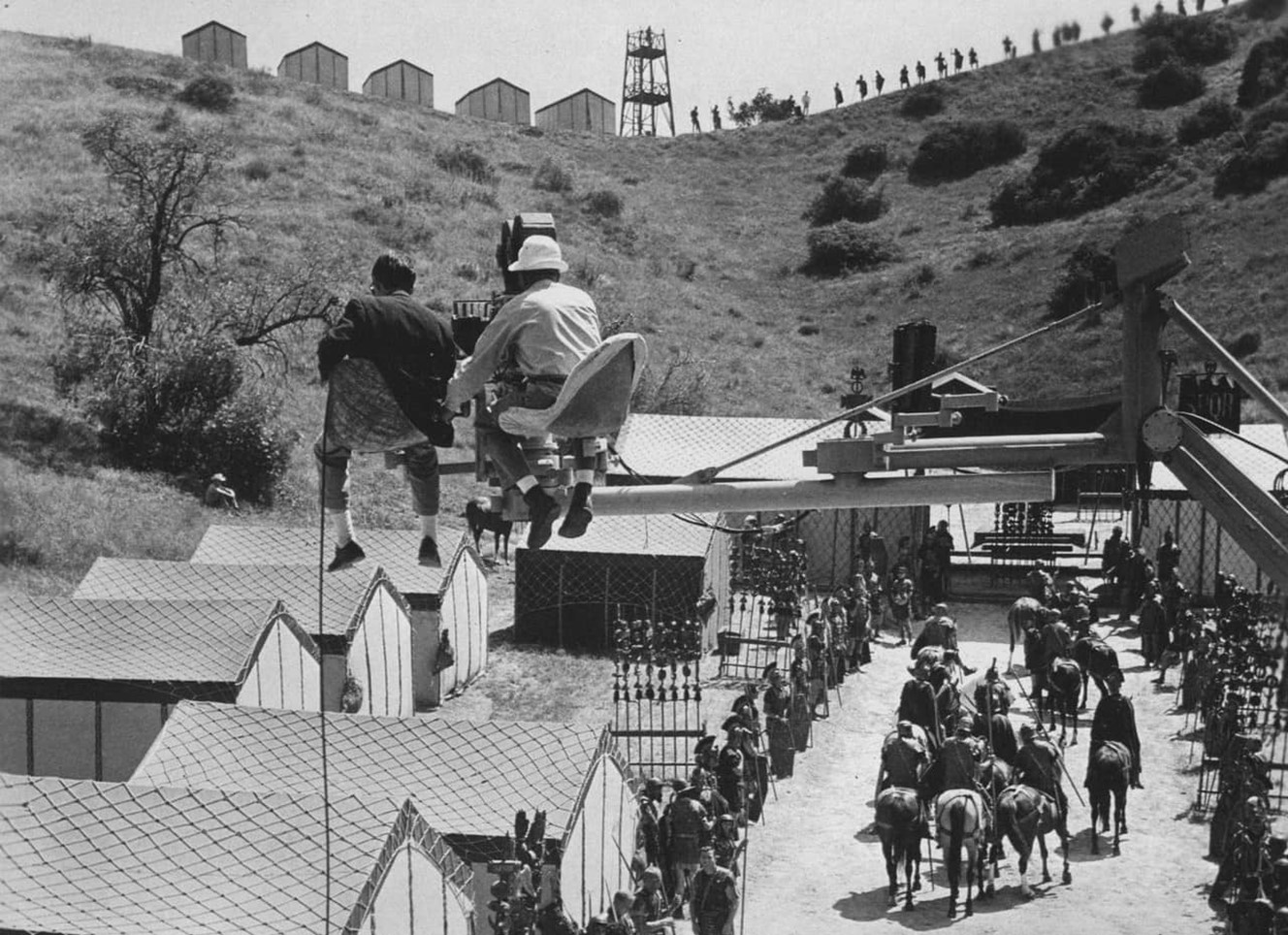 |
|
| (1959)* – Filming the Spartacus Roman fortress scene from above the Hollywood Freeway in Cahuenga Pass, toward a hill that today is a parking lot at Universal Studios. Photo by J.R. Eyerman for LIFE. |
Historical Notes 'Spartacus' is renowned for its exceptional cinematography and spectacular battle scenes, some of which were filmed in the local mountains near Hollywood, including the Cahuenga Pass. The film's cinematographer, Russell Metty, employed innovative techniques to capture the epic scale of the production. Using the 35 mm Super 70 Technirama format, which was later blown up to 70 mm film, Kubrick and Metty achieved ultra-high definition and captured vast panoramic scenes. This process allowed for breathtaking visuals, particularly evident in the battle sequences. While the major battle scenes were filmed on a vast plain outside Madrid with about 8,000 trained soldiers from the Spanish infantry, some local filming took place in the hills above Los Angeles' Cahuenga Pass. The film's visual impact was particularly striking for audiences who experienced it in rare Super Technirama 70 prints, which showcased the impressive cinematography in 70mm with six-track sound. Metty's work on "Spartacus" was so impressive that he won the Academy Award for Best Color Cinematography, despite reported conflicts with Kubrick during filming. 'Spartacus' went on to win four Academy Awards, including Best Supporting Actor for Peter Ustinov, Best Art Direction, and Best Costume Design. |
* * * * * |
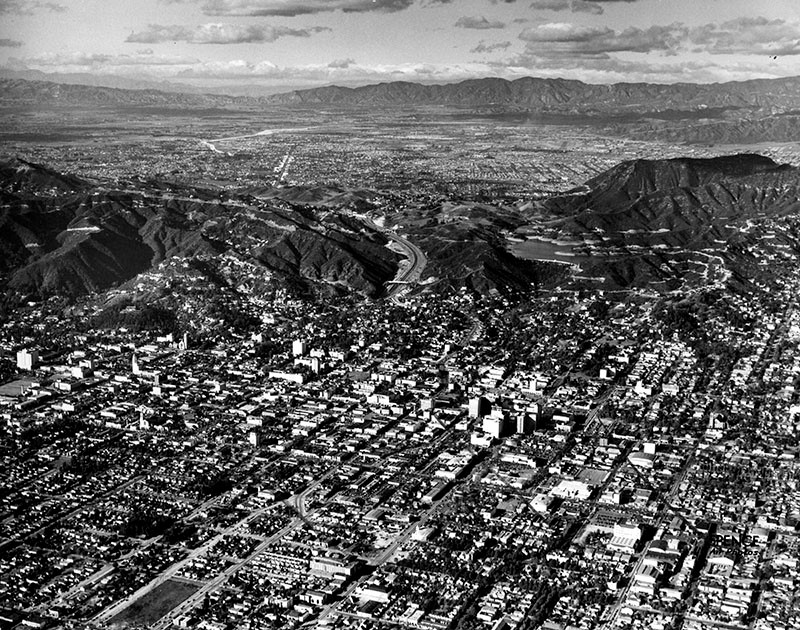 |
|
| (ca. 1951)* - Aerial view of Hollywood, north of Sunset between Highland and Gower before the second section of the Hollywood Freeway was built (1954). The Hollywood Reservoir (middle right) is in the hills above Hollywood. There is a clear view of San Fernando Valley in the background. |
 |
|
| (ca. 1951)* - Bird's eye view of the Hollywood Freeway through the Cahuenga Pass, looking towards the Valley. The Cahuenga Tunnel under Highland Avenue can be seen at lower center-left. The "Muse of Music" Statue at the entrance to the Hollywood Bowl is visible just to the left of the tunnel as is part of the Hollywood Bowl shell (center-left). |
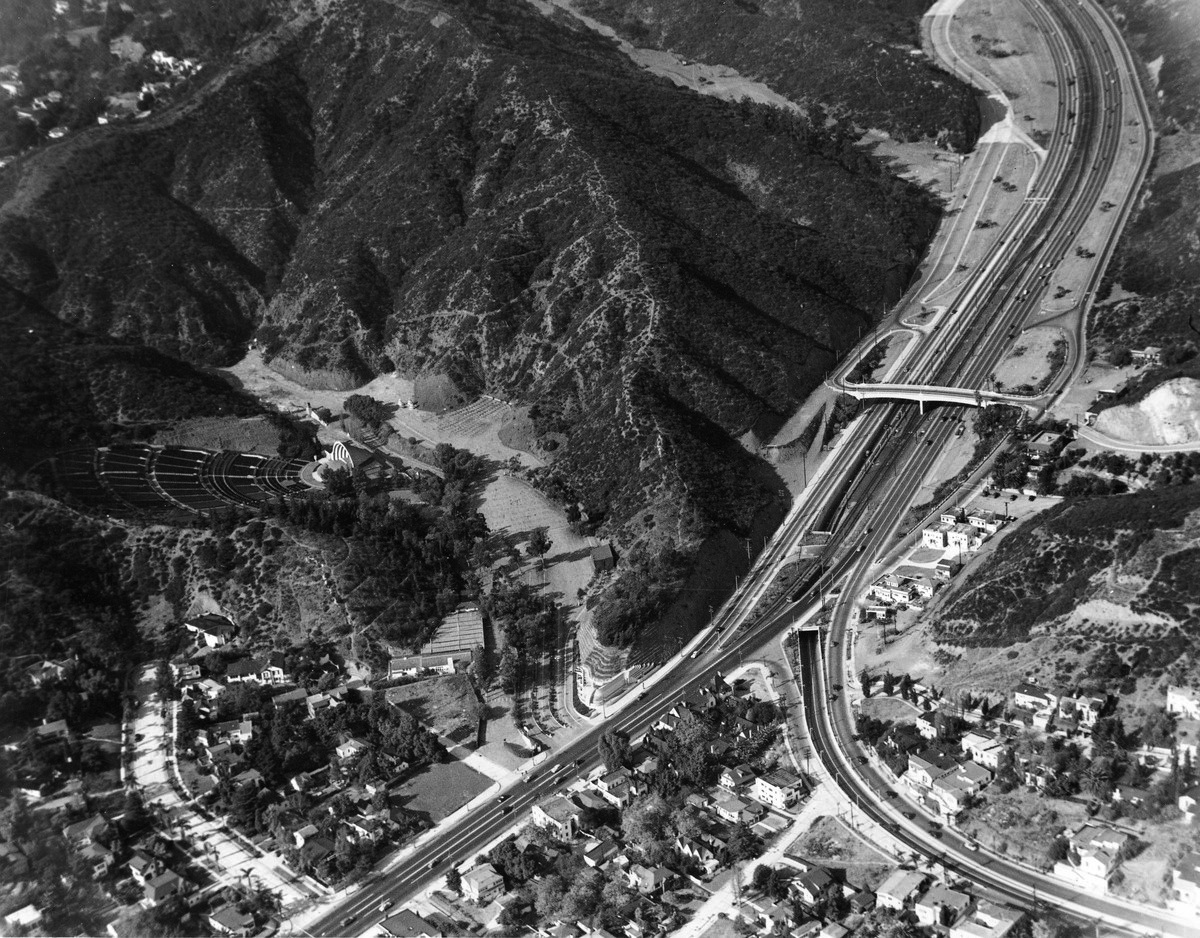 |
|
| (ca. 1952)*** – Aerial view showing the end of the Cahuenga Pass Freeway (Hollywood Freeway) near the Hollywood Bowl (left-center). The freeway would soon be extended all the way to Downtaown LA. |
Hollywood Freeway Extension (Cahuenga Pass to Downtown LA)
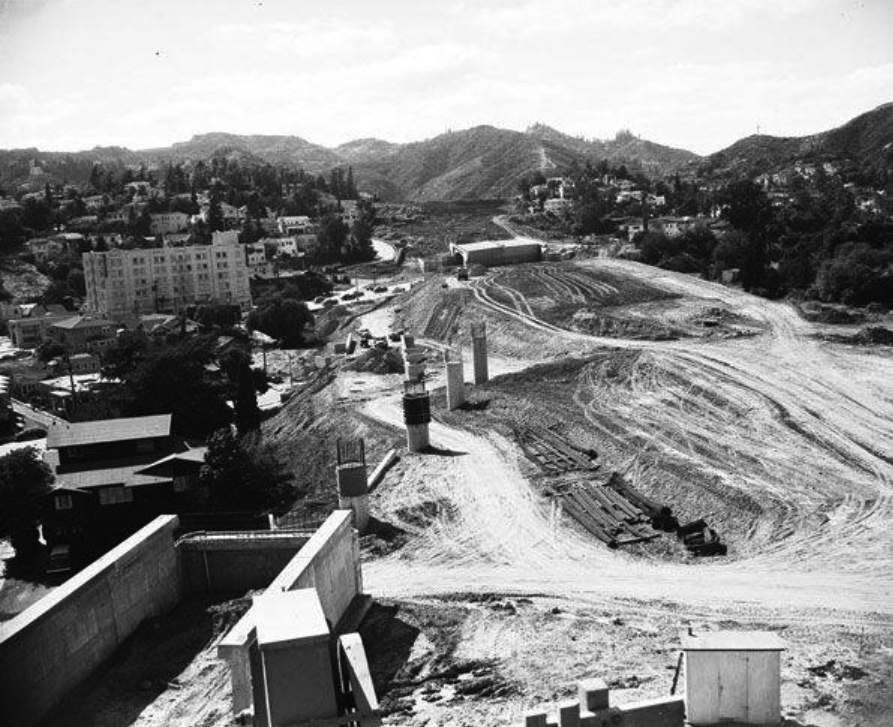 |
|
| (1952)* - This scene is just two blocks north of the famous intersection of Hollywood and Vine, the "Heart of Hollywood." Steel reinforced columns jutting from the hillside will soon support new, wide ribbons of concrete approaching Cahuenga Boulevard. Freeway will be a boon to Valley motorists who use Cahuenga Pass. |
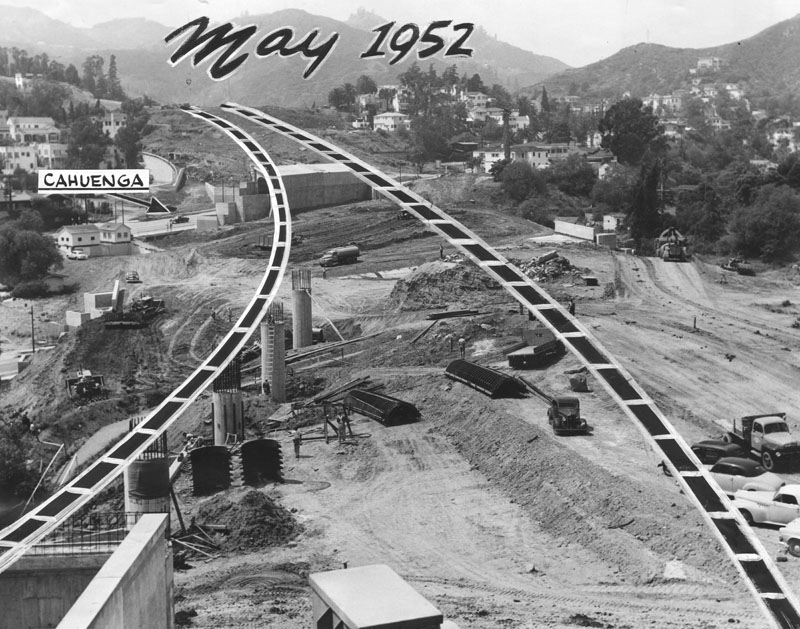 |
|
| (1952)* - View showing the proposed route of the Hollywood Freeway extension connecting Cahuenga Pass with downtown Los Angeles. The arrow points to Cahuenga Boulevard. |
 |
|
| (1953)* - View looking north showing the construction progress of the Hollywood Freeway through Cahuenga Pass with the Pilgrimage Bridge in the background. Highland Avenue is seen on the left where you can see the "Muse of Music" Statue at the entrance to the Hollywood Bowl. |
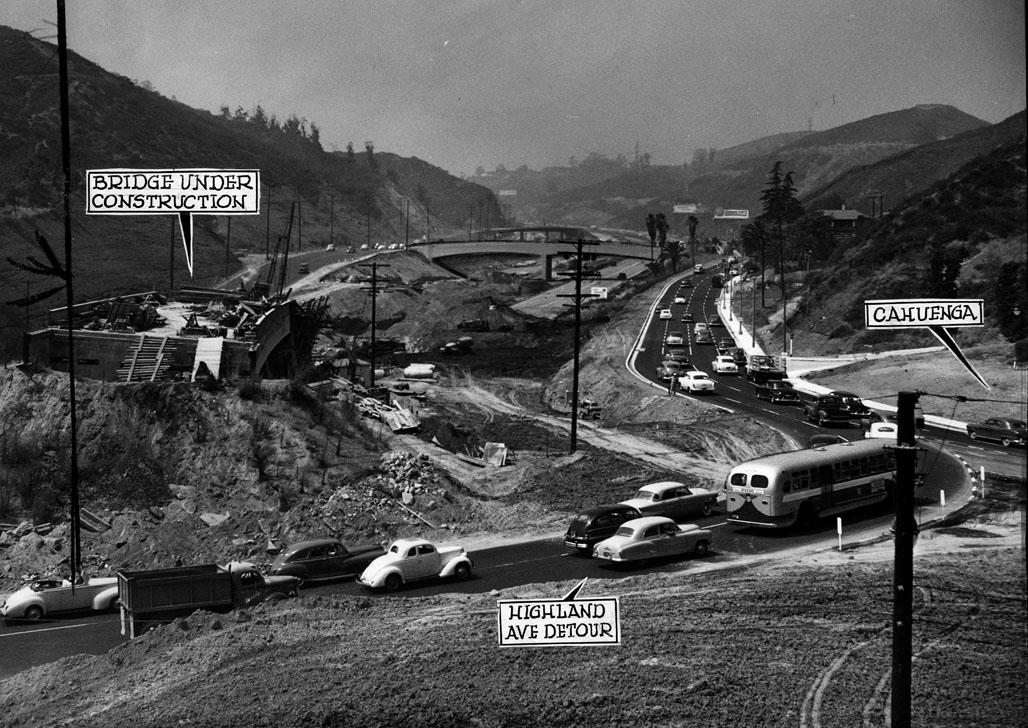 |
|
| (1953)* - View of Cahuenga Pass. All Highland Avenue detour traffic now pours into Cahuenga Boulevard while work continues on the northerly links of the Hollywood Freeway. The new link, of course, also discharges its travelers onto Cahuenga. |
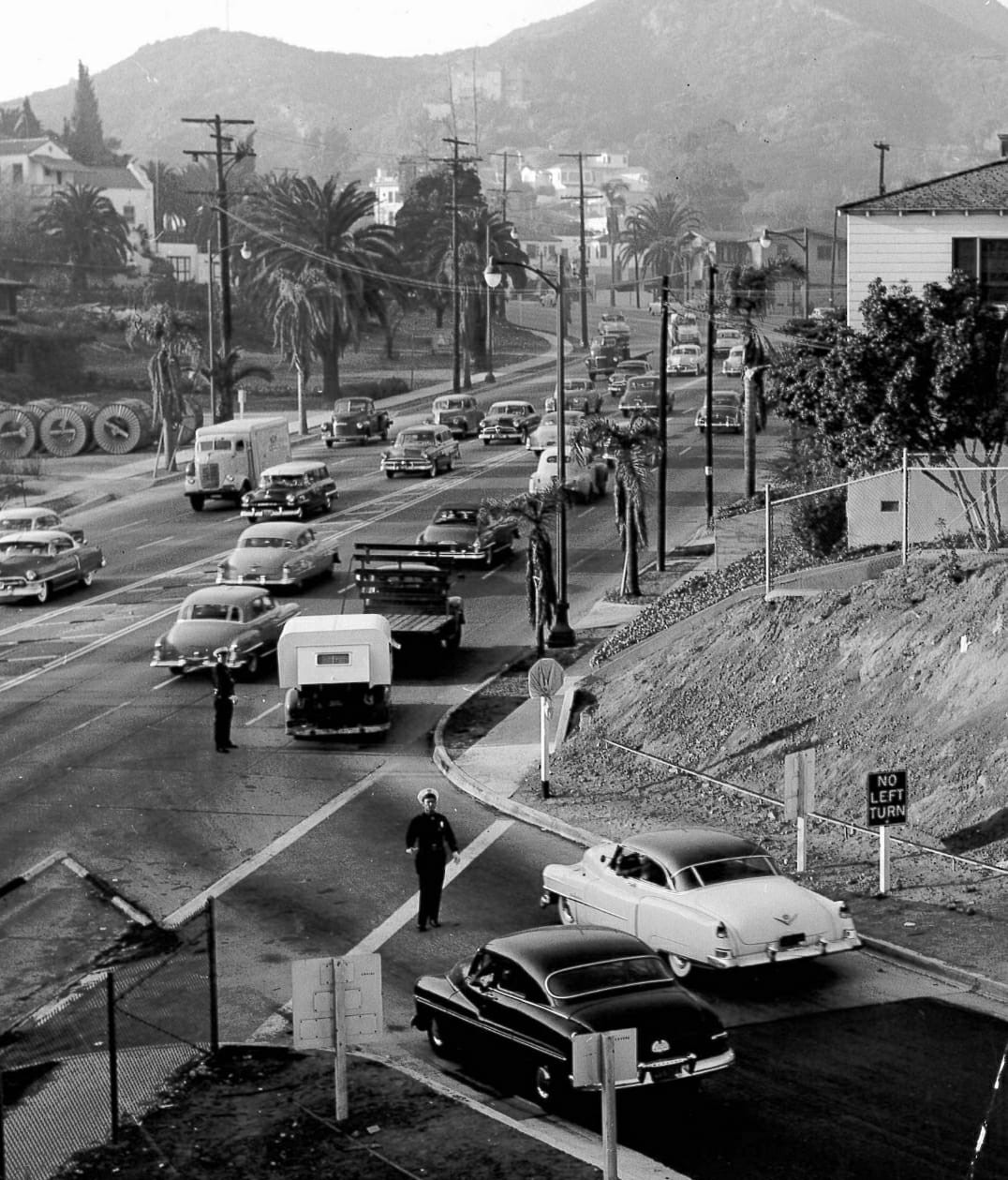 |
|
| (1953)* - Looking north over northbound Hollywood Fwy (US-101) off-ramp at Cahuenga Blvd. Traffic control officers direct traffic while stop sign remains shrouded. Photo date: 10-7-53 |
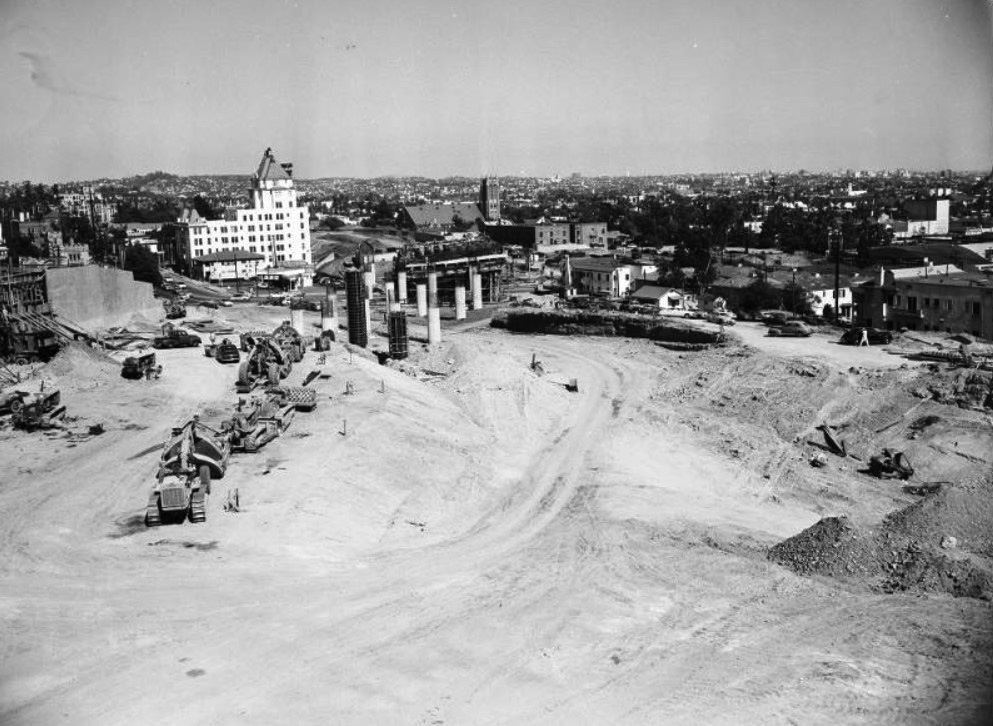 |
|
| (1952)* - Looking southeast towards a new bridge over Cahuenga Boulevard during the construction of the Hollywood Freeway with the Hollywood Tower in the background. |
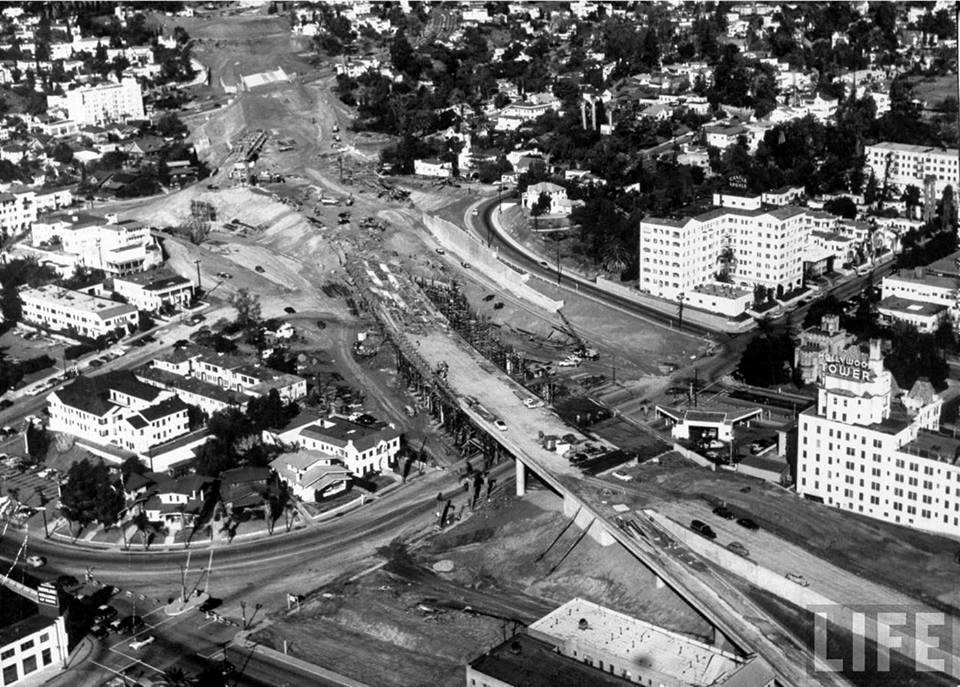 |
|
| (1953)^*^# – View showing the construction of the 101 Freeway through Hollywood at Argyle Avenue connecting Cahuenga Pass with downtown Los Angeles. You can see the Castle Argyle and the Hollywood Tower (lower-right) among the buildings. Source: Life Magazine |
 |
|
| (1953)* - New hillside roads have been constructed as detours for traffic from the Valley to Hollywood while construction of the Cahuenga Pass section is in progress. Road at left is the present route for the northbound traffic. Inbound traffic uses the detour shown at right. This picture, looking south, was taken from Pilgrimage Bridge. When the Cahuenga Pass section is completed, traffic from the city will flow directly into Cahuenga Freeway. Herald Examinder, December 26, 1953. |
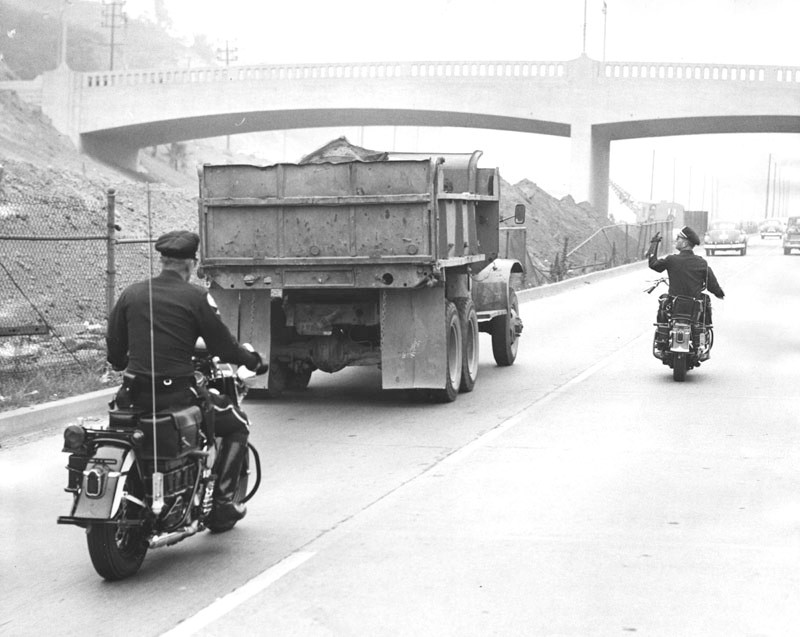 |
|
| (1953)* – Herald Examiner Photo caption reads: In a freeway safety campaign, motorcycle officers Lloyd Asdale (left) and Harry Smalley find a slow-moving truck in the fast lane in Cahuenga Pass. The officers signals the driver over to the right. Fourteen slow drivers in fast lanes were among 95 drivers nabbed in the first eight hours. |
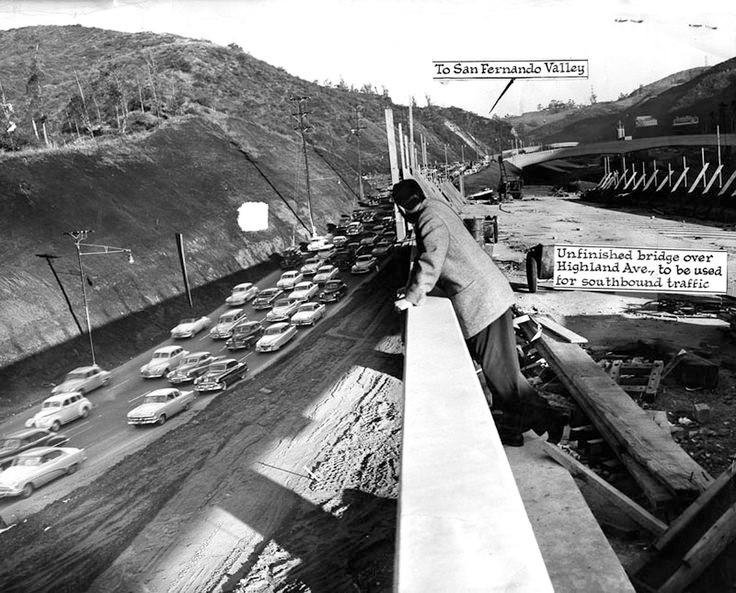 |
|
| (1954)* - The 101 appears to be open, but the bridge over Highland Avenue is still under construction in January 1954. |
 |
|
| (1954)* - Newly reconstructed NB Cahuenga Pkwy (now Hollywood Fwy US-101) at Highland Ave; view SE from Pilgrimage Bridge. |
Historical Notes Southbound US-101 structure (right background) replaced old two-lane tunnel that was the scene of many rear end accidents. Pacific Electric tracks in median (at right) were removed in 1953. |
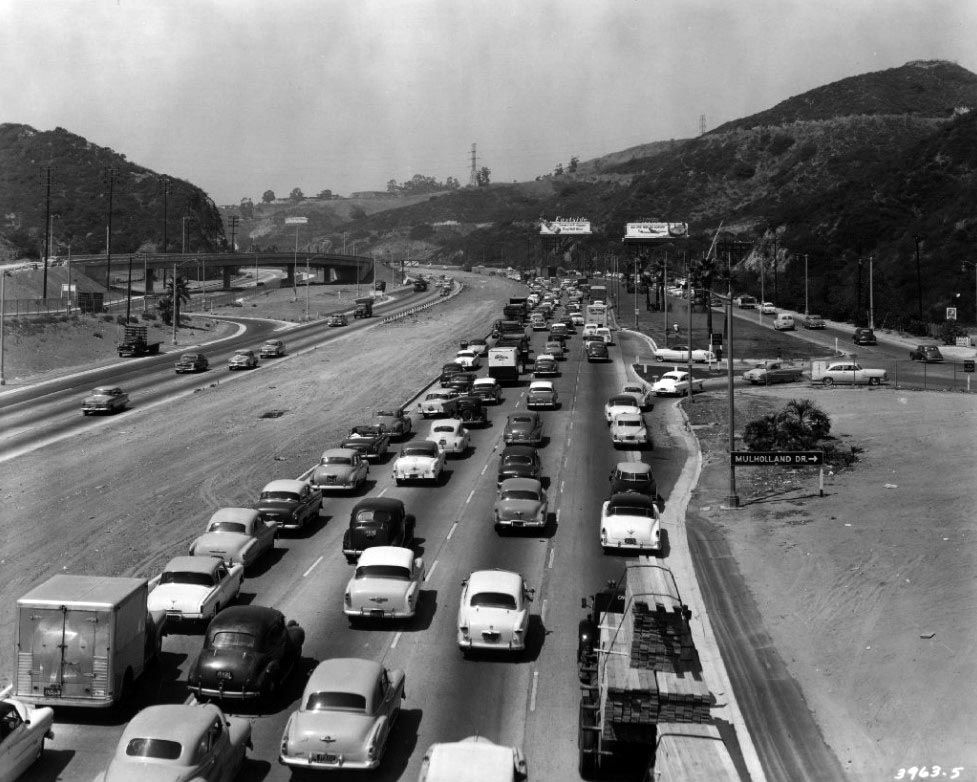 |
|
| (1954)* - View of US 101 northbound from the Pilgrimage Bridge in Cahuenga Pass. Mulholland Drive exit is on the right. |
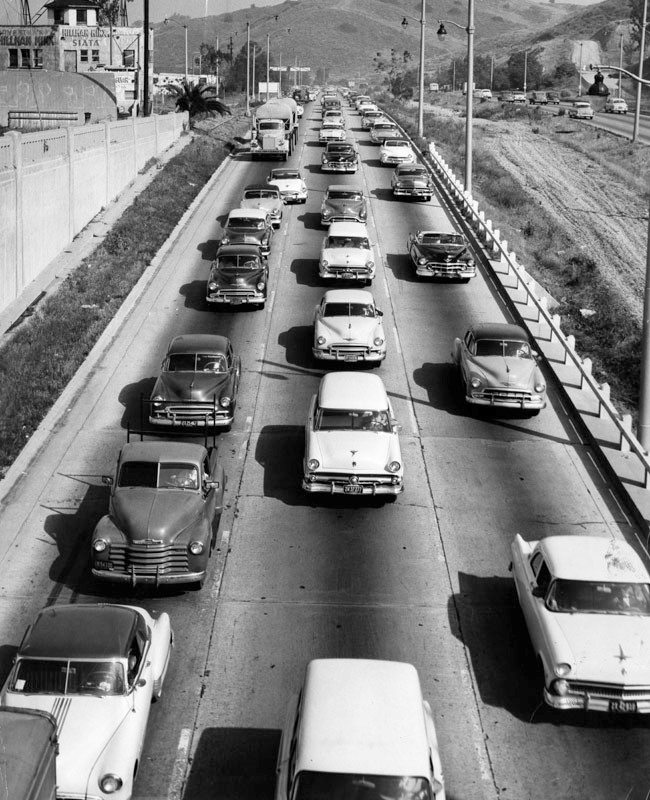 |
|
| (1955)* - Photograph caption dated May 17, 1955 reads, "End of freeway tieup. Autos begin creeping down inbound lane of Hollywood Freeway as two-hour morning traffic jam slowly disperses. Broken down truck caused tieup, backed up commuter cars on all main arteries leading from Valley." |
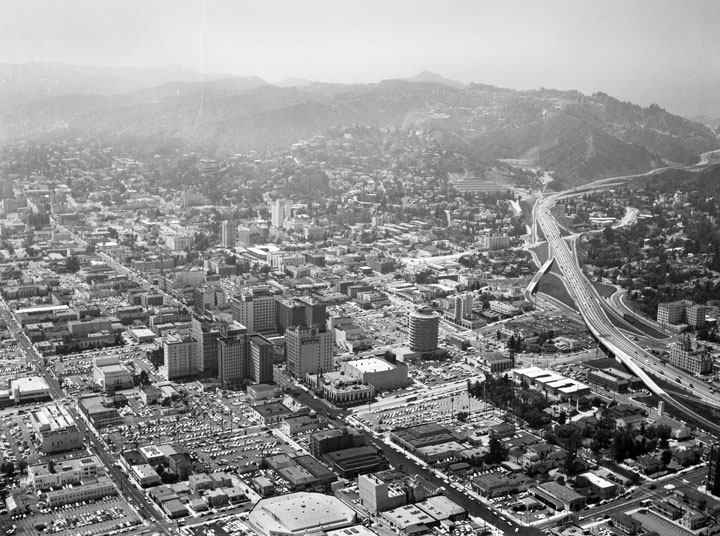 |
|
| (1956)* - Aerial view showing the new Hollywood (101) Freeway connecting the San Fernando Valley to downtown Los Angeles. Cahuenga Pass is at upper-right. The Hollywood business district is seen at center. Clcik HERE to see more Early Views of Hollywood. |
Historical Notes The second section of the Hollywood Freeway that stretched from the San Fernando Valley to Downtown Los Angeles opened on April 16, 1954 at a cost of $55 million. |
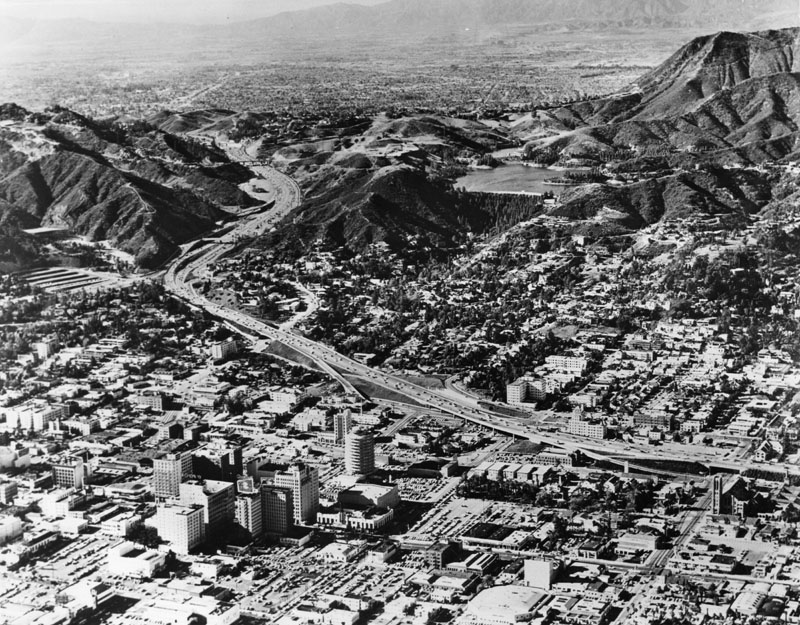 |
|
| (ca. 1960s)* - Aerial view of Hollywood and its surrounding areas after the second segment of the Hollywood Freeway was completed (1954). The Hollywood Reservoir and Mulholland Dam an are seen in the hills above Hollywood (upper center-right). Capitol Records Building is in the middle foreground of this photo (it is the cylindrical shaped building whose shape is devised from the vision of a stack of records). |
Before and After
 |
|
 |
|
| (1951)* vs. (1960s)* - Aerial view showing Cahuenga Pass before and after Hollywood Freeway extension. |
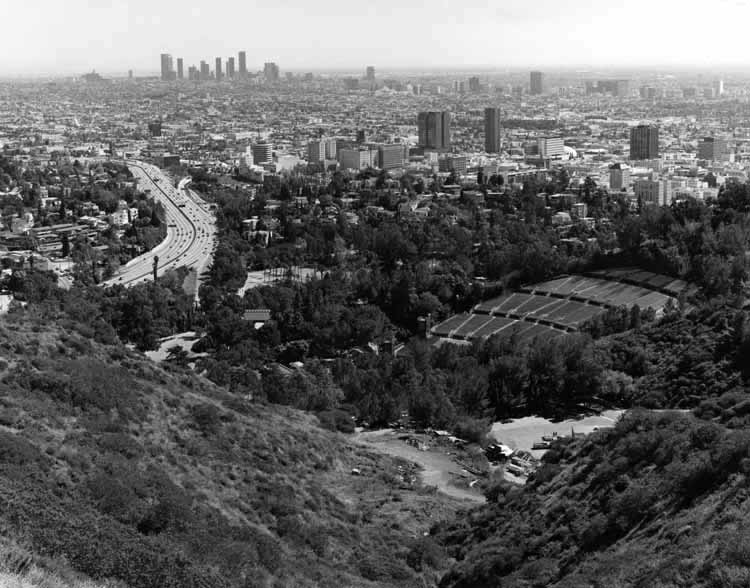 |
|
| (1989)^^^ - View of Hollywood from Mulholland Drive. The Hollywood Bowl can be seen in the foreground and the Hollywood Freeway (at left) connects Cahuenga Pass with downtown Los Angeles (background) |
Cahuenga Pass Then and Now
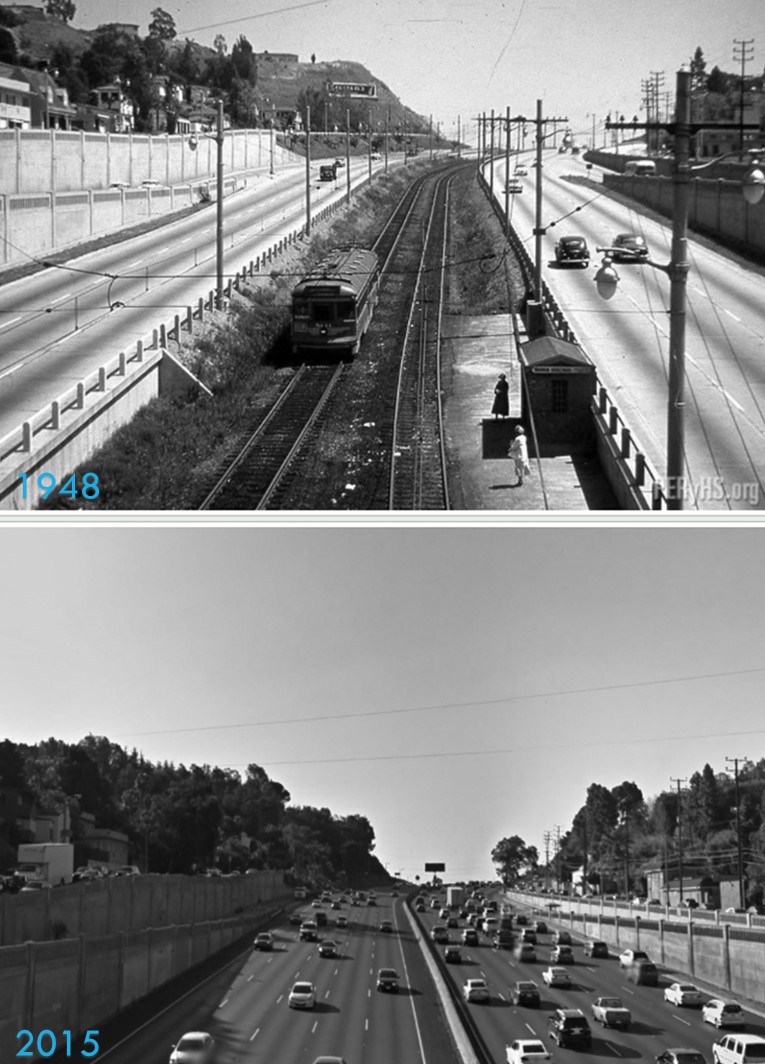 |
|
| (1948)* - (2015)* - View looking southeast from the top of Barham Bridge in Caheunga Pass. |
 |
|
| (1950)* – A timed picture taken at night when the lights of the cars all run together into strings. Lighted billboards can be seen near the curve in throads. |
* * * * * |
Cahunega Pass on a Rainy Day
 |
|
| (1952)* - Morning rush-hour traffic moves southeast toward downtown Los Angeles as steady rain slows the flow of cars through Cahuenga Pass. |
Historical Notes Rain has always had a noticeable impact on traffic conditions in Cahuenga Pass. Even light storms could reduce visibility, slick the pavement, and quickly create bottlenecks along this narrow corridor linking Hollywood with the San Fernando Valley. In the early 1950s—before modern drainage improvements and ramp redesigns—rain often caused traffic to crawl during peak hours, turning the pass into one of the region’s most predictable choke points. Wet weather amplified the pass’s natural constraints—tight curves, steep grades, and heavy commuter volume—frequently producing long backups and defensive driving conditions. |
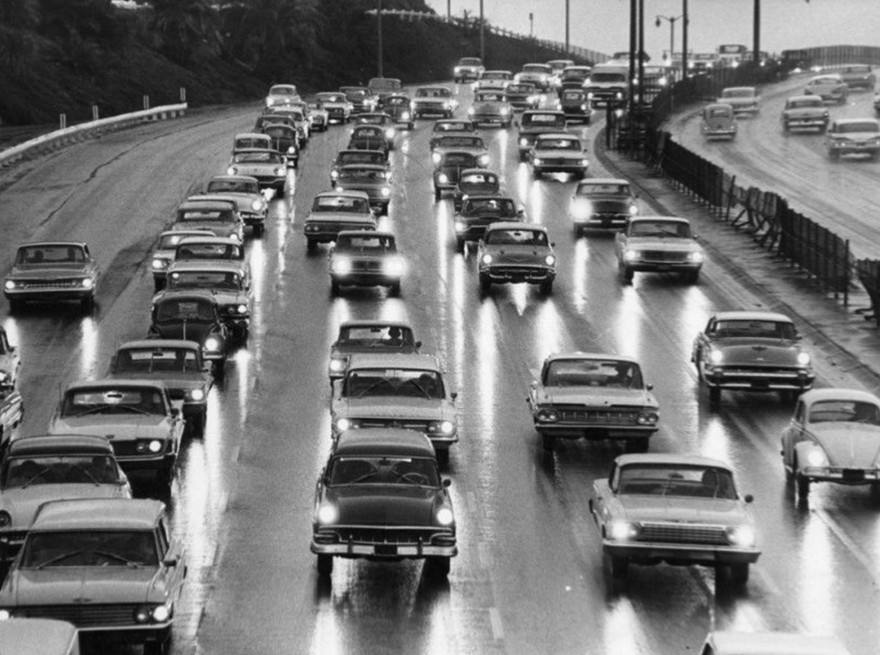 |
|
| (1964)* - Photo caption dated November 9, 1964 reads: “Cars were jammed on the freeway this morning because of the long-awaited rain, as cautious work-bound drivers moved toward Los Angeles. Photo shows cars in Cahuenga Pass on the Hollywood Freeway driving bumper-to-bumper. Police reported a few fender-bending accidents.” |
Historical Notes Cahuenga Pass consistently demonstrated its vulnerability to weather-related slowdowns. During seasonal rainstorms, motorists tended to over-compensate with reduced speeds, creating miles of stop-and-go conditions along the Hollywood Freeway. Police routinely reported minor fender-benders during these events—not due to high-speed accidents, but from the sheer congestion and cautious braking typical of rainy-day commuting in the pass. By the mid-1960s, even brief showers were enough to turn the freeway into a moving parking lot, underscoring how rain remained one of the pass’s most persistent operational challenges. |
* * * * * |
.jpg) |
|
| (ca. 1964)* - Daylight view of Cahuenga Pass showing dual-arm lamposts. A 1964 Valiant is seen at left. |
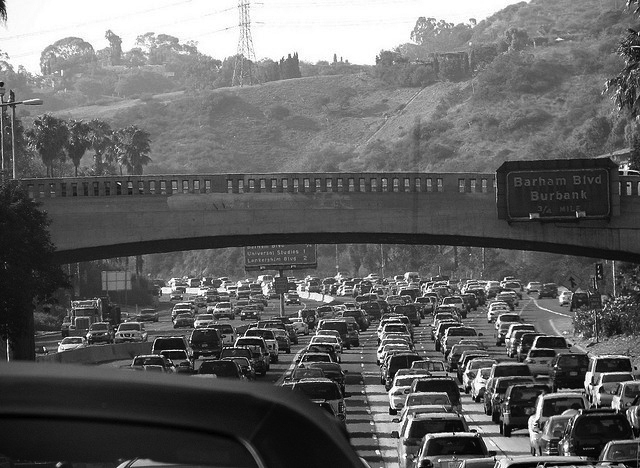 |
|
| (ca. 2005)* - Cahuenga Pass as it appears today. |
* * * * * |
Please Support Our CauseWater and Power Associates, Inc. is a non-profit, public service organization dedicated to preserving historical records and photos. Your generosity allows us to continue to disseminate knowledge of the rich and diverse multicultural history of the greater Los Angeles area; to serve as a resource of historical information; and to assist in the preservation of the city's historic records.
|
More Historical Early Views
Newest Additions
Early LA Buildings and City Views
History of Water and Electricity in Los Angeles
* * * * * |
References and Credits
* LA Public Library Image Archive
^ CSUN Oviatt Library Digital Archives
*^ Wikipedia: Cahuenga Pass; Moses Sherman; John Anson Ford Theatre
#^WhitleyHeights.org: Aerial of Cahuenga; Whitley Heights Aerial
#+Facebook.com: Los Angeles Railroad Heritage Foundation
^**Huntington Digital Library Archive
^x^Facebook.com: Photos of Los Angeles
**^Noirish Los Angeles - forum.skyscraperpage.com
**#The California History Room, California State Library: William Reagh
*^^Metro Jacksonville: Cahuenga Pass
^*^KCET: L.A.'s First Freeways; When Cahuenga Pass Was Rustic
^^*Pacific Electric San Fernando Valley Line - ERHA.org
^^^California State Library Image Archive
*^#LosAngelesPast.com: Cahuenga Pass
*#^Forum Skyscraperpage.com: Cahunega and Highland Intersection
#^^KCET: When the Cahuenga Pass Was Rustic; L.A.'s First Freeways
**^#LA Times Framework: Cahuenga Pass
*^#*Calisphere: University of California Image Archive
*^*#Facebook.com: Classic Hollywood-Los Angeles-SFV
#**#Facebook.com: Garden of Allah Novels, Martin Turnbull
#^^#The Pacific Electric Railway Historical Society (PERyHS)
^#^^Facebook.com: Vintage Los Angeles
^*^#Facebook.com - Bizarre Los Angeles
< Back
Menu
- Home
- Mission
- Museum
- Major Efforts
- Recent Newsletters
- Historical Op Ed Pieces
- Board Officers and Directors
- Mulholland/McCarthy Service Awards
- Positions on Owens Valley and the City of Los Angeles Issues
- Legislative Positions on
Water Issues
- Legislative Positions on
Energy Issues
- Membership
- Contact Us
- Search Index